PinotFile: 12.8 August 30, 2020
|
Drinking California Pinot Noir History from “Old Vine” Vineyards: A Bucket List
Ted Lemon, Littorai
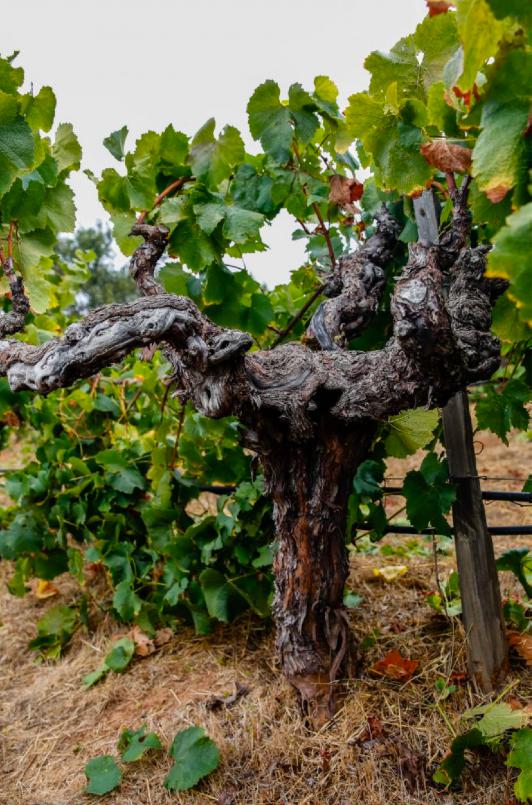
Although wine grapevines can potentially survive 50 to over 100 years of age, there are precious few old vine Pinot Noir vineyards in California that are still productive. Age is a valuable commodity in vineyards since the aged vine has more potential for reflecting the essence of a vineyard, or at least mirroring a unique character of the site. Beyond this dictum, there are a number of other generally accepted observations in the wine literature and opinions voiced by winemakers regarding whether vine age makes a difference in the quality of wines and how vine age affects viticultural and winemaking decisions:
Pinot Noir vineyards planted before 1980 were most often established with Martini clones and less frequently with the Pommard clone and Mount Eden and Swan selections, all of which originally came from Burgundy, France. There were not many options at the time and the perception of distinct clones of Pinot Noir was just coming into focus by the wine industry. Historic planting records for many vineyards planted prior to 1980 are not available so the exact source of the originally planted scion material is unknown. None of the old vine Pinot Noir vineyards included in this article was planted to Dijon clones since they were not introduced into California until the early 1990s. For more in-depth information on the heritage clones that were planted in Pinot Noir vineyards prior to 1980, refer to the section “Heritage Clones of Pinot Noir" in this issue. You may consider reading this section first for proper background intuition. The 1970s proved to be a fruitful time for vineyard plantings throughout California. It had become evident that Pinot Noir performed best in the cooler regions of California. The public was beginning to appreciate fine wine, Pinot Noir was grabbing the consumer's interest and a wine revolution of sorts was developing. Between 1964 and 1978, viticultural pioneers such as Uriel Nielson and Bill DeMattei planted wine grape varieties including Pinot Noir in Santa Barbara County’s Santa Maria Valley and by the late 1970s, growers had discovered that Santa Barbara County produced wonderful Pinot Noir. Richard Sanford and partner Michael Benedict planted the Sanford & Benedict Vineyard to Pinot Noir and Chardonnay located at the western end of the Santa Ynez Valley in 1970-1971. This was the first planting of Pinot Noir in what is now the Sta. Rita Hills AVA. Russian River Valley Pinot Noir was in its infancy in the late 1960s and 1970s. Joseph Swan planted Pinot Noir in the Vine Hill region using cuttings from Mount Eden and budwood from Burgundy in 1969. Joe Rochioli, Jr., was harvesting his early viable Pinot Noir crops from East Block and West Block plantings on Westside Road first established from 1968 to 1970. Tom Dehlinger was another Russian River Valley visionary who planted his first vines on his property on Vine Hills Road in the spring of 1975. The original 4 acres of Pinot Noir consisted of Pommard and Martini clones with a smaller selection of cuttings from Joe Swan’s vineyard. The Pellegrini family planted the Olivet Lane Vineyard in 1972 and Forrest Tanzer at Iron Horse and Marimar Torres were starting their own Pinot Noir programs in the Russian River Valley in the mid-1970s. There was a more modest surge of new Pinot Noir plantings in the 1960s and 1970s in the Santa Cruz Mountains, the Sonoma Coast, and in San Benito County at Calera and Monterey County at Chalone. California Pinot Noir became popular by the late 1970s when clonal research was well-publicized. By 1980, there were 116 wineries in California producing Pinot Noir. It is very challenging to find accurate historical information about California Pinot Noir vineyards planted in 1980 or prior. My goal was to research what historical resources are available, delve into the wine literature on Pinot Noir, and access the knowledge of current winery owners and winemakers. John Winthrop Haeger’s two books, North American Pinot Noir (2004) and Pacific Pinot Noir (2008), are invaluable, seriously-researched and documented references that are quoted many times in this article but those books do lack current information relating to the status of older vineyards. I understand that John is currently researching “mature” Pinot Noir vineyards and this information will be invaluable when it becomes available. My intent was to research old vine Pinot Noir vineyards planted in California in 1980 or prior that are still producing wines that are currently available for sale. This became a “bucket list” that pinotphiles can use to seek out old vine Pinot Noir. The bucket list of Pinot Noir wines made from vines that are at least 40 years old would offer a terrific basis for a tasting among fellow wine connoisseurs. Comparing these wines with younger vine examples from the same wineries would be of even greater interest. Take it even further and visit some of these old vine vineyards. I believe you can only truly appreciate a wine if you have visited the contributing vineyard. You have to walk the rows, kick some dirt, spit some seeds, take in the ambience and smells, and rub shoulders with the vineyard manager and/or winemaker. When you have the opportunity to visit a mature vineyard with its many gnarled, thick vines, sometimes untrellised, the impression can be even more beholding. A recent photo of an old Pinot Noir vine planted on is own roots in 1972 (nearly 50 years old) at Olivet Lane Vineyard in the Russian River Valley:
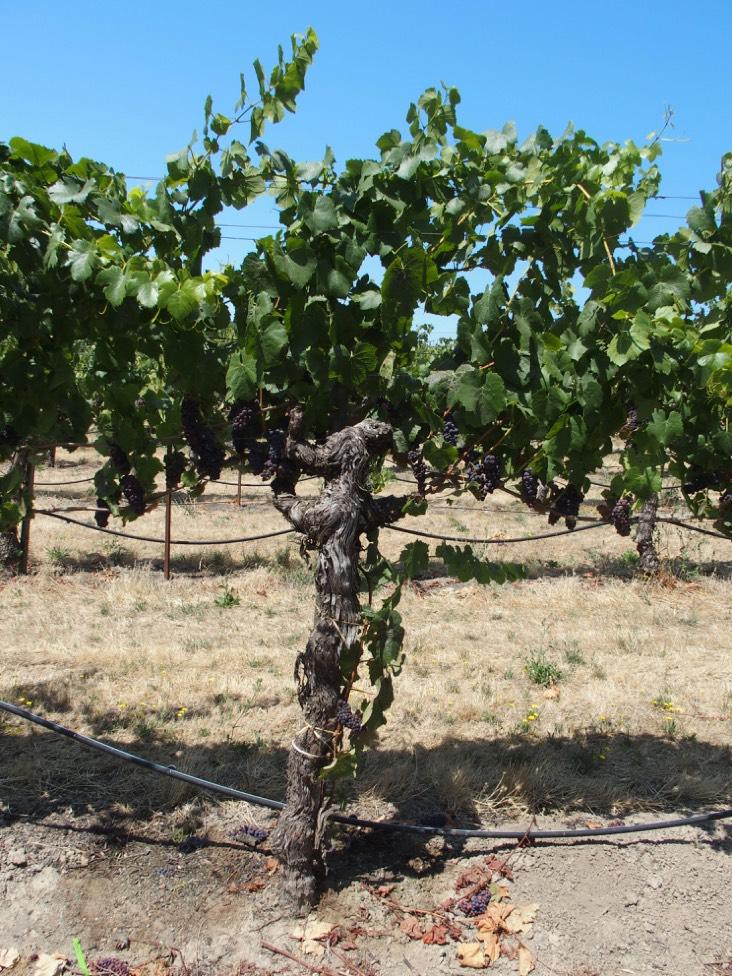
It is important to keep in mind that there are no old vines Pinot Noir produced from 100% 40-year-old or older vines. That is because over time vines die, become virus-infected or otherwise diseased and are replaced with newer vines that are often established from cuttings of old vines on newer rootstocks. In this way, the replacement planted vines have the same genetic material. I believe many of the vineyards featured in my bucket list have a credible amount of original plantings some of which have been supplemented with a percentage of replants using budwood from original vines that show desirable traits. When known, I have included the percentage of original vines that are still viable in an old vine Pinot Noir vineyard. Drinking Pinot Noir from 40- to 50-year-old vines offers no guarantee of discovering nirvana. That said, a large number of these old vine Pinot Noir reviewed in this issue imply that maturity has its advantages. I will say, without question, tasting through these old vine Pinot Noir wines has been one of the most exhilarating and memorable experiences of my career in wine. When one considers that California Pinot Noir vineyards have been plagued with heatwaves, wildfires and the resultant smoke taint, evacuations during the growing season, periodic blackouts, and recurring pestilence, it is remarkable that old Pinot Noir vines have persevered. OLD VINES MATTER!
Old Vine California Pinot Noir Vineyards: Sonoma/Napa Counties, A-D
Eric Lavmann, Cambiata Winery
Ambassador’s Vineyard
Location: Sonoma Valley
The original 1953 Pinot Noir block at Ambassador’s Vineyard is the oldest continuously producing Pinot Noir vineyard in California. An additional Pinot Noir block was established in 1957 but replanted to Chardonnay in 1998. The 1953 block of Chardonnay (Wente selection) at Ambassador’s Vineyard is also the oldest continuously producing Chardonnay vineyard in California. The plantings of Pinot Noir and Chardonnay at Hanzell Vineyards occurred at a time when there were less than a few hundred acres of each planted in North America. Hanzell Vineyards was founded in 1953 by James D. Zellerbach, the Ambassador to Italy during the Truman administration, who named the winery after his spouse Hannah. Hanzell sits at the southern end of the Mayacamas mountain range overlooking the southwestern end of the Sonoma Valley and the town of Sonoma and San Pablo Bay. The 200-acre property currently includes 46 planted acres, primarily on south-facing slopes. Zellerbach had the vision to produce wines equal to the finest in the world. He had traveled extensively in Burgundy that led to his attraction to Pinot Noir and Chardonnay. Viticulturist Ivan Schoch was hired by Zellerbach to plant the original 3 acres of Pinot Noir and 3 acres of Chardonnay at Hanzell Vineyards. In the early 1950s, Pinot Noir budwood was hard to come by. Legend has it that a Napa Valley vineyard owned by Martin Stelling and Ivan Schoch had a Pinot Noir selection in their To-Kalon Vineyard that was sourced from Santa Cruz Mountains vintner Martin Ray via Paul Masson, and possibly came from Clos de Vougeot. Stelling was unwilling to part with any budwood so founding winemaker Brad Webb went on a clandestine mission at night to Napa in 1952 and brought back cuttings. Another, more plausible story is posted on the Hanzell Vineyards website. UC Davis professor A.J. Winkler selected vines from which To Kalon Vineyard manager Ivan Schoch cut the budwood. Schoch was also Hanzell’s vineyard manager when Zellerbach planted Hanzell Vineyards in 1953, and it was Schoch who introduced the To Kalon Vineyard cuttings to Hanzell Vineyard. Still another version is that Schoch took cuttings directly from La Cresta vineyard upon the advice of A.J. Winkler. The Pinot Noir vines in Ambassador’s Vineyard are planted in well-drained, clay loam on St. George rootstock. The clusters have a high incidence of millerandage, berries for which pollination has failed and grapes develop without seeds. This lack of seeds restricts the growth of the grapes to the size of peas. Wine made from these tiny grapes potentially has complex flavors and abundant tannins for more aging potential. Over time, many of the newer plantings at Hanzell have been cuttings from the original cuttings. The selection is now known as the Hanzell clone and has been propagated at a number of other vineyards throughout California. It has been currently estimated that between 15-20% of the original vines have been replanted.
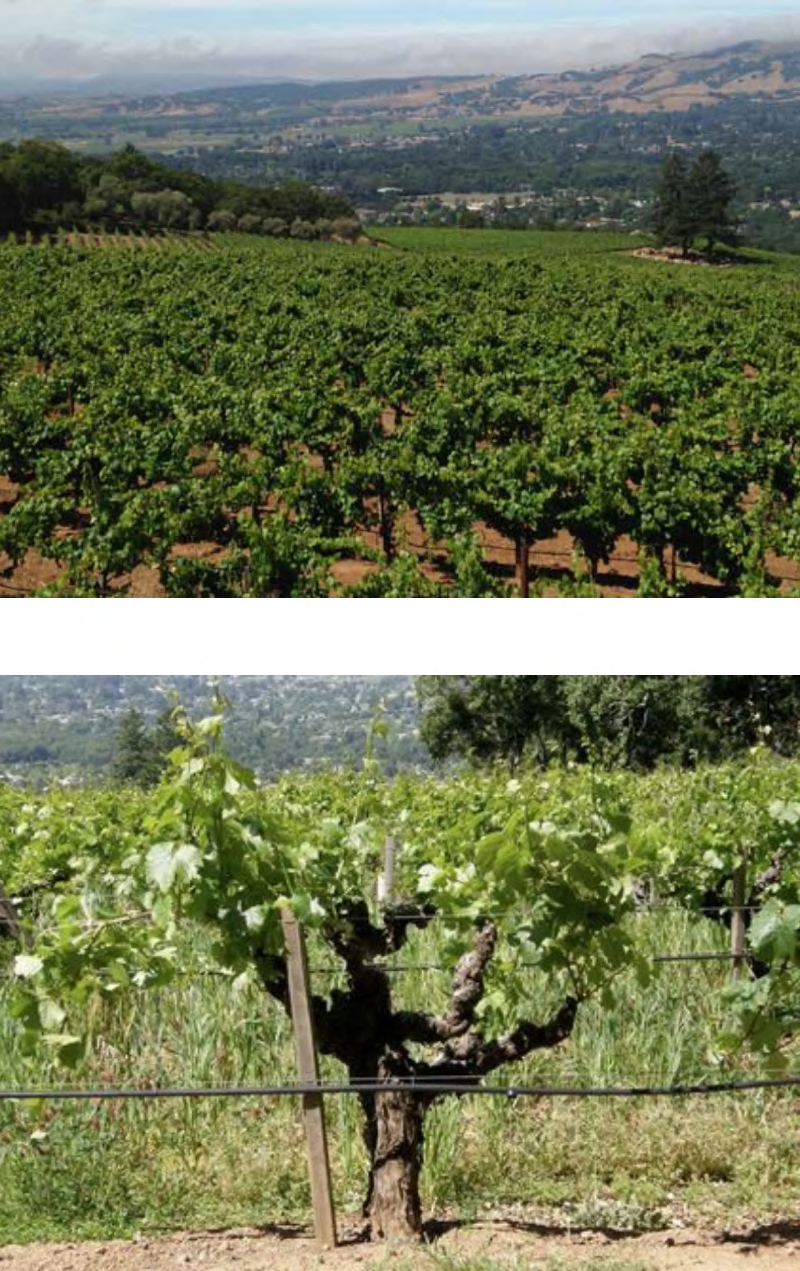
Hanzell Vineyards was purchased by the de Brye family in 1975. The estate’s 13-acre de Brye vineyard was originally planted in 1976 east of the original Ambassador’s plantings with budwood taken from the inaugural 1953 and 1957 blocks of Pinot Noir. A De Brye Vineyard Pinot Noir bottling has appeared in the past. Grapes from the original vines in the Ambassador’s Vineyard are typically blended with grapes from other estate vineyards planted in subsequent years (de Brye, Sessions, and Zellerbach vineyards) for the winery’s annual Hanzell Vineyards Sonoma Valley Pinot Noir. In 2003, 2007 and 2014, Hanzell bottled a Pinot Noir solely from the original blocks and labelled the wine Ambassador’s 1953 Vineyard Sonoma Valley Pinot Noir. This special limited release was only made available to Ambassador’s Circle Exclusive and Private Collector level wine club members. Visit www.hanzell.com. I reviewed the 2003 Hanzell Ambassador’s 1953 Vineyard Sonoma Valley Pinot Noir in 2010. “Aromas of fresh black cherries amped to a high level. Bright and opulent on the nose with an interesting mineral edge. My notes say, ‘Remarkable!’. Intensely flavored but light on its feet, with a discreetly concentrated core of cherry and berry fruit set off by notes of bark, peat and spice. Well-structured with ripe, soft tannins seemingly caressing the fruit in velvet. A special wine that I was honored to drink and one of the greatest California Pinot Noirs I have ever tasted.” The 2014 vintage was reviewed recently:
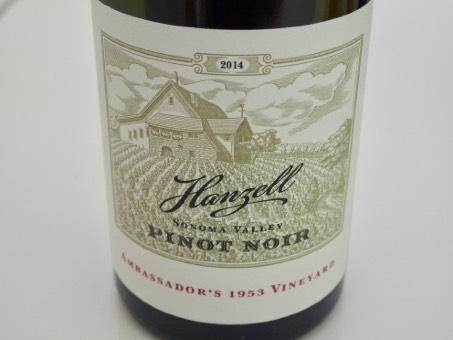 2014 Hanzell Ambassador’s 1953 Vineyard Sonoma Valley Pinot Noir 12.8% alc., $145. 8 barrels produced, 4 barrels selected for bottling. · Moderate garnet color in the glass. Lovely aromas of black cherry, damp earth, peat and spice cabinet. Bright, juicy and polished in a midweight style, displaying juicy flavors of black cherry and black raspberry with an earthy tone in the wings. Very giving upon opening, with suave, fine-grain tannins and an exceptional finish of uncommon length. Very impressive in all respects with the balance to age beautifully. When tasted the following day from a previously opened and recorked bottle, the wine was really on point offering pure sensual pleasure. Like many old vine Pinot Noirs, this wine just doesn’t taste like every other California Pinot Noir offering an extra something that is hard to describe but a delight to experience. Score: 97
Arrendell Vineyard
This vineyard is the crown jewel in the Hartford Court lineup. It is a low-lying vineyard located with the coldest mesoclimate of the Green Valley of Russian River Valley. The vineyard has been called the “snowshoe vineyard” because in wet years workers need to wear snowshoes to get through the muddy rows of vines. The grapes struggle to ripen, yields are often less than one ton per acre and are picked after Halloween in most vintages. Dijon clones 114, 667 and 777 and Pommard were planted subsequently in 1996 but these grapes are in Hartford Family’s Haley’s Block bottling (Haley’s Block is a separate block within the Arrendell Vineyard) The vineyard is a monopole for Hartford and is sold through a mailing list and online at www.hartfordwines.com. I reviewed the 2013 Hartford Court Arrendell Vineyard Pinot Noir in 2016. “The nose is flat-out gorgeous, filled with aromas of boysenberry and blackberry preserves with a wild organic tone. Power to thrill, with a spellbinding core of dark fruits that envelope the palate and linger on the prodigious finish. Despite the fruit heft, the wine is welcoming with refined tannins, juicy acidity and a silky demeanor. A highly unique wine of uncommon provenance.” 96 I also reviewed the 2012 Hartford Court Arrendell Vineyard Pinot Noir in 2015. “A wonderful array of fresh scents greet the drinker including black cherry, kirsch, cassis, sous bois and violets. Sappy and robust, with intense layers of flavor that unfold on the palate in stages to reveal notes of boysenberry, cassis, plum reduction sauce and earthy herbs, Very smoothly textured with balanced tannins and a lingering finish. A special wine of rare personality and breeding.” 95
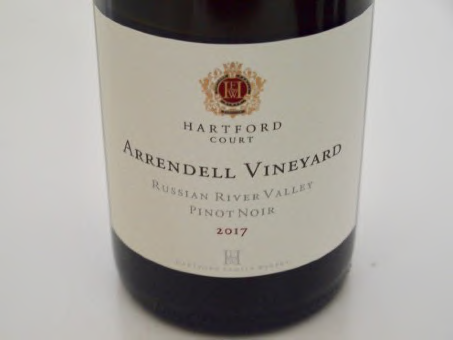 2017 Hartford Court Arrendell Vineyard Russian River Valley Pinot Noir 14.4% alc., pH 3.53, TA 0.66, 217 cases, $100. Aged 16 months in French oak barrels, 44% new. Bottled unfined and unfiltered. · Dark garnet color in the glass. The nose opens slowly to reveal enticing aromas of blackberry, blueberry-pomegranate, earthy flora and a hint of oak. A flood of blue and black fruits envelope the palate in a mid-weight plus style.The layers of fruit saturate the taste buds, creating a magnetic attraction, yet the wine is not cloying or sweet. There is admirable harmony with a favorable compliment of oak. The fruit really hangs on through the long, long finish that is symbolic of a special wine. Score: 94
Bohan Vineyard
This vineyard is situated at 1,300-1,500 feet elevation only 3.05 miles inland from the Pacific Ocean. The Pinot Noir vines, planted in sandstone and Goldridge soils, are own-rooted and dry-farmed. Total acreage at Bohan Vineyard is 59 acres including Pinot Noir, Chardonnay and Trousseau varieties. It is estimated that 95% of the original 1974-1980 plantings are still productive.
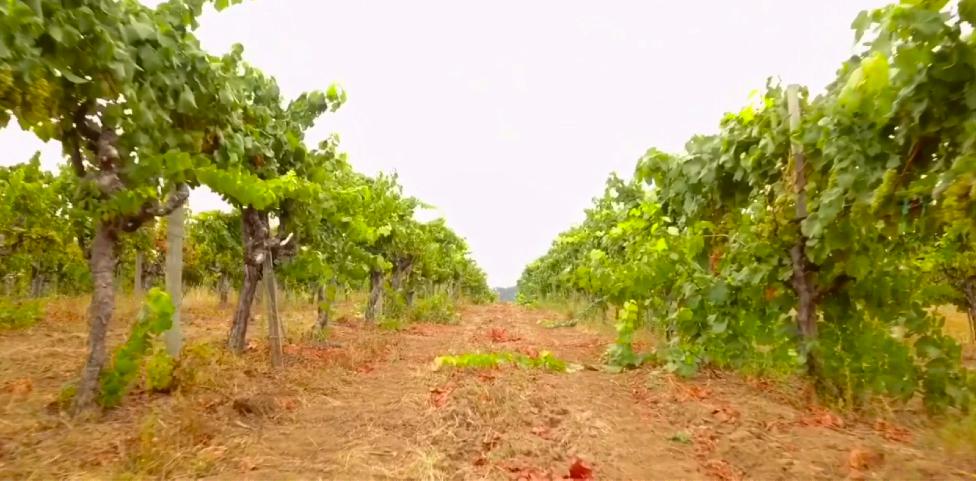
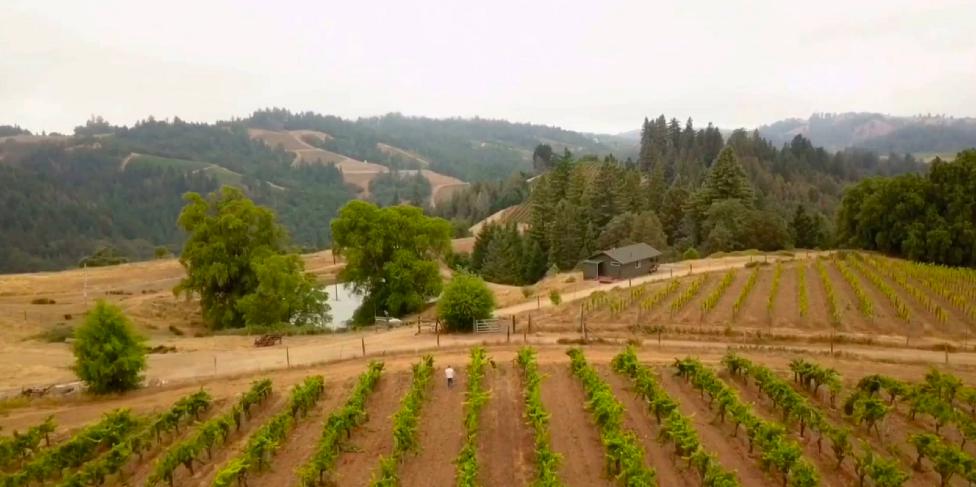
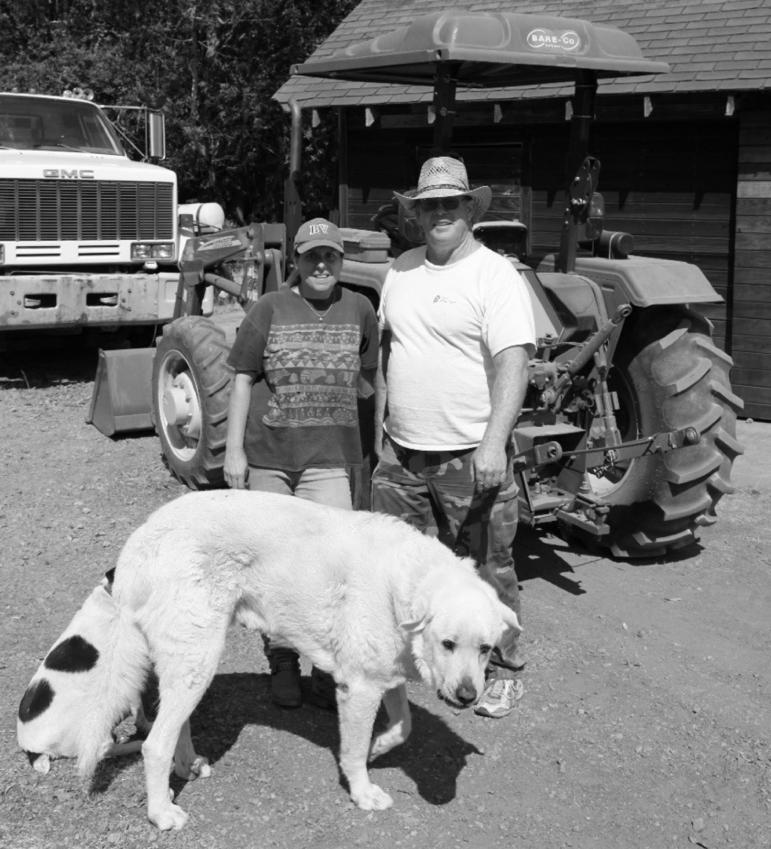
I have reviewed several vintages of Kutch Bohan Vineyard Pinot Noir: 2013 - 93, 2014 - 92, 2015 - 95, 2016 - 97, and 2017 - 92. The 2016 vintage was reviewed again in July 2020, 2 1/2 years after the previous review. The 2018 vintage was also reviewed recently.
2016 Kutch Bohan Vineyard Sonoma Coast Pinot Noir 11.3% alc., $54. Sourced from grapes planted in 1974. Vines are dry farmed and own rooted. 100% whole cluster, native yeast and native malolactic fermentation. Aged 12 months in 100% neutral French oak barrels without racking. Bottled unfined and unfiltered. · Moderately light garnet color in the glass. The whole cluster-inspired nose features aromas of red cherry fruit, red rose petal, sap and carbonic maceration. Light to mid-weight in style and red fruited with a noticeable wilted rose floral tone. Appealing elegance, suede tannins and shot through with bright acidity, finishing long with lip-smacking tart cherry goodness. When tasted the following day from a previously opened and re-corked bottle, the nose was even more enticing, becoming more savory and less overtly fruity, and the dark red fruits and tannins had reached gracious integration. The overall experience was exceptional. Score: 97
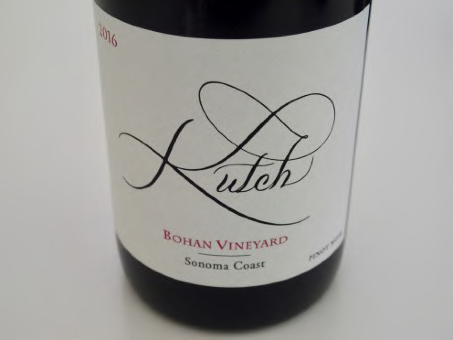 2018 Kutch Bohan Vineyard Sonoma Coast Pinot Noir 13.4% alc, 200 cases, $54. 100% whole cluster, indigenous primary fermentation, natural malolactic fermentation. Minimal effect SO2. Aged in French oak barrels. Bottled unfined and unfiltered. · Moderately light garnet color in the glass. Deeper red fruit aromas arrive over time to compliment the scents of underbrush, sap and carbonic maceration. Light to mid-weight in style featuring red cherry, cranberry and raspberry fruit flavors, framed by energizing acidity and moderately imposing tannins. The wine finishes with a lip-smacking, slightly tart, cherryfueled finish that exhibits a modicum of astringency. A very young wine that needs time in the cellar. Much better tannin integration when sampled the following day from a previously opened and re-corked bottle. Score: 92
2018 Kutch Bohan Vineyard Graveyard Block Sonoma Coast Pinot Noir 13.1% alc., 100 cases, $54. Grapes are from a block located in the lower portion of the vineyard. Head trained and dry farmed vines on their own roots.100% whole cluster, indigenous yeast primary fermentation, natural malolactic fermentation, minimal effective SO2. Aged in French oak barrels and bottled unfined and unfiltered. · Lovely aromas of black cherry, boysenberry, cola and ground savoury spice. Exuberant and intense fruit presence with layered flavors of black cherry, black raspberry and purple berry. There is a slight stem or green note in the background.The tannins are evident but not overly aggressive and the acidity is well integrated. Quite young and will benefit from a couple of years in the cellar. Score: 93
Cohn Vineyard
This vineyard was originally planted to Pinot Noir and Zinfandel by Enid Sales, an architectural historian and preservationist and her partner. They chose to plant the unusual pairing of Pinot Noir and Zinfandel because those were the varietals that they liked to drink.. 6.19 acres was established on a rocky hillside to a massale selection of Pinot Noir, likely Martini and Pommard, on St. George rootstock, along with 3.66 acres of Zinfandel. The second owners of the vineyard were Arne and Tekla Cohn who acquired the property in the early 1980s and lent the vineyard its name. They planted an additional 5.11 acres of Zinfandel in 1986. Grapes were sold to Hop Kiln Winery for about five years and when the contract expired in 1987, Burt Williams of Williams Selyem began to source grapes from the Cohn Vineyard. The grapes were usually blended into the Russian River Valley and Sonoma County bottlings at Williams Selyem, but a vineyard-designated Cohn Vineyard Pinot Noir was produced in 1987, 1989 and 1993. Burt dropped the vineyard in 1995 when owner Arne Cohn overcropped by putting in drip irrigation and overwatered the vineyard. Mary Brogan, Burt Williams’ daughter, sourced grapes from Cohn Vineyard from 2004-2006, vineyard designating the 2004 vintage and blending it into her Russian River Valley blend the other two vintages. Williams Selyem has sourced fruit in recent years. A little known trivia fact is that Kosta Browne made its first commercial Pinot Noir from the Cohn Vineyard in 2000. Kosta Browne released a vineyard-designated Cohn Vineyard Pinot Noir in 2002, 2003, 2004, 2005, and 2012 to 2015. Joe and Mary Dewane acquired the vineyard in 2002 upon on the suggestion of Burt Williams and planted an additional 2.64 acres of Pinot Noir in 2009. Today, Benovia Winery farms about 9 acres of Pinot Noir and 8.7 acres of Zinfandel on the 55-acre property. The vineyard was extensively rehabilitated after the acquisition, has been organically farmed since 2009 and minimally irrigated under the direction of Benovia Winery’s winemaker and viticulturist Michael Sullivan. About 85% of the original vines are still productive. Replanting has been done with cuttings from the old vines and heritage selections that are virus-free. Vines struggle to produce in the low vigor soil of iron-rich, clay loam known as “Terra Rosa” because of its intense red color along with cobblestones and quartz that insured good drainage (see the photo of vineyard soil below). Average yields are 1.0 to 1.5 tons per acre.
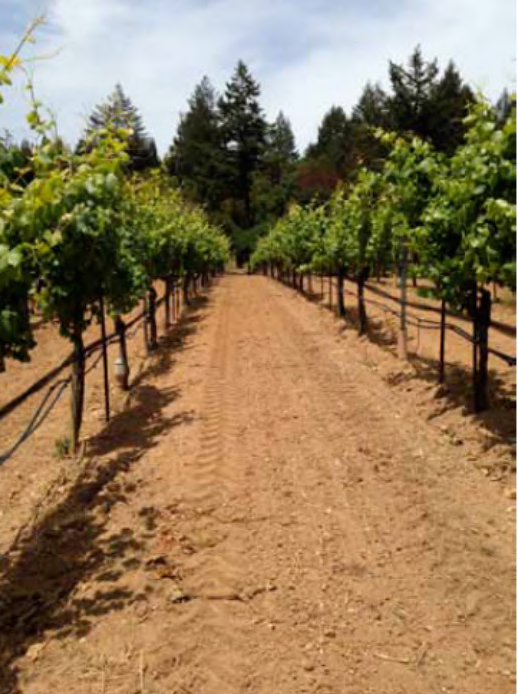
2006 Benovia Cohn Vineyard Sonoma County Pinot Noir 14.4% alc., 220 cases, $62. · Moderately dark garnet color in the glass. Inviting aromas of black cherry, cassis, spice and rose petal upon opening. A flood of rich, dark fruits saturate the palate along with hints of toast and licorice in the background. The flavors tiptoe to the edge of over ripeness. Best right after opening as oak shows up over time. There is a hint of alcoholic warmth on the lengthy finish. Drink up. Score: 89
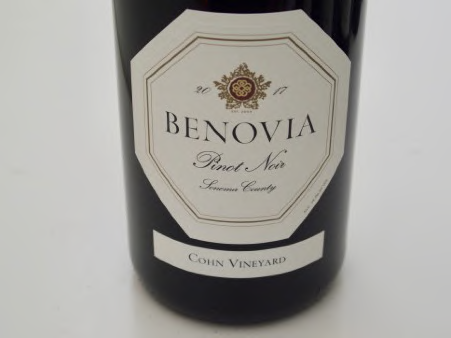 2017 Benovia Cohn Vineyard Sonoma County Pinot Noir 14.1% alc., $70. First planted in 1970 most likely to Martini 13 and Pommard clones. This vineyard outdates most other plantings in the Russian River Valley by 20+ years. Farmed organically with minimal irrigation, these gnarled vines produce small and compact clusters with yields of just over 1 ton per acre. 100% de-stemmed, 8- day cold soak, indigenous yeast fermentation, and aged in French oak barrels, 46% new. · The fruit aromas have not arrived even when tasted the following day after opening when underbrush, earthy flora and dark chocolate dominate the aroma profile. Much better on the palate that offers a luscious mid-weight core of deep, dark cherry flavor with sides of cola and vanilla. The tannins are minimal and the texture is creamy. This is a somewhat rustic wine with soul, finishing long with a fruit-filled ending. Score: 92
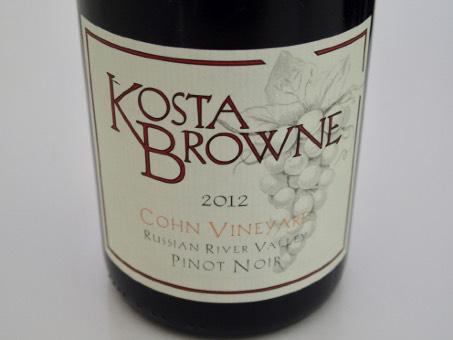 2012 Kosta Browne Cohn Vineyard Russian River Valley Pinot Noir 14.7% alc., 36 cases, $84. · Moderately dark garnet color in the glass. Aromas of boysenberry, blackberry, vanilla, toast and chalk. Prodigious and ultraripe purple and black fruits flood the palate. Velvety in texture, with soft, integrated tannins. The high alcohol adds sweetness, creates viscosity and shows up as a little warmth on the moderately long finish. Well-made in this style that finds many fans. Holding up nicely but best to drink up within the next few years. Score: 91
David Demostene Ranch
Terry Leighton, owner and winemaker at Kalin Cellars in Marin County, began sourcing Pinot Noir from the Demostene Ranch in 1975 according to David Demostene. The vineyard is located within a mile of the Russian River and is dry farmed. Soils are a mix of clay, silt and limestone. Until 2005, when the Pinot Noir vines were pulled out, the Demostene Ranch was the oldest planting of Pinot Noir in the Alexander Valley AVA. Today, it is the oldest documented Zinfandel vines in Alexander Valley. Microbiologist Dr Terry Leighton and his spouse Dr Frances Leighton founded Kalin Cellars in 1977. Leighton was the original winemaker at Domaine Laurier in the 1970s before starting his own label. Over the ensuing years, the Leightons have worked in relative obscurity, avoiding publicity at all cost, while producing some of California’s greatest wines that only a few wine critics and wine geeks can testify to. Years ago, Robert Parker, Jr. called Terry Leighton “one of California’s two most talented winemakers” and his wines “the wines of a genius.” I have been enamoured with the Kalin Cellars wines for years because of their unique character, age ability and individuality. Because of the style of winemaking, the wines are not ready to drink for at least five years. Unheard of in the modern wine business model, the Leightons follow no set vintage sequence. Basically, the wines are kept in a temperature and humidity-controlled underground cellar and released to the marketplace when the Leightons feel they taste good and have acquired the fifth taste of umami, usually between 5 to 10 years after the vintage but often longer. “No wine before it’s time” could be their mantra. In essence, then, every wine that is released is a library wine! I believe the current release of the Kalin Cellars Cuvée DD Sonoma County Pinot Noir is the 2000 vintage although the winery's website does not reflect this. I included this vineyard in my bucket list even though the David Demostene Ranch Pinot Noir vines have been pulled out because the current release of Kalin Cellars Cuvée DD Sonoma County Pinot Noir is vintage 2000 and presumably vintages 2001-2004 are going to be released in the future. Kalin Cellars wines, including Sonoma County Pinot Noir and Chardonnay and Livermore Valley Semillon, are sold by inquiry through the phone or website at www.kalincellars.com.
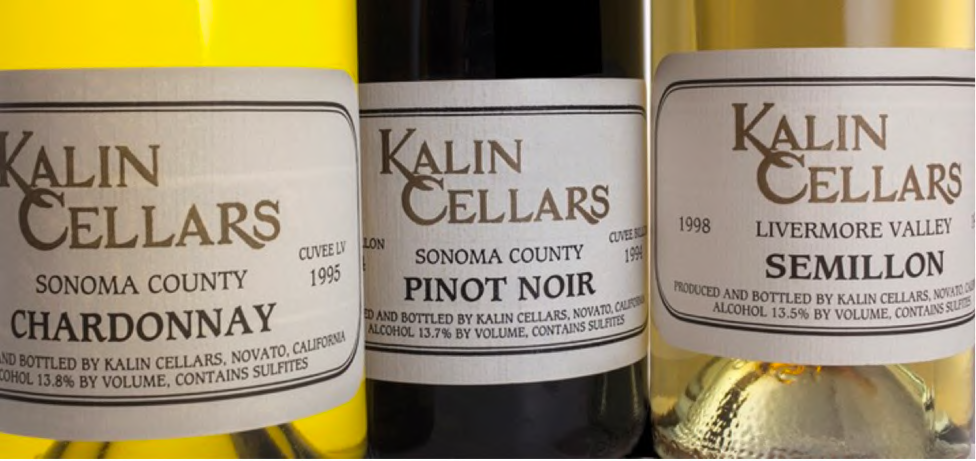
I have previously reviewed 1990, 1994, 1996, 1997 and 1999 Kalin Cellars Cuvée DD Sonoma County Pinot Noir at www.princeofpinot.com/winery/202/.
 2000 Kalin Cellars Cuvée DD Sonoma County Pinot Noir 13.5% alc., $40. · Moderate garnet color with a slight orange tinged rim. The nose is musty with aromas of old cigar box and bacon fat but no fruit. Mid-weighted, with flavors of raisin, prune and dried cherry. There is definitely the flavor of beef broth (umami) replacing the faded fruit. The acidity is quite evident, even unpleasant, especially on the puckering, citric finish. A wine only for fans of extremely well-aged California Pinot Noir. Score: NR
Dehlinger Estate Vineyard
Tom Dehlinger (DAY-leen-ger), along with his radiologist father, invested in a 45-year-old ranch on Vine Hill Road in Sebastopol in 1973 at a time when Russian River Valley Pinot Noir was in its infancy. Tom had pursued graduate work for a year at UC Davis, then took winemaking positions at Hanzell and Dry Creek Vineyard. Early on, Tom had a well-defined idea of how wine grapes should be grown and realizing that other grape farmers were not conforming to his vision, he was driven at the age of 26 to plant his own vineyard. He spent the spring of 1974 bench grafting over 10,000 vines in a rented, heated basement in Bolinas in Marin County. By the summer, Tom had planted the fledgeling vines in a nursery space at Dry Creek Valley Winery. At the same time, he was removing Gravenstein apple trees from his hillside property. With guidance from Joseph Swan, Warren Dutton and Forrest Tanzer, Tom planted the first 14 acres on his property in the spring of 1975. The original 3.5-acre block of Pinot Noir plantings consisted of Swan selection and a mix of Pommard and Martini clones. Chardonnay and Cabernet Sauvignon were also planted initially. After a few years, it became evident that there were significant soil differences within the vineyard. The lower elevations had Goldridge soil that was deeper, richer and more fertile. The hilltops contained Altamont soil, a variation of Goldridge with a redder color, different mineral content and lower vigor. In recognizing differences in terroir within the vineyard, Tom became an early champion of separately picking and vinifying small lots of grapes from different portions of the vineyard. The recent photo below of a replanted Octagon portion of the Dehlinger property shows these soil differences:
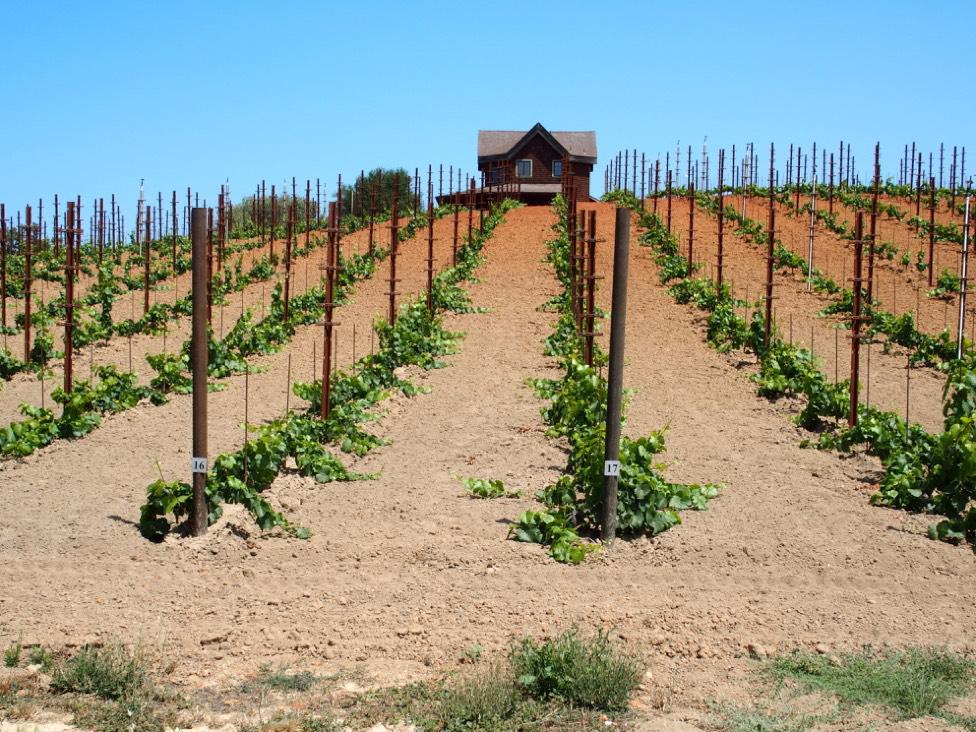
To overcome the vine imbalances, a split-canopy vertically shoot positioned Lyre trellis system derived from Bordeaux was retrofitted in 1993. This movable trellis lifted shoots and leaves away from the bank of grapes allowing more light exposure, reducing the risk of mildew and permitted better management of shoots and clusters during the growing season. This trellis system is highly unique for California Pinot Noir vineyards. Noted viticulturist, Dr Richard Smart, was to say, “The Dehlinger Vineyard is one of the best examples I’ve seen anywhere in the world of careful vineyard management with the aim of maximizing quality." The oldest 1975 Pinot Noir block in the Estate Vineyard is still producing. There are two soil types in this 45-year-old block, and in some years the portion planted in Goldridge soil has been showcased and in other years the portion planted in Altamont soil has been featured. In other years no distinction has been made. The recent photos below are of the original 1975 Swan vines. The second photo shows one heavily virused Swan vine (red blotch). The photos show irrigation lines but these are rarely used as Tom is a firm believer in dry farming.
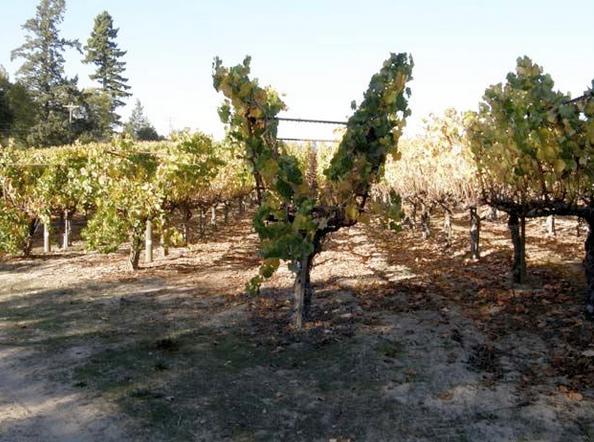
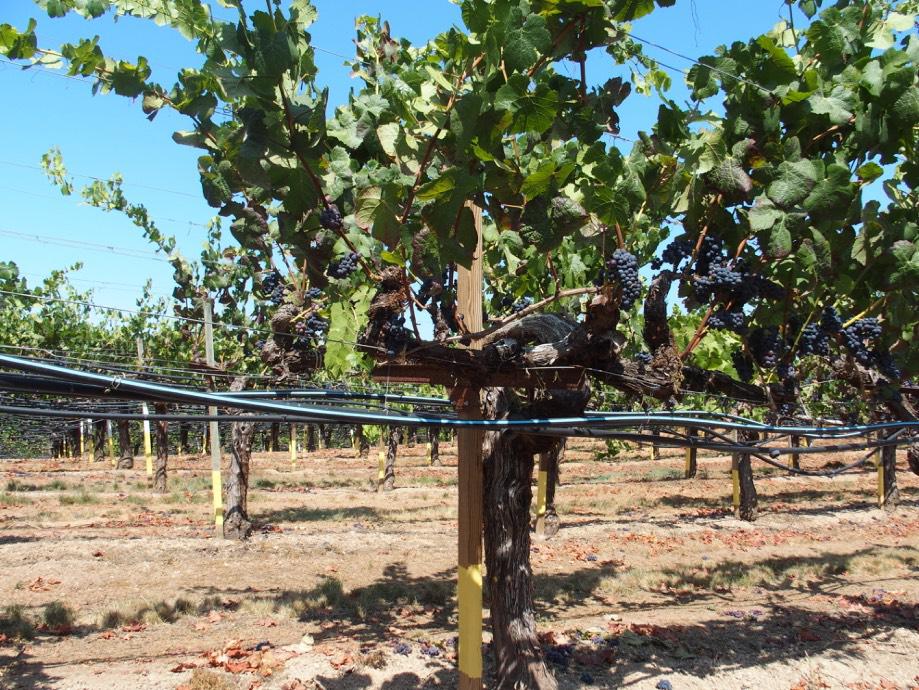
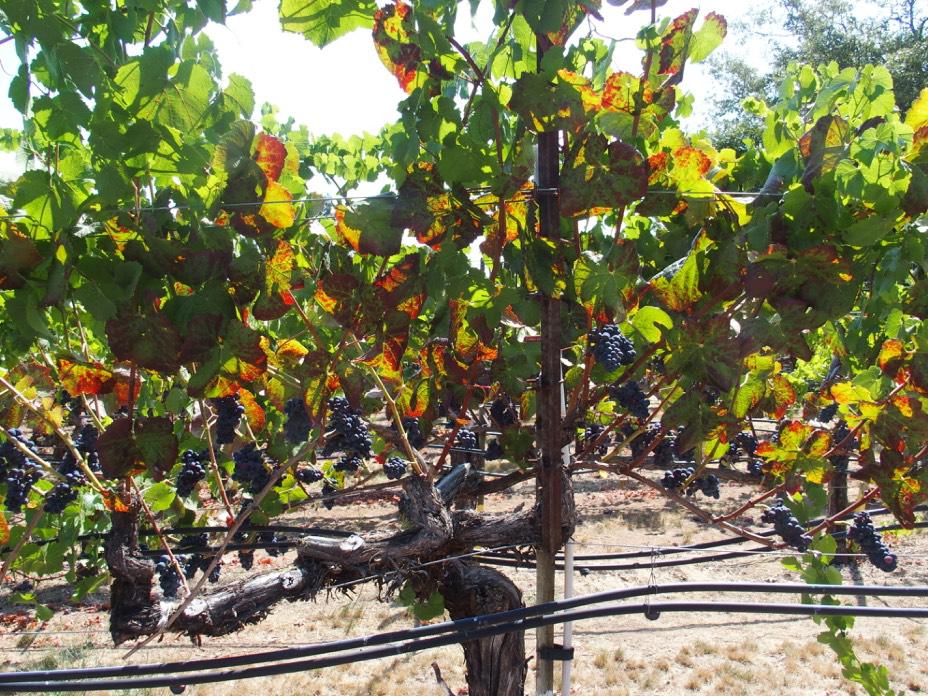
In recent years, the 1975 block has contributed to a bottling called ‘Champ de Mars,’ a name that refers to a particular corner of the Dehlinger property located east of the winery building. There are now vines of varying ages in the ‘Champ de Mars’ part of the ranch, as they were planted between 1975 and 2011. The ‘Champ de Mars’ bottling is more about a particular place on the ranch rather than vine age. In 1982, a 3.5-acre plot of Swan selection was planted around the octagon-shaped house on the top of the property and is referred to as the Octagon Vineyard. These vines eventually were pulled because of virus issues and the vineyard replanted (see note and photo above). Since the inaugural vintage of 1994, Dehlinger has released a limited amount of Octagon Pinot Noir while in other years it was included in the Estate or Reserve bottling. Also in 1982, a special part of the vineyard was planted to the Pommard clone and this gave birth to the Dehlinger High Plains bottling starting with the 1999 vintage. The quietness in this part of the vineyard inspired the name. During one of his visits to this quiet retreat, Tom recalls, “I must have imagined I was Clint Eastwood riding alone as the High Plains Drifter and the name just stuck.” An extensive feature on Dehlinger Winery including past vertical tastings of Dehlinger wines is at www.princeofpinot.com/article/768/. Dehlinger wines are allocated through a mailing list or can be obtained by phoning the winery. Tastings are by appointment with winemaker Eva Dehlinger, Tom’s daughter. Visit www.dehlingerwinery.com.
California Old Vine Pinot Noir Vineyards Sonoma/Napa Counties - H-Q
Joe Czerwinski, wine journalist
Haynes Vineyard
Location: Coombsville, Napa Valley
Pat and Duncan Haynes founded Haynes Vineyard in 1967 on a 43-acre parcel that had been in the Haynes family since the late 1800s. The original plantings of Wente clone Chardonnay and Martini clone Pinot Noir were established with the assistance of Louis Martini, Sr. The first Pinot Noir plantings were cuttings from the Three Palms Vineyard in Calistoga first brought there from Burgundy by Louis Martini, Sr. Few people know that Pinot Noir was planted at Three Palms Vineyard in its early days. 3.5 acres of the old vines are still healthy and in production today. There have been some vine removal and interplanting through the years but the old vines predominate. Syrah has been added. Fernando Delgado has farmed and lived on the property since 1971 and is responsible for the longevity of the original plantings. He prunes each vine individually according to its strength and potential, choosing which canes to keep and how many canes and shoots that each vine will grow. The vineyard is located in a cool part of the Coombsville AVA, east of the city of Napa. The site has the mildest growing season of any in the Napa Valley, being open to the morning fog and afternoon breezes from San Pablo Bay that also cool Carneros to the west. The rocky, volcanic soil is known as Coombsville gravelly loam and is both well-draining and rich in minerals, ideal for producing noteworthy and age-worthy Pinot Noir. The Haynes had their own winery, Whitford Cellars, and Andre Tchelistcheff produced the Pinot Noir from the Haynes Vineyard in the early 1990s. Ken Bernards of Ancien Wines took over as winemaker in 1997 and when the Haynes family closed Whitford Cellars, Ken made his Ancien wines in the winery for several years. The Ancien website and wine notes state that the original Haynes Vineyard Pinot Noir was planted in 1966. Tulocay Winery has made Pinot Noir from the original old vine plantings at Haynes Vineyard continuously since 1975. Bill Cadman, owner, and winemaker at Tulocay says that the original Pinot Noir was planted in 1968 and, “although a rarity in the Napa Valley, consistently produces wines of great elegance and finesse.” His daughter, Brie, is currently the winemaker at Tulocay, and her quote about the Haynes Vineyard mimics her father: “The Pinot Noirs produced by the old vines at Haynes are elegant and finessed, not in-your-face Pinot Noir, but rather a more balanced, nuanced wine. They are usually rich in rose petal and orange zest in their youth and continue on to earth, black tea, and cedar as they age.” Ancien Wines has bottled a Haynes Vineyard Old Block Pinot Noir since 2012. Kitson bottled 2016 Haynes Vineyard Pinot Noir using Swan and Dijon 115 grapes that had been planted at the vineyard subsequently. The Tulocay Winery old vines Haynes Vineyard Pinot Noir is available at www.tulocay.com and the Ancien old vines Haynes Vineyard Old Block Pinot Noir is sold on the website at www.ancienwines.com. As a side note, Heitz Cellars owner, agriculture magnate Gaylon Lawrence, Jr., is launching a new winery focused on small-lot Pinot Noir, Chardonnay and Syrah from a 32-acre Coombsville property he purchased in 2019. The winemaker is Nico Cueva, the head winemaker since 2015 at Kosta Browne. The first vintage will be 2020.
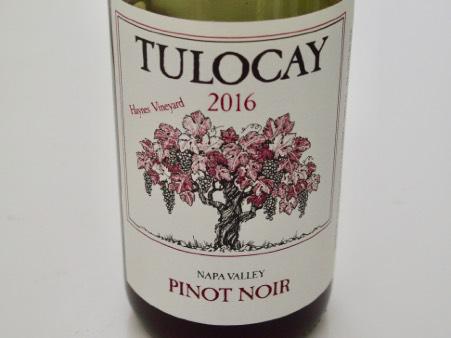 2016 Tulocay Haynes Vineyard Napa Valley Pinot Noir 13.7% alc., pH 3.60, TA 0.62, RS <1 g/l, 137 cases, $40. 42nd consecutive year Bill Cadman has purchased old vine Pinot Noir from Haynes Vineyard. Harvest Brix 24.4º. Double Gold California State Fair. Winemaker Brie Cadman. · Moderate garnet color in the glass. The nose is well-perfumed with aromas of red cherry, cardamom spice and a hint of toasty oak. Very suave and easily drinkable in a middleweight style, featuring a delicious core of black cherry and raspberry fruit backed by reserved tannins. This wine seduces rather than attacks the palate.The barrel treatment is spot on and the finish is impressively long and vivid. Still superb when tasted the following day from a previously opened and re-corked bottle. Score: 94
 2017 Ancien Coombsville - Haynes Old Block Napa Valley Pinot Noir 14.1% alc.,61 cases, $68. Sourced from the most flavorful and healthiest old vines from the original planting. No smoke damage in this vintage. An encomium to Duncan Haynes. · Moderate garnet color in the glass. A knockout from the get-go. Large-scale aromas of black cherry, rose petal, ground savoury spice and wine cave persist over time in the glass. Very comforting in the mouth in a mid-weight style, featuring an unctuous core of cherry fruit accented with a touch of spice and complimentary barrel presence. Softly textured, with polished tannins, welcome acidity and good length on the lip-smacking finish. Score: 95
Hellenthal Vineyard
Location: Bohan Dillon Road in Cazadero in the Fort Ross-Seaview AVA
In the late 1970s, Gard Hellenthal and David Hirsch began looking for vineyards in the hills facing the Pacific Ocean in northern Cazadero. Gard secured his land just east of Hirsch Vineyards and planted the original vines at Hellenthal Vineyard. The site is only five miles inland from the Pacific Ocean at an elevation of 1,053 feet. There were two plantings. The oldest and original planting is referred to as the “Old Shop Block” and it is exclusively sourced by Ceritas Wines. The own-rooted Calera clone vines in the Old Shop Block are dry-farmed and planted in fractured and decomposed sandstone soils. The Elliott Block was first planted later in 1981. There is Pommard and Dijon clone 777 interplanted, but I am not certain if in one or both blocks but I believe is the Elliott Block. Grapes have been sourced by WesMar Winery, W.H. Smith, Radio-Coteau, and MacRostie Winery & Vineyards. The 2018 Ceritas Old Shop Block Sonoma Coast Pinot Noir has been released. Visit www.ceritaswines.com. A map of the Fort Ross-Seaview AVA showing the location of Hellenthal Vineyard and other vineyards featured in this article.
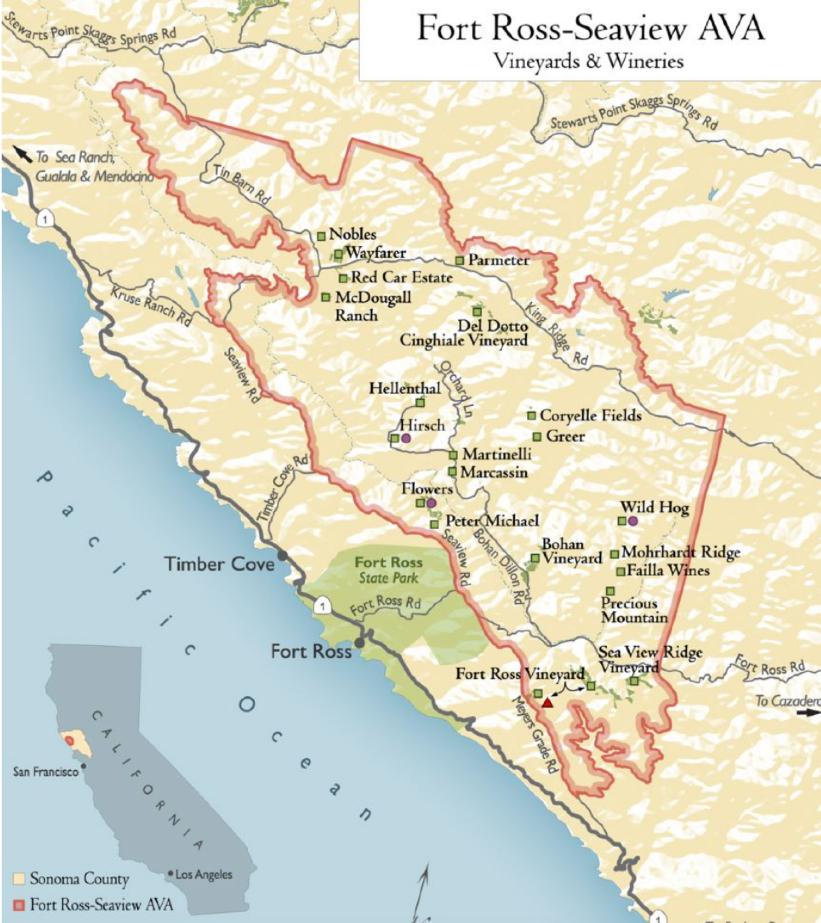
 2014 Ceritas Old Shop Block Hellenthal Vineyard Fort Ross-Seaview Pinot Noir 12.5% alc., $72. · No other grape variety can give you a nose like this one. Soaring aromas of black cherry, sous-bois, spice and toast. Very silky on entry with perfectly ripened flavors of dark cherry and raspberry with just a hint of dried herbs. Beautifully balanced with pliant tannins and bright acidity, and a, taunting, orgasmic finish that goes on and on. This wine has all the things you look for in a Pinot Noir. Score: 96
2016 WesMar Hellenthal Vineyard Sonoma Coast Pinot Noir 14.4% alc., $55. Sourced from the Elliott Block planted in 1981. · Moderately dark garnet color in the glass. Aromas of cherry and rose petal lead to a discreetly concentrated wine featuring riveting flavors of black cherry, kirsch and spice. The satiny mouthfeel is highly seductive and the gracious tannins make for easy access. The wine's harmony and vigor impress as does the waves of fruit echoing on the glorious finish. This wine takes time to reveal itself. A truly invigorating wine from a great vintage. Score: 95
Olivet Lane Estate Vineyard
Location: West Olivet Road in the Russian River Valley
In 1973, Vincent Pellegrini and his spouse Ida purchased a 65-acre plum and olive orchard in the Russian River Valley for the purpose of establishing a vineyard. The site is located on Olivet Lane Road between River Road and Guerneville Road just east of the Laguna de Santa Rosa in the heart of the Russian River Valley AVA. in Santa Rosa. This sub-region of the Russian River Valley is now known as the Santa Rosa Plain. Vincent’s son, Robert, was fresh out of school and had just returned from a tour of Burgundy when he had the idea to plant Pinot Noir on the property. They planted 20.1 acres of a Martini clone of Pinot Noir and 38 acres of a Wente clone Chardonnay on AxR1 rootstock. By the late 1970s, Robert had bottled an “Olivet Lane” Chardonnay, named for the 120 olive trees that line the vineyard's east entrance and the name stuck. Chardonnay was planted along with the Pinot Noir since it was in much more demand than Pinot Noir at the time. An Olivet Lane Pinot Noir was released for the first time in the 1980s. The vineyard was to be one of the first in the Russian River Valley devoted to both Chardonnay and Pinot Noir. The soil is well-drained, gravelly clay loam. Vine spacing is 8’ x 12’ and vines are cane pruned on a VSP trellis. Fog frequently covers the site from the evening through the early morning. Recent photos of the 45-year-old Martini clone Pinot Noir vines follow.
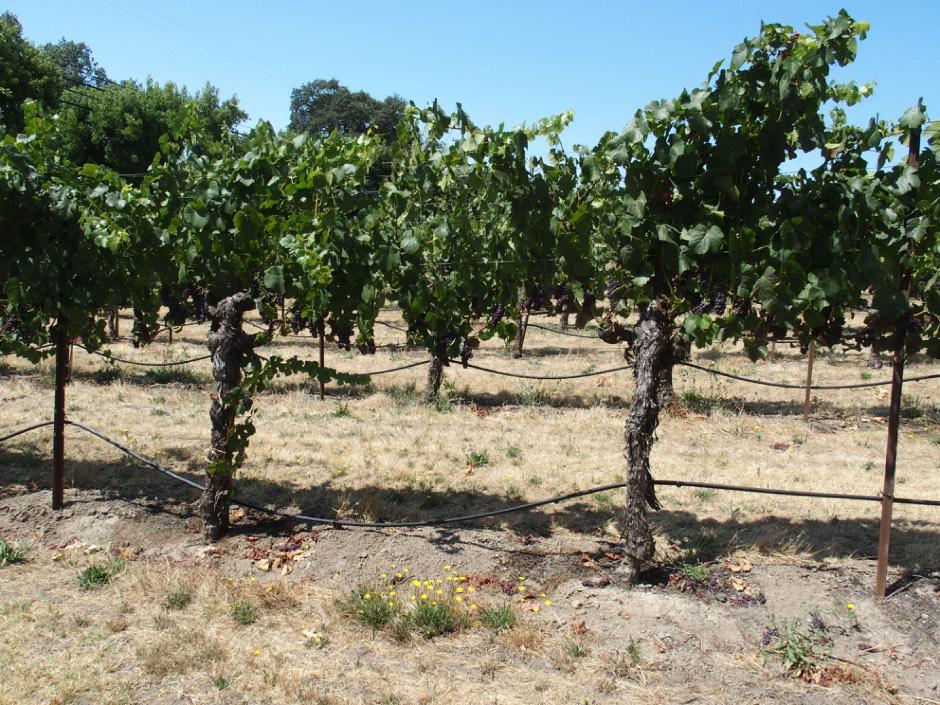
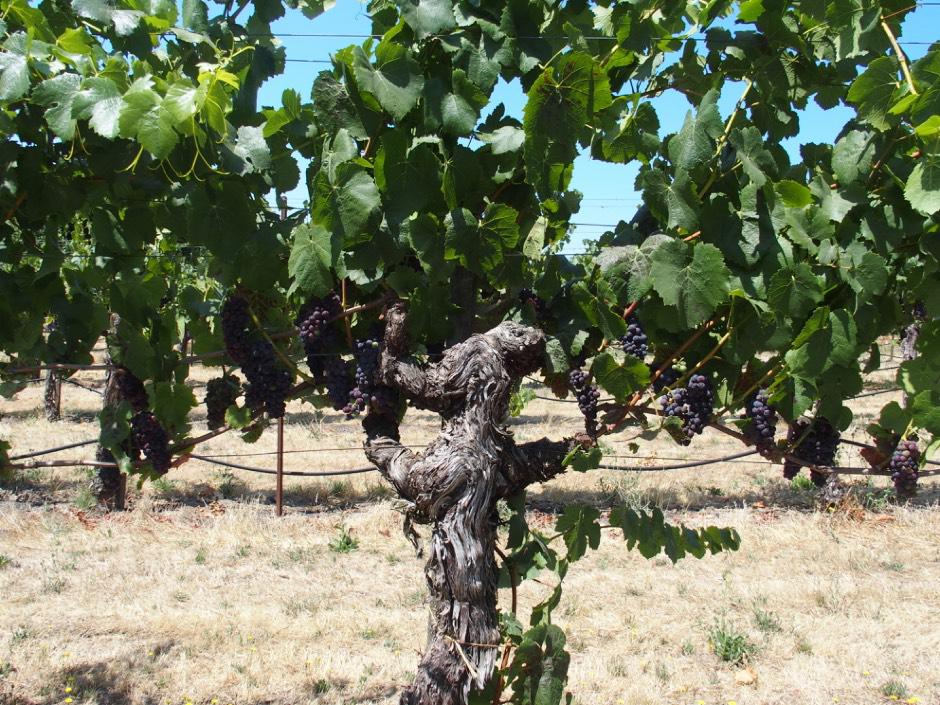
Merry Edwards has produced an Olivet Lane Vineyard designated Pinot Noir since 1997 and several other notable wineries have made distinguished wines from this vineyard including Williams Selyem, WesMar Winery, Gary Farrell Vineyards & Winery, Brogan Cellars, Kosta Browne, and Paul Hobbs. The Olivet Lane Vineyard Pinot Noir wines are sold on the winery’s website at www.pellegrinisonoma.com.
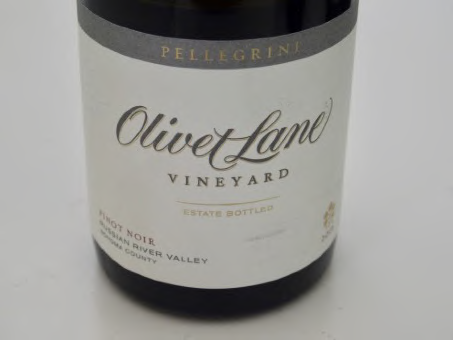 2016 Olivet Lane Vineyard Russian River Valley Pinot Noir 13.9% alc., pH 3.31, TA 0.72, $65. 5-day cold soak, 14-day fermentation in open-top fermenters, and aged 14 months in French oak barrels, 35% new. · Moderate garnet color in the glass. Nicely perfumed with aromas of black cherry, blackberry, spice and a hint of espresso. A quintessential Martini clone Pinot Noir featuring mid-weight flavors of dark Bing cherry, blackberry, cola and loads of spice. The intensity of the fruit makes quite an impression and the polished tannins make for easy drinking. The lengthy finish is awash in vibrant fruit with just a hint of oak tailing off at the end. Score: 93
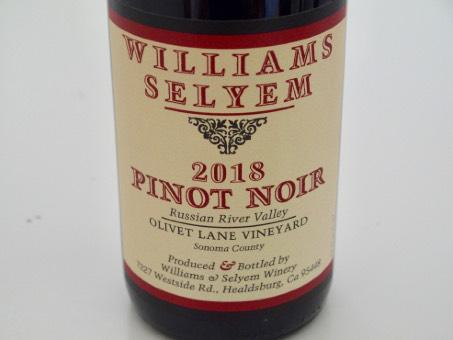 2018 Williams Selyem Olivet Lane Vineyard Russian River Valley Pinot Noir 14.1% alc., $78. · Moderately dark garnet color in the glass. Aromas of beef bouillon, chamomile tea, and cardamom spice. Mid-weight flavors of black cherry, blackberry and chamomile tea leaves. Nicely balanced with gracious tannins and a long, quenching finish. Rather exotic and unique. I have never encountered the aroma or taste of chamomile in a Pinot Noir prior to this. Pinot Noir always provides surprises. Score: 92
Porter Creek Hillside Vineyard
Location: Westside Road in Healdsburg adjacent the MacMurray Ranch
The Hillside Vineyard was planted to Martini clone on St. George rootstock in 1974. Many of the original vines have been in continuous production making it one of the oldest Pinot Noir vineyards in the Russian River Valley. Revitalization efforts have been ongoing with vine-by-vine interplanting and soil improvement. The vineyard was certified organic and Biodynamic in 2003. Founder George R. Davis purchased the 34-acre ranch in 1979. The property had young Pinot Noir vines that would become the Hillside Vineyard. A self-taught winemaker, George improved the existing vineyards and planted additional acreage. He converted a barn on the property to wine production in 1982 and began producing his own wines under the Porter Creek label. His son, Alex, studied winemaking and worked multiple vintages in Burgundy, and is currently the winemaker and vineyard manager. John Haeger, author of Pacific Pinot Noir (2008), who knows a thing or two about Pinot Noir, said in that book, “Porter Creek is making, bar none, some of the most stunning Pinots in California.” Alex notes that many of the past bottlings of Hillside Vineyard Pinot Noir are still drinking well with 20 years or so of age on them. Porter Creek wines are sold through the winery’s website store at www.portercreekvineyards.com. Tasting is by appointment.
 2016 Porter Creek Hillside Vineyard - Old Vine Russian River Valley Pinot Noir 12.9% alc., $72. · Moderate garnet color in the glass. Intoxicating aromas of Bing cherry, baking spice and red rose petal. A delicious infusion of dark cherry goodness with a hint of cola greets the palate. Impeccable harmony with very fine-grain tannins and a welcome nerve of acidity. Mid-weight in richness, endlessly gentle, with a refreshing finish that leaves you wanting more. The wine holds up beautifully over time in the glass predicting age-worthiness. Porter Creek is one of the most under-the-radar producers of ultra premium Pinot Noir in California. Score: 95
Precious Mountain VineyardLocation: West Sonoma Coast near Fort RossOwner: Donnie and Linden Schatzberg Initial planting: 1973 Acres: 5.2 Scion: Various heritage selections The Schatzbergs homesteaded 40 acres of a former sheep ranch on a ridge top at 1,530 feet elevation in 1970. They have planted grapevines, a few at a time, since 1970. The original dry farmed Pinot Noir consists of various clones and selections grafted onto Gewürztraminer roots. Since 1996 Pommard clone has been planted exclusively. Precious Mountain has had a partnership with Williams Selyem since 1996 when a chance phone call to Burt Williams created a single contract to sell nearly all grapes to the winery over the following harvests. The 2017 Williams Selyem Precious Mountain Pinot Noir ($105) is sold through a mailing list at www.williamsselyem.com. I have reviewed many Williams Selyem wines through the years but have not sampled the Precious Mountain Vineyard bottling since the 2007 vintage.
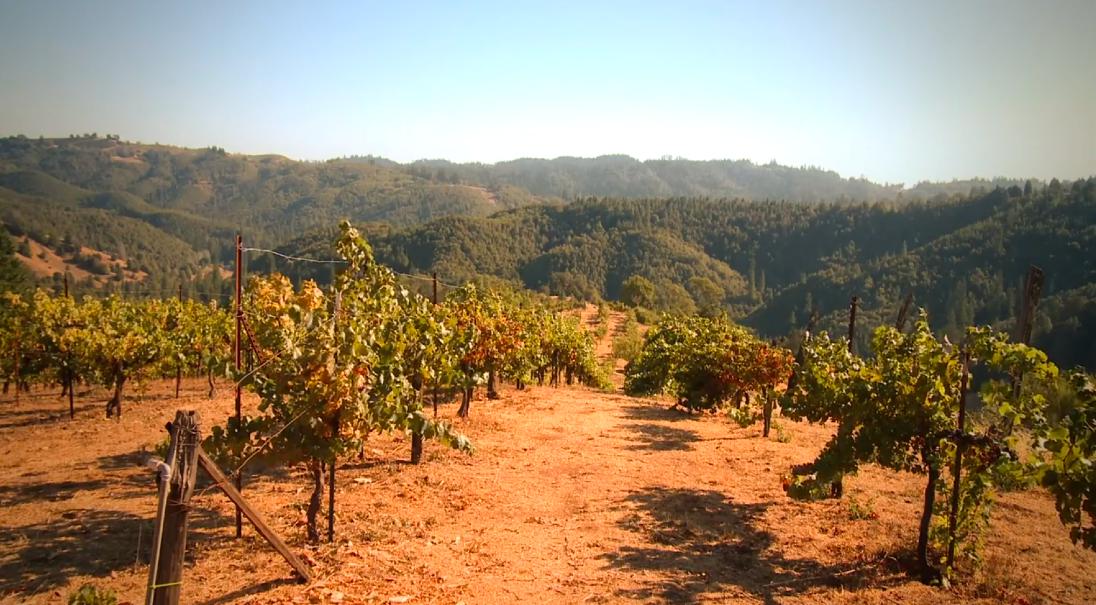
Quail Hill Vineyard Block 2
Location: Sebastopol, Russian River Valley
Quail Hill Vineyard Pinot Noir was first planted in 1974 according to Tom Dehlinger who assisted in the acquisition of the cuttings. These vines in Block 2 are some of the first established in the Russian River Valley with budwood from Joe Swan and Block 2 is the only remaining block of Pinot Noir from the original Quail Hill plantings. The original Swan vines are on St. George rootstock. Phased replanting involving 71% of the Quail Hill Vineyard was undertaken in 1996, but the 2 acres of Swan selection Pinot Noir dating to 1974 was retained. An additional 1.2 acres of Swan selection was planted in 1997 as Block 12 using budwood sourced directly from the original vines. The grapes from these original vines were sold to Tony Soter at Etude and Merry Edwards until Lynmar began making its own wine in the early 1990s. The Swan selection grapes were blended into Lynmar’s Quail Hill Cuvée and Quail Hill Vineyard wines until 2009 when a separate Old Vines Pinot Noir was bottled. The Swan selection old vines of Block 2 are located at the top of the hill above the winery and Block 12 is just below the winery in the following photo of the Quail Hill Vineyard.
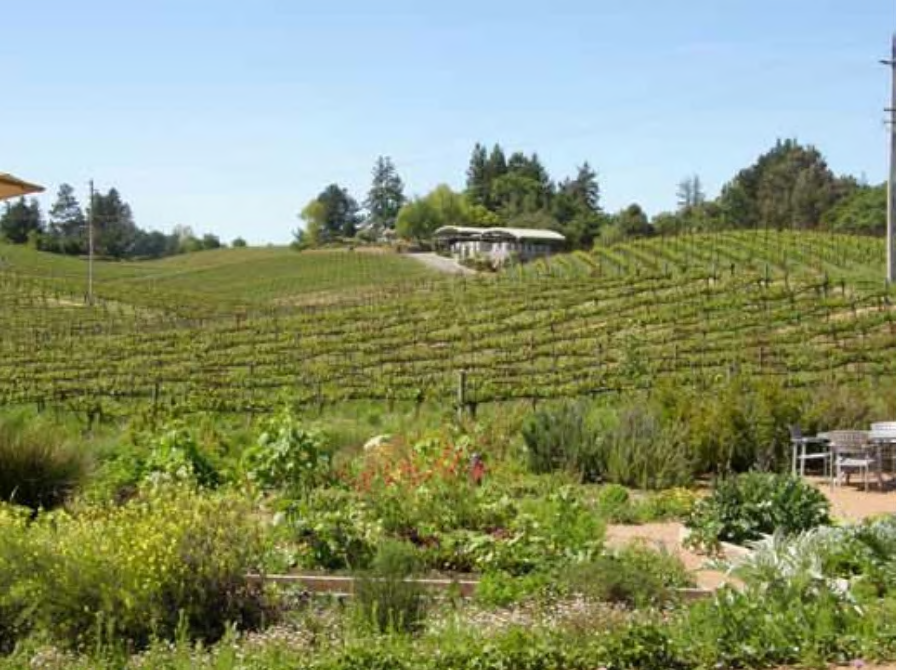
My last review of an Old Vines bottling was from the 2016 vintage in November 2018 and most recently the 2017 vintage in August 2020. The 2014 vintage was given a score of 95. The Quail Hill Vineyard Old Vines Pinot Noir is allocated to Advocate Club wine club members. Visit www.lynmarestate.com. On a number of occasions when I have barrel tasted at Lynmar Estate, the Old Vines Pinot Noir from Block 2 is always my favorite wine in the cellar.
2016 Lynmar Estate Old Vines Quail Hill Vineyard Russian River Valley Pinot Noir 14.5% alc., pH 3.57, TA 0.60, 251 cases, $80. Aged 11 months in French oak barrels, 64% new. · Dark garnet color in the glass. Gorgeous aromas of black cherry, ripe strawberry and balsam. The wine floods the mouth with carnal energy, featuring flavors of black cherry and black raspberry. There is commendable harmony with both pleasing tannic power and uplifting acidity. There is only a dusting of oak. I sense that this wine needs a few years in the cellar to reveal all of its charms. Score: 93
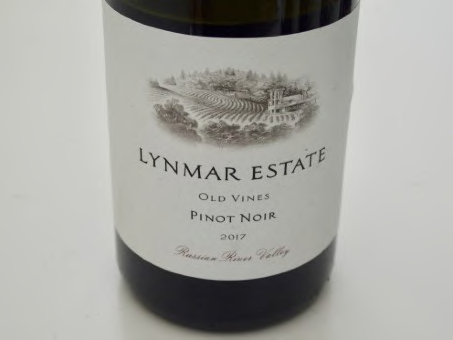 2017 Lynmar Estate Old Vines Quail Hill Vineyard Russian River Valley Pinot Noir 14.5% alc., $80. · Moderate garnet color in the glass. Charming aromas of cherry, rose petal and baking spices. I love the floral aspect of the nose, like wild cherry sprinkled with flowers. Mid-weight flavors of black cherry, black raspberry, blackberry and dark chocolate address the palate without overreaching.The mouthfeel is luxurious, the tannins are in line and the finish is long and rewarding. Still exceptional when tasted the following day from a previously opened bottle. An old vine treasure. Score: 95
California Old Vine Pinot Noir Vineyards: Sonoma/Napa Counties - R-W
Larry Walker, wine journalist
Rhinefarm Vineyard
Location: Sonoma Valley
Gundlach Bundscu is the oldest family-owned and operated winery in California (bonded winery 64, established March 12, 1958. Pinot Noir is the winery’s second-largest crop after Cabernet Sauvignon. Of the 47.5 acres planted to Pinot Noir, 80% are Dijon clones 115, 667 and 777 and Pommard clone, and 20% are 45+-year-old heritage selections. According to John Haeger, the winery’s Rhinefarm Estate Vineyard contains 14 acres of heritage selection plantings that date from the 1970s. Rhinefarm was extensively replanted between 1969 and 1973 and was expanded by the acquisition of adjacent land in 1970 and 1973. With this acquisition came a master transition plan for the vineyard and a commitment to raise the wine quality ambitions. Rhinefarm now has 320 acres under vine. The vineyard is located on the southwestern slopes of the Mayacamas Mountains. Pinot Noir is grown across the street from the Carneros AVA border. It shares cooling effects of the fog from San Pablo Bay to the south and the Petaluma Gap to the west. The soil is 18”-30” Huichica clay topsoil with pockets of gravelly sediment deposited over centuries by the adjacent Arroyo Seco Creek. The distinct block of 45+-year-old heritage wines is harvested for a limited barrel selection bottling of Heritage Selection Pinot Noir. The wine is available exclusively through allocation. Visit www.gunbun.com.
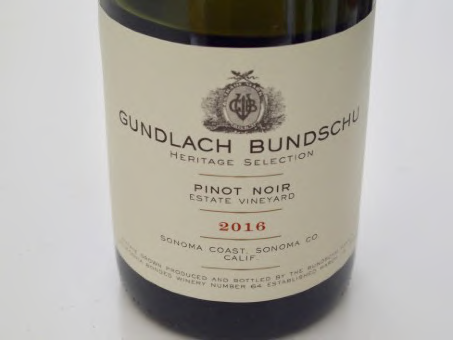 2016 Gundlach Bundschu Heritage Selection Sonoma Valley Pinot Noir 14.5% alc., pH 3.85, TA 0.56, $65. Aged 10 months in French oak barrels, 40% new. · Moderately light garnet color in the glass. The nose opens slowly to reveal aromas of black cherry, blackberry, rose petal and vanilla. Very ripe fruited and husky in style, with sappy flavors of black cherry and blackberry fruit with an accompaniment of loamy earth and peat notes. Their is a modest oak veil offering a touch of vanilla. Velvety in the mouth with a hint of alcoholic warmth on the generously fruited finish. Score: 90
Ritchie Vineyard
Location: Russian River Valley Laguna Ridges
This Ritchie Vineyard is located just down the street from the Swan Trenton Estate Vineyard at the intersection of Eastside Road and Eastside-Healdsburg Road in the Russian River Valley. This 65- acre property was planted in 1972 to Old Wente Chardonnay and Martini Pinot Noir on AxR rootstock. The 3-acre block of original Pinot Noir plantings is still producing but some vines have been replaced due to problems with Pierce's Disease (Kent estimates more than 50% of the vines are original). This iconic vineyard is situated adjacent to a volcanic cinder cone that accounts for its unique soil composition. The topsoil is Goldridge with underlying pumice not found elsewhere in the Russian River Valley. Winemakers swear that this soil gives the wines from this vineyard a prominent minerality. The original vine block of Pinot Noir is sourced exclusively by Nicolai Stez, owner and winemaker of Woodenhead Vintners who bottles a Pinot Noir from these Pinot Noir grapes and named "Cinder Cone." Nicolai was a long-time assistant to Burt Williams at Williams Selyem. I recently tasted several vintages. The wines are consistently excellent. If you liked Burt Williams' Williams Selyem Pinot Noirs, you will like these wines. Visit the Woodenhead Vintners website for availability: www.woodenheadwine.com.
2010 Woodenhead Ritchie Vineyard Cinder Cone Russian River Valley Pinot Noir 14.0% alc.. · Dark garnet color in the glass. Nicely perfumed with aromas of black cherry, cassis and purple grape with a compliment of seasoned oak. Mid-weight plus in style, with a bombastic core of black cherry fruit backed by mild supportive tannins.Silky in the mouth with a moderately long finish. Impressive fruit presence after ten years and has the balance to drink well for another 5 years at least. Score: 93
2012 Woodenhead Ritchie Vineyard Cinder Cone Russian River Valley Pinot Noir 13.8% alc.. · Moderately dark garnet color in the glass. Welcoming aromas of black cherry, dried brush, cardamom spice and dried rose petal. The flavors of well-ripened black cherry and blackberry come together in a mid-weight plus style that benefits from gracious tannins and subtle oak. Easy to like, with excellent harmony and an exuberantly fruity finish. Score: 93
2013 Woodenhead Ritchie Vineyard Cinder Cone Russian River Valley Pinot Noir 13.0% alc.. · Dark garnet color in the glass. Intoxicating aromas of black cherry, spice cabinet, floral goodness and seasoned oak. Sleek and comforting in the mouth with reserved tannins and a juicy acid undertone. The mid-weight plus flavors of black cherry, strawberry and cola impress as does the lengthy, sweet cherry finish. Score: 94
2014 Woodenhead Ritchie Vineyard Cinder Cone Russian River Valley Pinot Noir 13.0% alc., $65. · Dark garnet color in the glass. A Pinot nose to die for, with the perfume of black cherry, spice and rose petal. Nothing is out of place in this mid-weight plus styled beauty offering layers of gregarious dark cherry and purple berry fruits that caress the palate with silkiness. Impeccable harmony and a lengthy finish that provides a juicy citric edge. This wine tastes damn good just like mothers milk. Score: 95
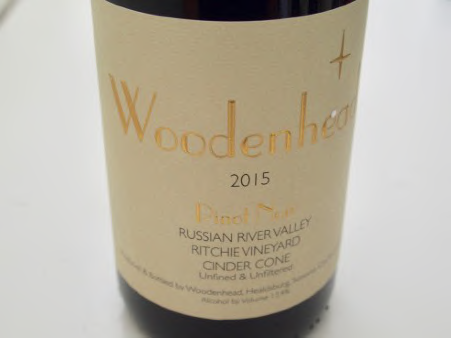 2015 Woodenhead Ritchie Vineyard Cinder Cone Russian River Valley Pinot Noir 13.4% alc., $65. · Dark garnet color in the glass. Leading off are enticing scents of dark cherry and berry and forest floor. Full-bodied in style, with a reaching, expansive core of spiced black cherry fruit that keeps opening and opening in the glass. Richly endowed with fruit sap yet endlessly gentle. Ready now for prime time with ripe, gracious tannins and a very long finish brimming with fruit goodness. Score: 95
School House Vineyard
Location: Spring Mountain, Napa Valley
John O. Gantner (John Sr.) acquired 160 acres on Spring Mountain in 1938. He had been looking for property in the Mayacamas Mountains at the urging of his college fraternity brother at Stanford University, John Daniel, who became the owner of Inglenook Vineyards. John Sr. loved Burgundy wines and decided to plant Pinot Noir in the School House Vineyard, acquiring the budwood (rumored to be from Domaine Romanée-Conti) from John Daniel. André Techelistcheff had advised Daniel to pull out his Pinot Noir plantings believing that the Napa Valley floor soils were too vigorous for Pinot Noir vines. Tchelistcheff was encouraging local growers to remove other varieties and replace them with Cabernet Sauvignon. In 1952, Daniel removed his acre of Pinot Noir in Rutherford and donated budwood to John Sr. The original vines on the School House property date to the 1870s and were a field blend. At the time of John Sr’s purchase, there were 30 acres under vine and the vineyard had been previously managed with horses. It had been neglected for years and the vineyard was overgrown with poison oak, wild roses and brush. He managed to take back the property from the woods and brush, working for over ten years to restore its former glory as a viticultural oasis. Today, some of the field blend wines have been replanted and a School House Zinfandel-based Mescolanza and Syrah-based Mescolanza are produced as a modern interpretation of the field blend. The vineyard was named after a small one-room schoolhouse built on the property in 1881. John Sr’s family lived in the schoolhouse for several years after acquiring the property but it burned down in 1986. John Sr. passed away in 2002. I recently spoke with John M. Gartner (John Jr.) and he remembers that the original planting was in 1952 and 1953 when John was 13 years old. He helped dig the holes and plant the vines. Emmolo Nursery, founded in Rutherford by Salvatore Emmolo in 1923, provided the St. George rootstock and did the budding. If John Jr.’s recollection is correct and I have no reason to doubt him, the 1952-1953 School House Vineyard original plantings of Pinot Noir are the oldest producing Pinot Noir vines in California along with the Ambassador’s 1953 block at Hanzell that was also planted in 1953. Interestingly, the Zellerbachs, who owned Hanzell, and the winemaker at Hanzell, Bob Sessions, were friends of John Sr. and traded cases of wine with each other every year.
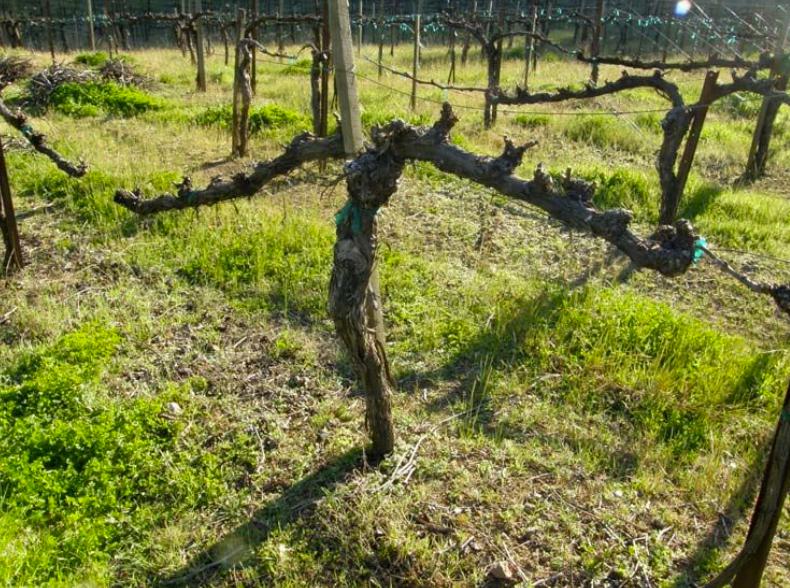
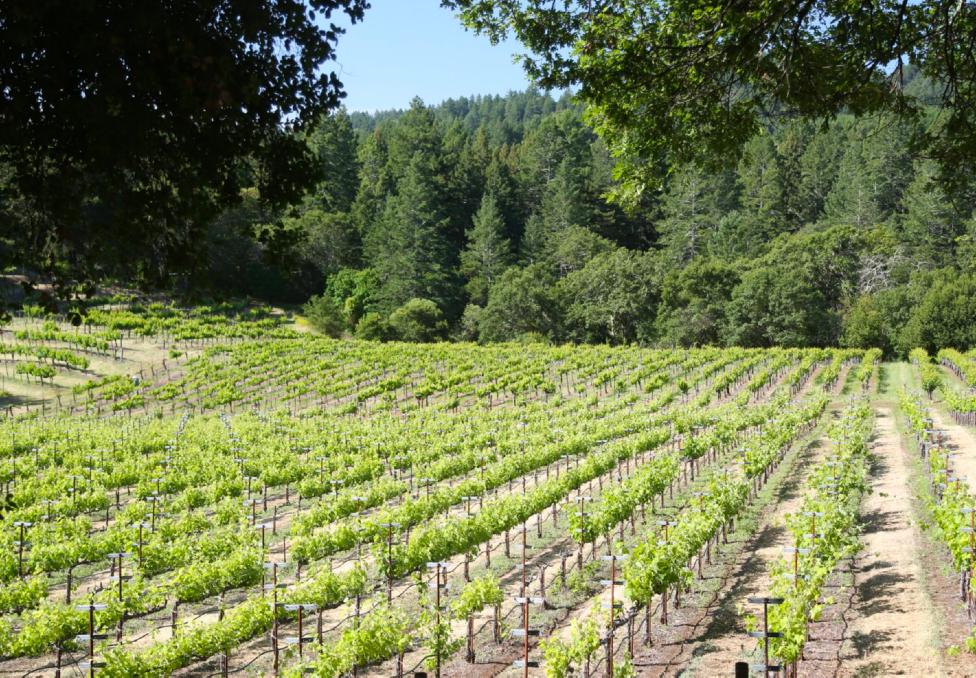
The first School House Vineyard Pinot Noir was released in 1957, making the winery one of the longest continuously operating wine producers in the Napa Valley. Chardonnay was planted in the late 1960s using budwood from Fred McCrea’s Stony Hill Vineyard Currently, 12 acres of vineyard are farmed including 6 acres of old vine Pinot Noir supplemented with 1 acre of 18-year-old vines and 1 acre of 14-year-old vines. Additional vine-by-vine plantings of Pinot Noir using the original budwood within the past 18 years are mostly on 110R rootstock. John Jr. told me recently that in the 2019 vintage, about 35% of the vines are at least 50 years of age with additional vines over 40 years old. The vineyard is located in a uniquely cool microclimate at 1,500 feet elevation with well-drained soils making it one of the few successful Pinot Noir growing sites in the Napa Valley. John Jr. followed his father to Stanford University and practiced law in San Francisco for 35 years before retiring to the School House Vineyard property in 1992. Jr and Nancy Walker have farmed the School House Vineyard ever since. They live on the property and John has done much of the vineyard work by hand. John had been coming to his father’s property practically every weekend since he was born and his viticulture knowledge has been acquired through years of experience and interaction with neighboring winegrowers on Spring Mountain. He remembers drinking a variety of wines growing up at the family dinner table and recalls tasting the wines of Martin Ray as a comparison to their own School House Pinot Noir. The family was struck by the variability of Ray’s wines (something many others have noted), and John Jr. told me, “They could be very good or very bad, but you could never tell him that.” The School House Pinot Noir was initially vinified at Stony Hill (a bottle of 1959 vintage vinified at Stony Hill Vineyard that John Jr. showed me follows), then Buena Vista Sonoma and subsequently at other wineries. Several winemakers were involved including André Tchelistcheff, Ric Forman, Mike Chellini and Bo Barrett of Chateau Montelena. The School House Vineyard wines have been crafted at Pride Mountain Vineyards since 1997, initially under the direction of winemaker Bob Foley and now custom crushed by the current Pride winemaking team headed by Sally Johnson.
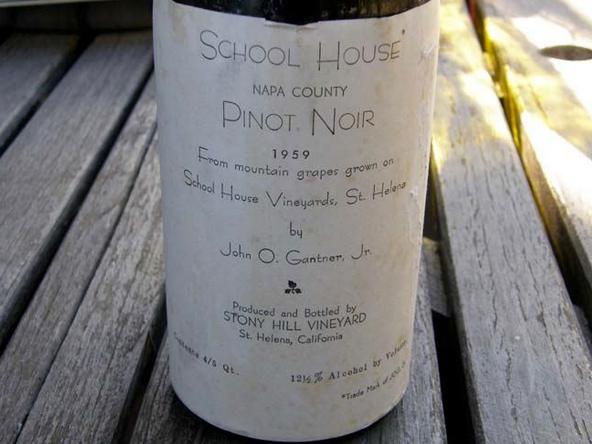 The 2007 School House Vineyard Pinot Noir, now sold out, was the 50th vintage of this wine. The wines have proven to age remarkably well despite the variety of wineries and winemakers involved in production through the years. Consistency has been a hallmark of the wine, a testament to the unique terroir of the site, its dry-farmed vines, and the lack of nod to modernization. The School House Vineyard Pinot Noirs are not California mainstream Pinot Noirs but are terroir-driven, unique wines that can only be understood and valued in the context of their origin from this historical vineyard. Today, about 3,000 cases of four wines are produced: Pinot Noir, Chardonnay, and the two Mescolanza red blends. The wines are sold only through a mailing list at www.schoolhousevineyard.com. Tasting is by appointment at the vineyard property. To read more about the fascinating history of School House Vineyard consult www.napawinelibrary.com/reports/2009/summer/gantner, www.napawineproject.com/schoolhouse- vineyard/ and www.princeofpinot.com/article/1202/ titled “School House Vineyard, Cult Before Cult was Cool.”
2015 School House Vineyard Napa Valley Pinot Noir 13.6% alc., $70. Small percentage of whole cluster. Aged 18 months in 100% new French oak barrels. Bottled unfined and unfiltered. · Moderate garnet color in the glass. Unusual aromatic profile, offering scents of black cherry syrup, spice, turned earth and exotic floral notes. Mid-weight plus in style, featuring a sappy core of fresh black cherry and black berry fruits with a spice, floral and earthy tone in the background. Mild, gritty tannins show up on the persistent and intensely fruity finish. Oak plays a supportive role. When tasted the following day from a previously opened and re-corked bottle, the wine seemed more harmonious, with less tannin evident and a more lengthy finish. Score: 94
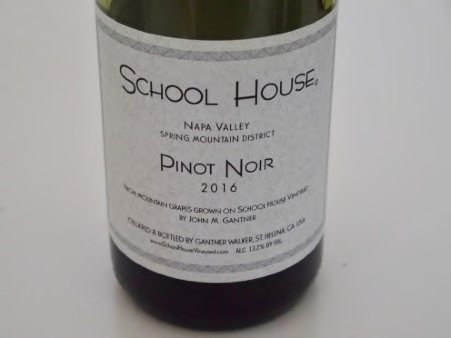 2016 School House Vineyard Napa Valley Pinot Noir 13.2% alc., $65, 1.5 L $130. Small percentage of whole cluster. Aged 18 months in 100% new French oak barrels. Bottled unfined and unfiltered. · Moderately light garnet color in the glass. Welcoming aromas of black cherry, dark red rose petal and a compliment of fresh oak. My notes start with “Wow!” Black cherry and raspberry fruits really pop in the mouth, becoming expansive and holding court through a very long finish. Fully integrated tannins with a very sleek texture. Enviable balance. When tasted the following day from a previously opened and re-corked bottle, the fruit showed even more intensity and persistence while a savory dried herb and earth note showed up. This wine makes a remarkable first impression and then returns over time to offer more glorious Pinot love. Score: 96
Summa Vineyard
Location: Taylor Lane west of the town of Occidental in the West Sonoma Coast
This vineyard was first planted by Steve Young in 1979. The original 2 acres of vines included Pinot Noir, Chardonnay, and Gewürztraminer but the latter two varieties were grafted over to Pinot Noir soon after the 1979 planting. The source of the original Pinot Noir plantings has been subject to considerable conjecture over the years. Scott and Joan Zeller acquired the vineyard in 1982 and farmed it until Thomas Rivers Brown bought it in September 2010. The Zellars either do not know or decline to disclose the plant material origins. Burt Williams, who crafted Pinot Noir from Summa Vineyard from 1988 to 1997, suspected the original vines were a Swan selection. In 1998, an additional 3 acres of Pinot Noir were planted on resistant rootstock using cuttings from the old vines and these plantings are referred to as Summa Young Vines. In 2005 and 2009, an additional 1.5 acres of Pinot Noir was planted adjacent to the Zeller’s residence using old vine budwood , and this block is known as the Driveway Block New Vines. Since 2015, Thomas has removed underperforming, severely diseased, dead and tractor-damaged vines at the rate of five to six vines per year, interplanted among the old vines and planted a Calera selection. Yields were minuscule in the early years of this vineyard's existence. Williams Selyem was only able to produce a Summa Vineyard bottling in 1988, 1991, 1995, and 1997. Declassified lots of Summa Vineyard grapes were blended into the Williams Selyem Sonoma Coast bottling in other years. The 1991 and 1995 vintages of Williams Selyem Summa Vineyard Pinot Noir are legendary. I reviewed the 1995 vintage years ago: www.princeofpinot.com/winery/154/ Prior to Thomas' acquisition of the vineyard in 2010, grapes were sold to Rivers-Marie, Mueller Winery, Brogan Cellars and Littorai. Since 2010, Summa Vineyard has been a monopole of Rivers- Marie and both a Summa Vineyard Sonoma Coast Pinot Noir (now 22-year-old vines) and a Summa Vineyard Old Vines Sonoma Coast Pinot Noir have been offered to a mailing list: www.riversmarie.com. I have reviewed practically every Rivers-Marie Summa Old Vines Pinot Noir from 2002-2018: www.princeofpinot.com/winery/585/
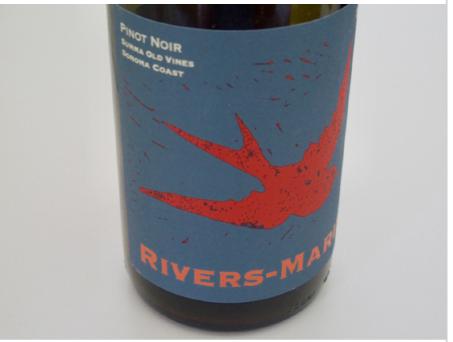 2018 Rivers-Marie Summa Vineyard Old Vines Sonoma Coast Pinot Noir 13.3% alc., 210 cases, $80. Harvest Brix 23.8º. · Moderately light garnet color in the glass. The enticing hose is a wonderland of aromas including cherry, spice, forest floor and pine needles. The dreamy texture makes an impression immediately. Very enjoyable upon opening in a light to mid-weight style featuring a core of well-spiced redder fruits. A stellar wine with engaging freshness and gossamer tannins, finishing unusually long. There is something about this wine that is hard to put into words but you know it is special. Perhaps it is the fact that it offers complexity rather than brute sap. Most certainly, it is the forty-year-old vines speaking. In any case, this beauty has the balance to age for many years and I am sure will brings many oohs and ahas down the line. Still magnificent when tasted the following day from a previous opened bottle. Score: 95
2008 Rivers-Marie Summa Vineyard Old Vines Sonoma Coast Pinot Noir 14.1% alc., Magnum. I reviewed this wine in June 2010 and raved about it: · “Enticing perfume of fresh red cherries and berries with nuances of dark chocolate, Moroccan spices, anise, smoke and savory herbs. The fruit is robust, virile and mouth coating and persists through a generous finish.” I tasted the wine again in July 2012, “Delicious black cherry core with very slight creosote and smoke flavors.” I also tasted the wine in March 2017: “Still rather bold with a copious core of very ripe cherry and berry fruits with a riff of smoke taint in the background.” This magnum was tasted recently. The wine opens initially with aromas of black cherry, mocha and stem but becomes flat rather quickly. Mid-weight plus in style and creamy on the palate with layers of black cherry, blackberry and pomegranate flavors framed by silken tannins. There is clearly some smoke taint evident on the finish. Many Sonoma Coast Pinot Noirs suffered smoke taint from wildfires in 2008. When tasted initially, this wine was terrific, but with age, smoke-tainted Pinot Noir tends to become less fruity and displays more evidence of creosote, something evident in this magnum tasted in 2020. That said, the wine was still quite enjoyable and probably only a wine critic would find fault in the wine. Score: 90
The Knoll Vineyard
Location: Anderson Valley
Husch Vineyards planted the first Pinot Noir vines in the Anderson Valley and established a winery in 1971 making Husch the oldest licensed winery in Anderson Valley. Tony and Gretchen Husch bought the 60-acre Nunn ranch located between Philo and Navarro on Highway 128. They planted rootstock for Pinot Noir in either 1968 or 1969 and field grafted The Knoll in 1971. At the time, it was more common to plant roots first and then graft the variety a couple of years later.
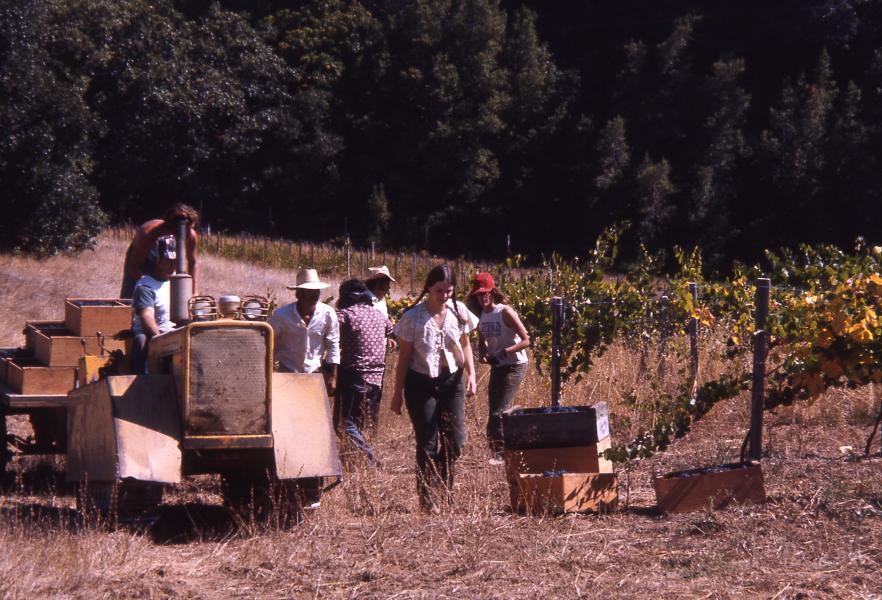
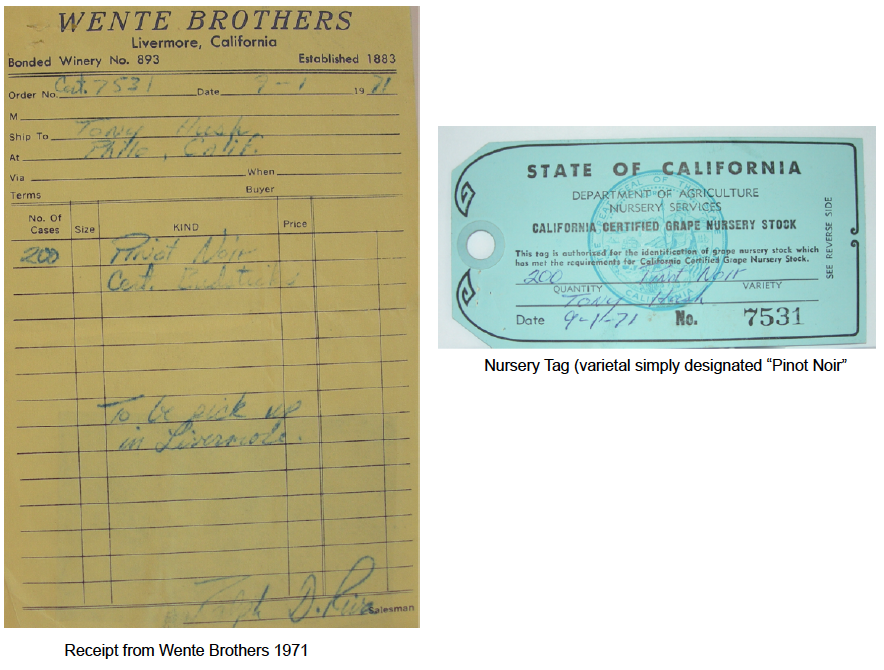
Hugo Oswald, Jr., a neighboring grape grower, bought the Husch Winery from the Husch family in 1979 and today the property remains owned and operated by the third generation of the Oswald family: Amanda Robinson Holstine and Zac Robinson. Vineyard manager Al White has been at Husch since 1974. Interestingly, Zac told me is that not only was The Knoll the first planting of Pinot Noir in the Anderson Valley, it was the first planting of any red varietal that could ripen reliably. Economically, however, Pinot Noir was a dud! Zac’s records show that Gewürztraminer was far more valuable in the 1970s. The Knoll Vineyard site is a south-facing outcrop of sandstone with shale lenses and good drainage planted originally in 1971 and affectionally known as “The Knoll.” Interplanting of The Knoll Vineyard with Dijon 667 began in 2001. Most of the original vines are still in production. I have reviewed The Knoll Vineyard Pinot Noir from 2004, 2005, 2009, 2010 and 2013 vintages: www.princeofpinot.com/vineyard/169/. The 2017 Husch Vineyards ‘Knoll’ Anderson Valley Pinot Noir is available on the winery’s website at www.huschvineyards.com
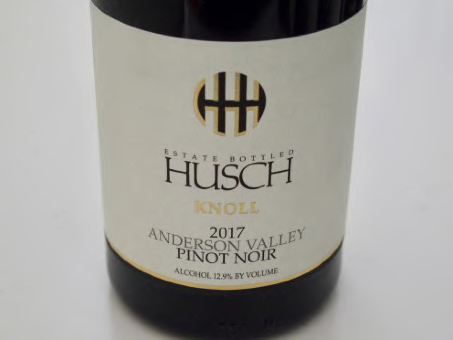 2017 Husch Vineyards Knoll Anderson Valley Pinot Noir 12.9% alc., pH 3.50, TA 0.60, 504 cases, $42. · Harvest Brix 22.6º. 25% whole cluster. Aged 10 months in French oak barrels, 40% new. Moderately light garnet color in the glass. Intriguing aromas of cherry, raspberry, pitch and pine needle. On the palate, there is plenty of tasteful, earth-kissed cherry fruit in a middleweight, agreeable style. Refined and sophisticated, with subtle tannins, a delicate touch of oak and a very long-lasting and juicy finish. The earthiness is very cordial. This wine does not taste like any other wine reviewed for this study of old vine Pinot Noir making it particularly distinctive. In addition, it overdelivers for the price. Score: 95
Three Corner Vineyard
Location: Russian River Valley (Healdsburg)
Three Corner Vineyard was originally part of the Allen Vineyard but was deeded to Joe Rochioli, Jr. by Howard Allen as a favor for farming the Allen Ranch for many years. The vineyard is now one of the Rochioli estate vineyards. About 60%-65% of the original plantings from 1974 are still in production. Later plantings were established using the West Block selection, and Pommard 4 and Dijon 115 clones. Three Corner Vineyard, West Block, Little Hill, Big Hill, River Block and Sweetwater are single block/ vineyard-designated Pinot Noir bottlings only sold through a mailing list at www.rochiolivineyard.com. The 2018 vintage of Three Corner Vineyard is now offered at $90. The 2017 Three Corner Vineyard Pinot Noir was reviewed in May 2020.
2017 J. Rochioli Vineyards & Winery Three Corner Russian River Valley Pinot Noir 14.5% alc., $90. · Moderately dark garnet color in the glass. The nose opens slowly over a few hours to reveal very enticing aromas of red and black cherry, baking spices and forest floor. Mid-weight plus in concentration with flavors of blackberry and black raspberry that make a powerful statement. A little rugged, rustic and earthy early on but when sampled several hours later, the unctuous fruit was more amendable and vivid. The tannins were quite easygoing, the texture was soft and the finish had unusual potency and staying power. Score: 95
Trenton Estate Vineyard
Location: Laguna Road in the Russian River Valley, in a subregion of the Russian River Valley known
as the Laguna Ridges, near the town of Forestville.
The legendary Joseph (Joe) Swan first planted Pinot Noir along with Chardonnay and Cabernet Sauvignon beginning in 1969, replacing a 13-acre plot of run-down Zinfandel that he acquired in 1967. It was Joe’s friend, Andre Tchelistcheff who advised him to plant Burgundy varieties on this site. These original plantings are the oldest producing Pinot Noir vines in the Russian River Valley. The property Joe purchased in 1967 also included a barn and a 100-year-old house that at one time had been the post office and general store for the tiny town of Trenton that is no longer in existence. The Swan Trenton Estate Vineyard, although located only a few miles from the Middle Reach subregion of the Russian River Valley, is cooler, foggier, and wetter than that subregion marked by Westside Road. A Pinot Noir from the Swan Vineyard was sourced entirely from the original 1969 and 1974 plantings from 1973 to 2002. The “Trenton Estate” designation did not appear until 1997. After 2002, some young vine fruit was added. In the mid-1990s, Rod replanted half of the Trenton Estate Vineyard. Today, the young vines have reached enough maturity that the Trenton Estate Vineyard bottling is sourced from all blocks and twelve different planted clones. The Trenton Estate Vineyard also has an acre of Syrah, and a few older Viognier, Chardonnay, and Cabernet Sauvignon vines. Historically, cuttings from Swan’s vines were eagerly sought after, and because of Joe’s generosity, became widely distributed to other California vineyards as the Swan clone (incorrectly) or the Swan selection. It was Francis Mahoney, the founder of Carneros Creek Winery, who coined the term “Swan clone” for the vine mix of Joe’s original plantings. I have reviewed Joseph Swan Vineyards Trenton Estate Vineyard Russian River Valley Pinot Noir from vintages 2001-2010 inclusive and 2013: www.princeofpinot.com/vineyard/175/. No grapes are sold from this vineyard. The winery sells through its mailing list and tasting room: www.swanwinery.com.
Truchard Estate Vineyard
Location: Napa Carneros
The Old Block at Truchard Vineyards was planted to Chardonnay, Pinot Noir, Merlot and Cabernet Sauvignon on the Napa side of Carneros in 1974. Dr Tony Truchard bought a 20-acre prune orchard in 1973 while he was still practicing medicine. Francis Mahoney, of nearby Carneros Creek Winery, assisted with the initial plantings of 20 acres. All grapes were sold exclusively until 1989 when the Truchards began making their own wine. The original plantings of Pinot Noir on St. George rootstock and designated the Old Block, are still producing. When Tony first planted grapes in the early 1970s, Carneros was primarily an area known for sheep and cattle ranches, and farmers were discouraged from planting grapes because of the cool climate, clay soils that did not retain moisture, and meager, salty groundwater. Truchard Vineyards, however, is located in the northeastern corner of Carneros at the base of the southern tip of the Mayacamas Mountains with a diversity of soils including clay, shale, sandstone, lava rock, and volcanic ash as well as various microclimates. With the low water table in Carneros, Tony was one of the first winegrowers to adapt reservoirs for rainwater catchment and drip irrigation. Today, Truchard Estate Vineyard is 383 contiguous acres, of which 270 acres are planted to ten different grape varieties. Visit the winery website to purchase Old Block Pinot Noir: www.truchardvineyards.com.
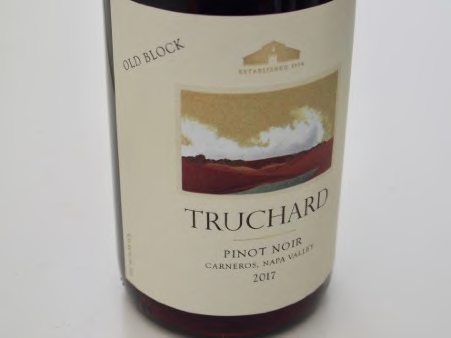 2017 Truchard Old Block Carneros Pinot Noir 14.1% alc., $65. A very limited production wine based on Martini selection planted in 1974 on St. George rootstock. These are some of the oldest producing vines in Carneros. 100% de-stemmed, proprietary yeast fermentation after a 5-day cold soak. 10-day maceration. Aged 10 months in French oak barrels, 45% new. · Moderate garnet color in the glass. Appealing aromas of Bing cherry, cinnamon stick, burnt tobacco and toasty oak rise from the glass. The glorious core of black fruits are expansive and long on the palate. A complex offering, with touches of cola, spice, licorice and earth. Silken in mouthfeel, with an ideal balance of ripe fruit, vital acidity and refined tannins. The wines opens nicely over time in the glass offering its charms in stages. The experience concludes with a very long finish. When tasted the following day from a previously opened and re-corked bottle, the wine was more outstanding grabbing attention with seductive aromas of cherry, rose petal and spice. Score: 94
Van Der Kamp Vineyard
Location: Just below the summit of Sonoma Mountain
This famous reclusive vineyard is planted at 1,400 feet elevation on a north-facing slope overlooking the town of Glen Ellen to the east and Bennett Valley to the northwest. The soil is a reddish volcanic loam, varying from intense rocky slopes above the “Red Shoulder” area to deeper, browner, but still volcanic clay loam in the “Horn Section.” Martin Van Der Kamp has been farming the ranch since the sixties and his son Ulysses is now taken over and employs the latest viticultural techniques. Ulysses says, “It is easy to grow Pinot Noir, that is if you are willing to work twelve hours every day.” The exact date of the original plantings (there have been newer plantings in the 1970s, 1980s and 1990s) of Pinot Noir is puzzling in the absence of documentable event and date. The Van Der Kamp website says that the vineyard has currently producing vines that were planted in 1952. Wine critic John Gilman and winemaker Samantha Poe who crafts a Pinot Noir from the vineyard state the vineyard was planted in 1953. Martin Van Der Kamp recently told Claude Koeberle (Soliste) the following. He recalls a few years ago telling John Haeger (who remembers the conversation differently) that when he bought grapes from Russell Cundiff, the original owner of the property, in the mid-sixties, the vines were already well-established, indicating that they must have been planted in the previous decade. There were about 12 acres of Pinot Noir in five distinctly different blocks, though they might not have all been planted at the same time. Martin used grapes from all five blocks as part of his first sparkling wine cuvée in 1981. He also made a couple of barrels of Pinot Noir in 1970 from Cundiff’s grapes. Russell was well-acquainted with Sebastiani, Bartholomew (Buena Vista), and Zellerbach (Hanzell). There is a good chance the original scion material came from any of them. When Martin acquired the ranch from Russell in 1989, John Wetlaufer could only identify the vines as “old vine Pinot Noir.” Today, the Van der Kamp family still farms two acres of the original vines. Those who visit the 25-acre vineyard site say it has a mystical spiritual aura. Tibetan flags flutter in the breeze while mating pairs of hawks fly overhead. The Marin and southern Sonoma County indigenous tribe, the Coast Miwock, believed that the top of Sonoma Mountain was where life first began. The Van Der Kamp Vineyard and surrounding area is an important religious site.
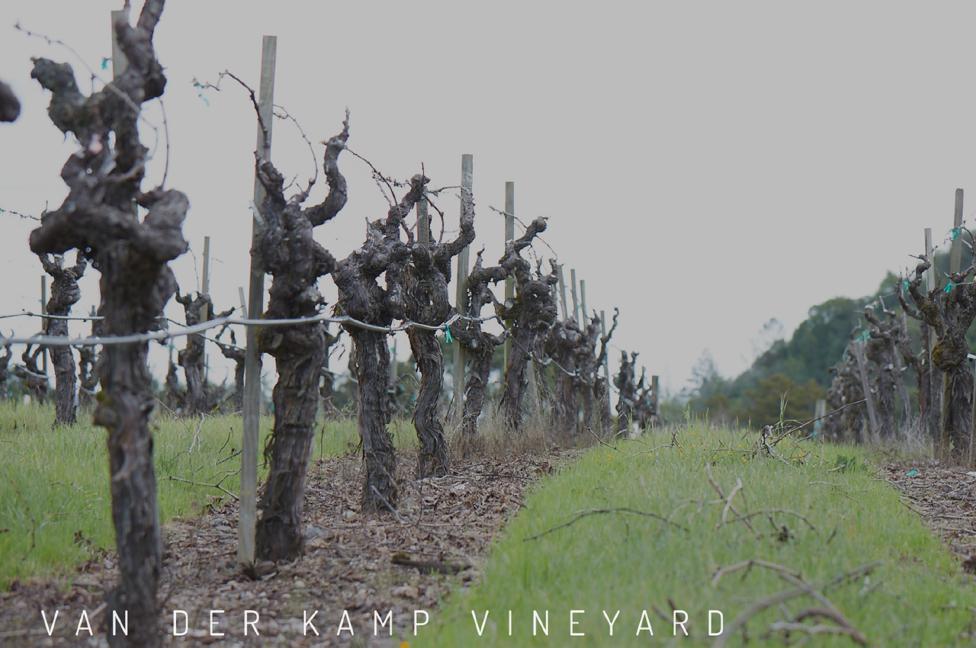 Through the years, Van Der Kamp Vineyard has supplied grapes to many of California’s most notable producers of Pinot Noir including Bjornstad Cellars, Berridge Wines, Cerridwen Wines, La Follette Wines, Landmark Vineyards, La Pitchoune, Poe, Rogstad, Ryan, Siduri, Soliste, Tandem, Tongue Dancer and Vergari. For current releases, visit www.poewines.com and www.duttongoldfield.com
 2017 POE Van Der Kamp Vineyard Sonoma Mountain Pinot Noir 13.0% alc., $45. Said to be from original planting30% whole cluster, native yeast fermentation. Aged 12 months in 30% new French oak barrels. Bottled unfined and unfiltered. · Moderately light garnet color in the glass. Complex nose displaying aromas of black cherry, spice, white pepper, rose petal and earthy flora. Light to mid-weight in style, offering flavors of dark cherry and purple berry with undertones of dried green herbs and pastoral flora. Silky in texture, with modest tannins that leave a slight astringency on the finish. I like this wine for its uniqueness. Score: 92
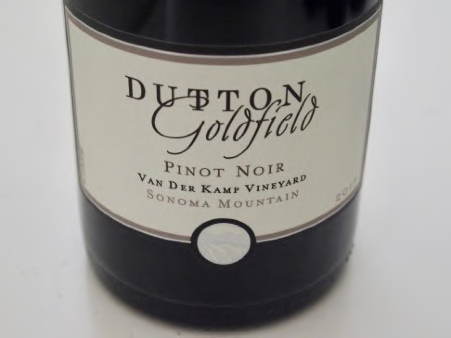 2018 Dutton-Goldfield Van Der Kamp Vineyard Sonoma Mountain Pinot Noir 13.5% alc., pH 3.48, TA 0.64, 253 cases, $68. “La Tache,” “Old” and "828" blocks. 100% de-stemmed, 7-day cold soak, hand punch downs, aged 16 months in French oak barrels, 50% new. · Moderately dark garnet color in the glass. Hi-tone aromas of black cherry, boysenberry, poultry spices and vanilla. Generous earth-toned black raspberry and boysenberry fruits are accented with savory dried sage. The sappy fruit is backed by moderately firm tannins but the finish is not astringent. The silken texture is particularly agreeable. When tasted the following day from a previously decanted and re-corked bottle, there was a subtle green herbaceous note that had been covered up by the fruit load on the first day, but otherwise the wine was stellar. This wine will benefit from time in the cellar to placate the tannins. Score: 93
West Block Vineyard
Location: Russian River Valley (Healdsburg)
The exact clonal pedigree of the original West Block plantings remains a mystery as vine morphology has not been confirmatory, but it is often concluded that the vines are Pommard. The original rootstock was non-phylloxera-resistant AxR1. The initial Pinot Noir plantings at the Rochioli property were typical for the time with a 14-foot spacing between the rows and 8-feet spacing between the vines.
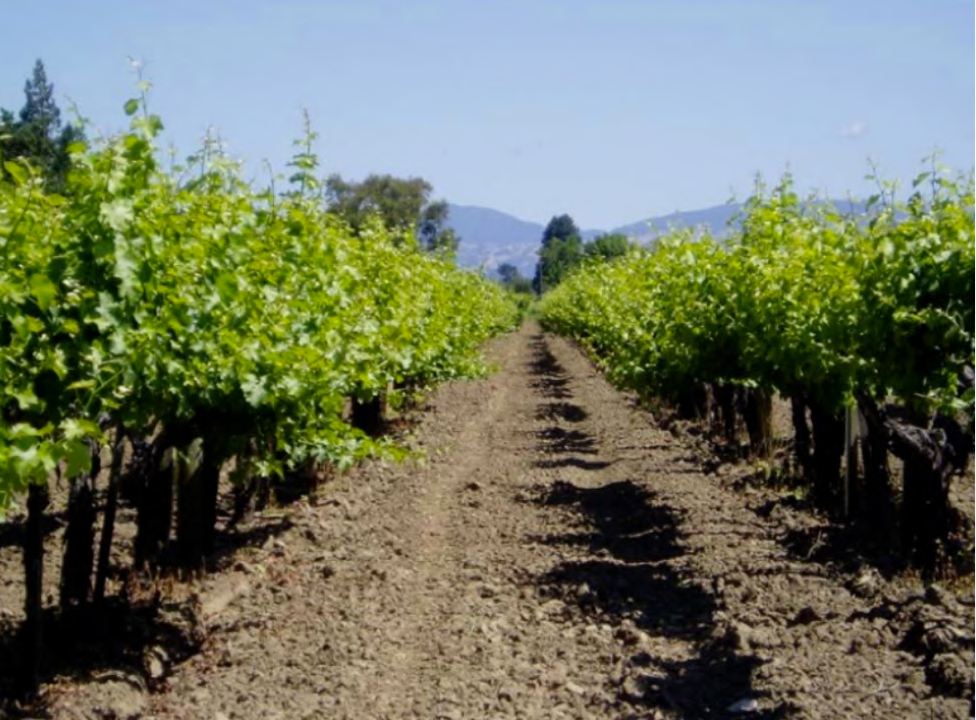
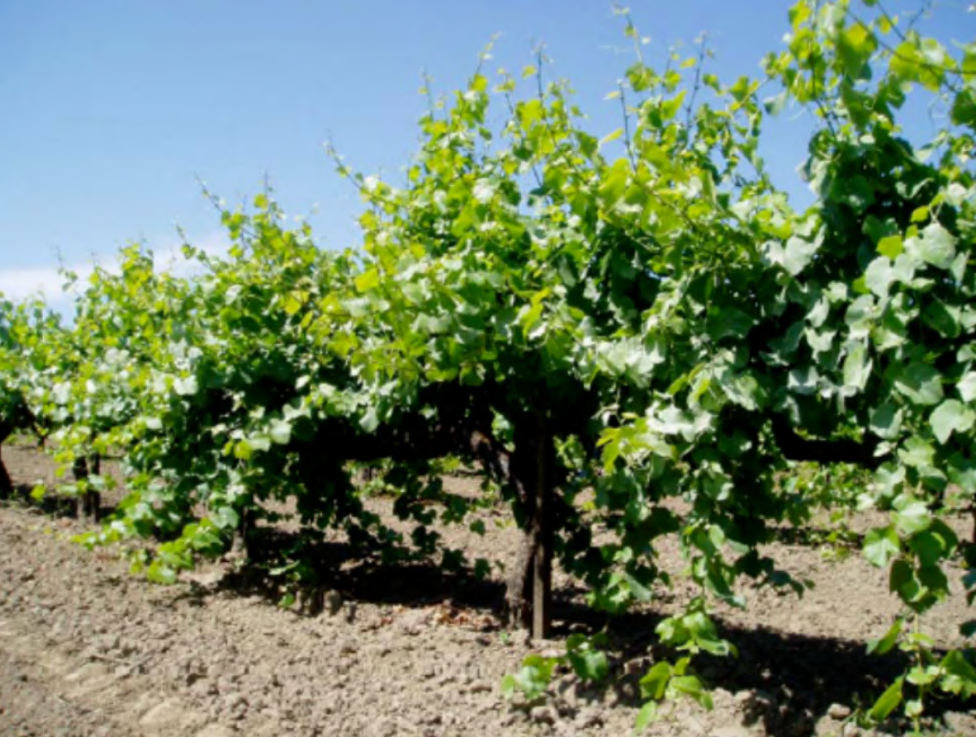
Currently, the West Block is about one-third of its original size but newer plantings at West Block in 2008 added 2.5 acres of West Block selection. Tom Rochioli told me that about 60%-65% of the original vines are still producing grapes. There were some replants prior to 1980 that could be clones other than the original selection (about 10%). Since the early 1980s, all replants have used budwood from the original West Block vines, the so-called. Over the years, Tom has selected vines for desirable cluster size, structure and characteristics, and ones that are virus-free. The cuttings from these vines are often referred to as the “Rochioli clone” although there is no such certified FPS clone. The original West block currently produces very little fruit (yields are typically 1.5 tons per acre) but it has always been Joe Rochioli’s favorite. The East Block planting preceded the West Block planting by two years but the original vines were pulled out in 2008 and replaced with Pommard clone in 2010. J. Rochioli West Block Russian River Pinot Noir is available only to those on a mailing list that currently has a waiting list. The 2018 vintage is priced at $120. The wines are highly valued but do occasionally appear on the secondary retail or auction marketplace. The J. Rochioli Vineyards & Winery website is www.rochiolivineyard.com. Two vintages were tasted in May 2020.
2015 J. Rochioli Vineyards & Winery West Block Russian River Valley Pinot Noir 14.5% alc., 228 cases, $112. · Dark garnet color in the glass. The aromas unfold slowly over time in the glass. When sampled the following day from a previously opened bottle, the wonderful aromas of black cherry, spice and sandalwood had become more accessible. Effusive sap fills the mouth with goodness, offering flavors of black cherry, blueberry and black raspberry with an earthy underpinning. The chewy fruit is framed by toned tannins and lip-smacking acidity making for easy drinking. The finish is very long and intensely fruity. Truly a sublime experience when tasted the following day from a previously opened and re-corked bottle. Score: 97
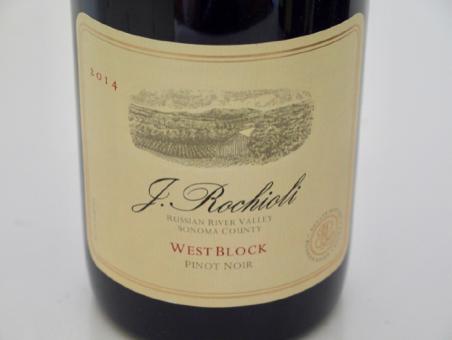 2014 J. Rochioli Vineyards & Winery West Block Russian River Valley Pinot Noir 14.5% alc., 200 cases, $100. · Moderately dark garnet color in the glass. The nose unravels slowly to reveal aromas of black cherry and Asian spices. Full-bodied in a richly endowed style, with a core of black cherry, blackberry and cola flavors. Plush on the palate with enough acidity to cut through the richness. Impressive harmony, with an extremely long and generous finish. Much more giving, even transcendent. when tasted the following day from a previously opened and re-corked bottle. Score: 97
Old Vine California Pinot Noir Vineyards: Santa Cruz Mountains
Jeremy Seysses, Domaine Dujac
Ferrari Family Vineyard
Location: Corralitos
This vineyard has gone through several name transitions from its original name Matteson to Ciradella, then Woodruff Family and now Ferrari Family. When the Woodruff family rehabilitated the vineyard after their acquisition, they kept all of the original vines. Current owner, Tom Ferrari, lives on the property. Viticulturist Prudy Foxx has done some consulting for him. Veteran Santa Cruz Mountains vintner, Jeff Emery, told me its first harvest was 1984 so it was probably planted in 1980. The Big Basin Vineyards website states that the vines were planted over 40 years ago. When I reviewed the 2009 Arista Woodruff Vineyard Pinot Noir in 2011, the wine information sheet stated the vineyard was planted in 1978. John Haeger says the vineyard was developed in stages in the 1980s which is probably the most reliable information. The vineyard is located in Aptos about three miles from the Pacific Ocean surrounded by centuries-old redwood trees. Planted on a steep slope, it is dry-farmed and the vines are rooted in sandy loam over base rock. Currently, Lightpost Winery in Morgan Hill is one of two wineries (the other being Big Basin Vineyards) sourcing the grapes from this vineyard. The 2018 Lightpost Winery Ferrari Vineyards Reserve Santa Cruz Mountains Pinot Noir (163 cases, $69) is available at www.lightpostwinery.com. The wine won Best of Show and 95 points at the San Diego International Wine Competition and rated 92 points and recommended as a Cellar Selection by Wine Enthusiast. The 2017 Big Basin Vineyards Ferrari Vineyard Santa Cruz Mountains Pinot Noir is available through a mailing list at www.bigbasinvineyards.com
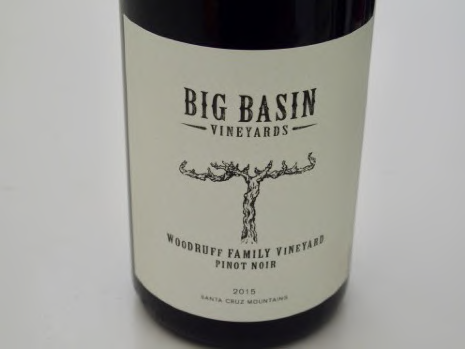 2015 Big Basin Woodruff Family Vineyard Santa Cruz Mountains Pinot Noir 13.0% alc., 80 cases, $65. 100% whole cluster, native yeast primary fermentation, aged 15 months in French oak barrels and bottled unfined and unfiltered. · Moderately light garnet color in the glass. Engaging aromas of cherry, rose petal, burnt tobacco and cardamom spice. Mouthwatering cherry core framed by very fine tannins. Fresh and juicy, with impressive harmony and some length on the cherry-fueled finish. The tannins have largely resolved since last reviewed in 2018. Score: 94
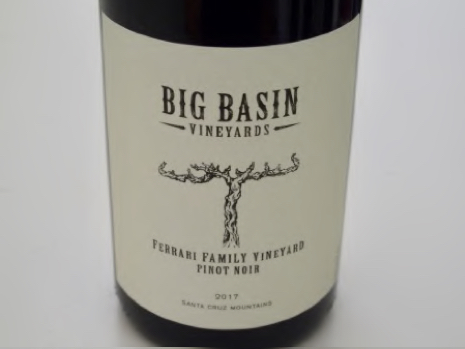 2017 Big Basin Ferrari Family Vineyard Santa Cruz Mountains Pinot Noir 13.2% alc., 200 cases, $60. 100% whole cluster native primary fermentation, and aged 17 months in French oak barrels. Bottled unfined and unfiltered. · Moderate garnet color in the glass. The nose is aloof but pleasant with aromas of black cherry, rose petal and spice. Mid weight plus in style featuring darker cherry, strawberry, raspberry and boysenberry fruit flavors. More ripeness and intensity than the 2015 vintage. The tannins are modest at this point and the finish is generously fruited and lengthy. Still young and aromas haven't fully arrived, but otherwise stellar. Sit on this one for a couple of years for full enjoyment. Score: 94
Legan Vineyard
Location: Corralitos
This vineyard was planted using cuttings from Mount Eden. These own-rooted vines were planted in two phases: the upper hill in 1980 and the lower area in 1990. The hearty vines on this site cling to a steep, eroding sandstone hillside at 1,200 feet elevation, surrounded by a dense forest of redwood trees overlooking Monterey Bay. The original vines, planted with 6’ x 8’ spacing in deep sandy loam soil, have been always dry farmed. Prudy Foxx is the current viticulturist farming the vineyard organically. The Monterey Bay acts as a natural air conditioner for onshore winds, cooling the Corralitos region and allowing for a long, steady growing season. Grapes are sourced by Arnot-Roberts (Duncan Arnot Meyers and Nathan Lee Roberts who founded their winery in 2001 in Healdsburg). The wines are allocated through a mailing list at ww.arnotroberts.com and sold through various retail channels.
 2018 Arnot-Roberts Legan Vineyard Santa Cruz Mountains Pinot Noir 12.0% alc., 275 cases, $60. · Moderate garnet color in the glass. Very floral nose with added sweet wood bark and vegetative aromas. More fruit-driven on the mid-weight palate, offering tart flavors of strawberry, red and purple grape and spice, yet the savory aspects largely override the fruit. The texture is like peach fuzz with integrated filigree tannins that trail off on the finish. A green note is still evident when tasted the following day from a previously opened and re-corked bottle. Score: 88
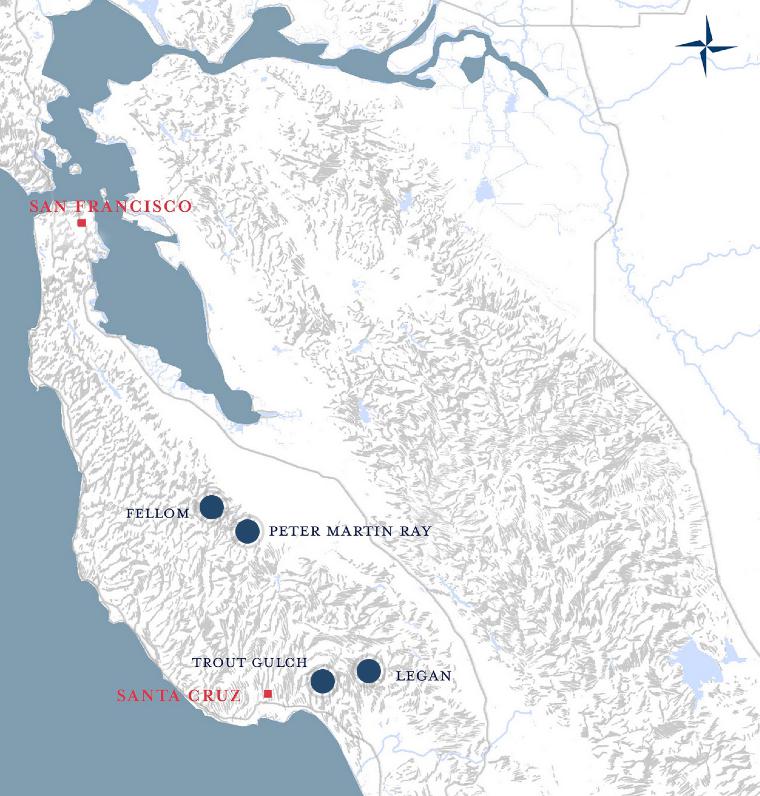
Peter Martin Ray Vineyard
Location: Northeastern Santa Cruz Mountains in Saratoga
Paul Masson left Burgundy and arrived in California in 1878 as a 19-year-old. He bought land in Saratoga and planted Pinot Noir and Chardonnay at his “Mountain Winery” at La Cresta ranch using budwood from Burgundy vines. Masson would be the first winegrower to import and plant Pinot Noir, then use it successfully for his red table wines and “Champagne” sparkling wines. Martin Ray, who was to become a legendary California vintner, lived nearby La Cresta ranch, was befriended by Masson and worked in his winery and vineyards. (Ray was a redhead like me and assumed the nickname of "Rusty" by friends and family as I did growing up) Ray bought Masson’s property and took over the Paul Masson Champagne Company in 1936 at age 32, managing it and producing wine there for seven years. The 60 acres at La Cresta contained a large block of Pinot Noir, along with sizable blocks of Gamay Beaujolais and Chardonnay, and for many years this was the country's sole authentic planting of Pinot Noir. Ray removed the Gamay, replaced it with a mix of varieties and replaced old or diseased vines throughout the vineyard. In 1936, Ray released the country's first 100% pure Chardonnay and Pinot Noir varietals that were priced at four times other California wines of the time. Dr Maynard Amerine, a famed enologist, was asked to name the greatest Pinot Noir he had ever tasted and he replied, "A 1936 made by Martin Ray.” Ray was a fanatical proponent of verifiable content labeling of wines and was single-minded in his striving for wine quality at a time when there was little support for his vision. In time, Masson, who died in 1940, advised Ray to plant vines at the top of the hill at what is now Mount Eden and would become the site of the Martin Ray Winery. Ray also knew that soil drainage would be better at the higher elevation. By the 1950s, the vines planted at Mount Eden using cuttings from Masson's La Cresta vines and bench grafted onto rootstock at a local nursery were mature and producing better wines than those from the old vineyards established by Masson. The Mount Eden Vineyard is now of historical significance as many of today’s modern Pinot Noir plantings have been established with genetic material taken from this vineyard (Mount Eden clone, UCD 37). Paul Masson’s mountaintop vineyard, subsequently owned by Martin Ray, would become the Peter Martin Ray Vineyard under the ownership of Peter Martin Ray, the adopted son of Martin, who replanted the vineyard in 1979-1982. Peter lost the Martin Ray name to a separate company, now the Martin Ray Winery based in the Russian River Valley but kept this vineyard parcel and sold grapes to other winemakers. Peter Martin Ray is now retired and lives in Alaska. Frederic Ballario and Santa Cruz Mountains legend Rick Anzalone manage the 13-acre the vineyard (photo below) Organically farmed with no irrigation, the old, originally stake-trained vines cling to the extremely rocky and depleted Franciscan Shale soils at 1,400 feet elevation. Vine density is 10’ x 10’. The vineyard is adjacent to the hill that is planted to the historic Montebello-Ridge vineyards and overlooks Silicon Valley. The site is highly exposed with nutrient-poor soils, so the vines struggle to produce meager yields. Grapes from this vineyard have been sourced by Arnot-Roberts, Ceritas Wines. Birichino Wines and Jamie Motley Wines but the Pinot Noir is currently only sold to Arnot-Roberts: www.arnotroberts.com. Read more about the fascinating history of this vineyard at www.wineterroirs.com
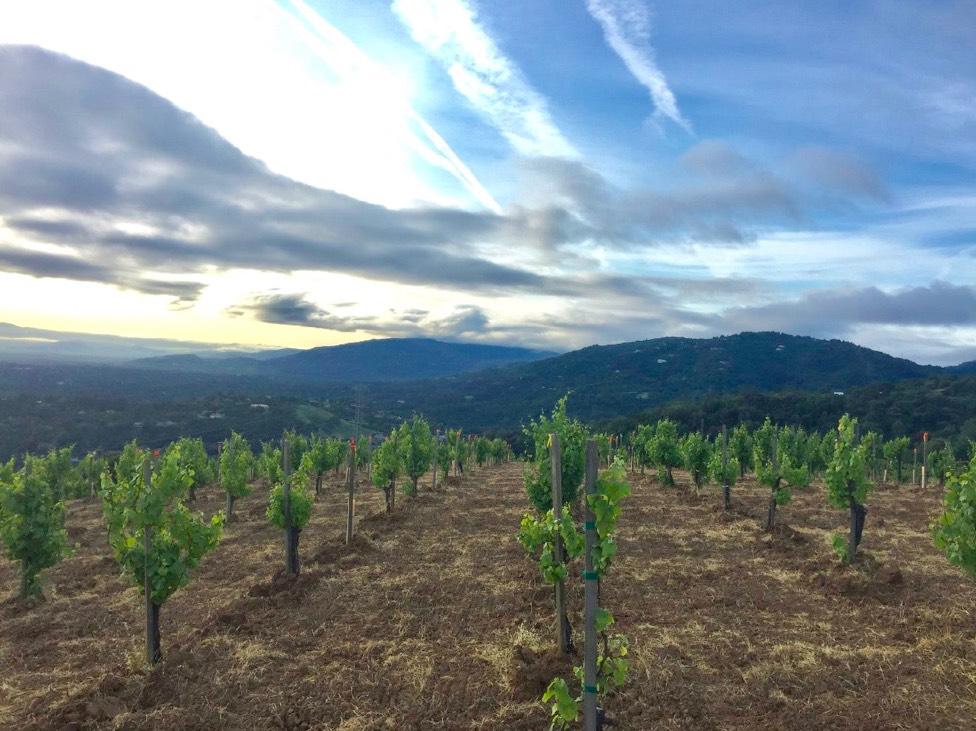
 2018 Arnot-Roberts Peter Martin Ray Vineyard Santa Cruz Mountains Pinot Noir 12.0% alc., 150 cases, $75. · Moderately dark garnet color in the glass. The savory nose features aromas of underbrush, sawdust, rose petal and deeply colored fruits. A robust, thickly-fruited wine offering an intense stream of blueberry-pomegranate fruit with a mild vegetative (green) undertone. Nicely balanced, with delicate tannins and a long, lip-smacking finish. The wine achieved more charm when tasted the following day from a previously opened and re-corked bottle. Arnot-Roberts seems intent on picking Pinot Noir at a lower Brix resulting in a more savory, even slightly green character in the finished Pinot Noir. This was much less evident in this wine compared to the Legan Vineyard bottling even though the final ABV is the same. Score: 92
Trout Gulch Vineyard
Location: Aptos
The Turgeon family produced Pinot Noir and Chardonnay from this vineyard since 1987, but the vineyard is now farmed by Richard Alfaro of Alfaro Family Vineyards & Winery who took over the lease. Richard farms the non-irrigated vineyard with organic methods. The vineyard is located 3.5 miles from the coast at 800 feet elevation above the town of Aptos, tucked into coastal redwoods. Soils are uplifted oceanic sand. Ceritas had sourced Pinot Noir from this vineyard until Richard took over the lease. Currently, Richard offers a 2017 Alfaro Family Vineyards & Winery Trout Gulch Vineyard Santa Cruz Mountains Pinot Noir (275 cases, $45) available on the winery’s website at www.alfarowine.com
California Old Vine Pinot Noir Vineyards: Monterey County
Massimilino Calabretta, Calabretta Winery
Antle Vineyard - Rodnick Farm
Location: Gavilan Mountain Range, Chalone AVA
This vineyard was originally planted by owner Richard (Dick) Graff, the founder of Chalone Vineyard. The scion was old selections from Chalone Vineyard planted in 1946 as well as a Swan selection. The Pinot Noir block was part of Block 5 that was originally Mourvedre but was partly grafted over to Pinot Noir before it began producing. Jim Schultze of Windy Oaks Estate told me he sources from those old vines planted by Graff in the mid-1980s. Jim told me, “If you look at this section of the vineyard, the vines look ancient and are among the oldest Pinot Noir currently in Chalone AVA.” Jim told me that Graff’s original plantings were not part of the extensive replanting done in the late 1990s to most of the vineyards at Chalone. In 2005, third-generation Salinas row crop farmer Bob Antle, a long time fan of Chalone Vineyard, purchased the 40-acre property. The vineyard had not been in production for an extended time. He planted 2.3 acres of Pommard and 1.4 acres of Dijon 114 Pinot Noir the following year. John Locke, owner and winemaker at Birichino told me he sources from 2,3 acres of Pommard planted in 2006 and the older block planted by Graff around 1980 with Swan and Chalone selections. Today, the vineyard is owned and managed by Kurt Gollnick, who has farmed throughout Monterey and San Benito counties since 1988, and his partner Janet Rodgers. Both live on the property that is now named Rodnick Farm. The 152-acre farm at 1,600 to 1,900 feet elevation has 27 acres of vineyard, is home to 8.42 acres of Pinot Noir, along with Mourvedre (for which the vineyard is known), Syrah, Grenache, Viognier, Albarino, Muscat and Pinot Blanc, all organically farmed. A majority of the fruit has been sold to other wineries including Windy Oaks, Folk Machine (final vintage in 2016), Scholium, Enfield Wine Co., Birichino (vintages 2014 and 2015), Sante Arcangeli, Kara Estate and Sarah’s Vineyard. Antle has bottled wines from this vineyard under the Pinncalitos de Chalone label. 2014 Birichino Antle Vineyard Chalone AVA Pinot Noir (250 cases, $40) and 2015 Birichino Antle Vineyard Chalone AVA Pinot Noir (175 cases, $40). are sold at www.birichino.com. Windy Oaks Estate Old Vines bottling from Antle Vineyard was reviewed in 2016 and copied here. The 2016 vintage was reviewed in August 2020. Windy Oaks Estate Old Vine Chalone Pinot Noirs are offered at www.windyoaksestate.com
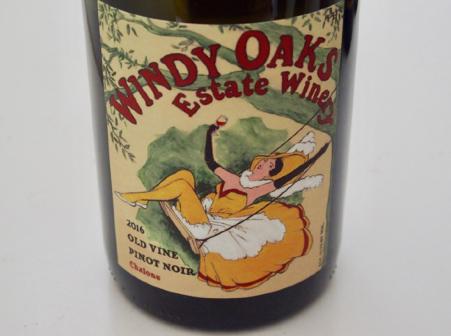 2014 Windy Oaks Old Vine Chalone Pinot Noir 13.7% alc., pH 3.45, TA 0.68, 48 cases, $65. sourced from Graff’s early plantings of Pinot Noir that were established using 1946 Chalone Vineyard cuttings. 50% whole cluster, aged 21 months in French oak barrels, 50% new. Bottled unfined and unfiltered. · Light cherry red color in the glass. Complex aromatic gifts including black cherry, sous-bois, briar, spice and nutty oak, reaching new heights with time in the glass. A connoisseur’s wine that is not propelled by rich fruit, but rather by nuance and complexity. The midweight flavors of cherry, red berry and spice are surprisingly intense considering the lighter color of the wine. Elegantly crafted and perfectly balanced, with finegrain tannins, juicy acidity and an astonishingly long, orgasmic finish. This wine brought back memories of my encounter with a 1990 DRC Romanée-Conti wine many years ago. Not a powerhouse, but delicate like an angel that is heaven sent. Score: 97
2016 Windy Oaks Old Vine Chalone Pinot Noir 13.7% alc., $65. · Moderately light garnet color in the glass. Very sexy nose brimming with wondrous aromas of spiced cherry, earthy flora and flowery underbrush. The beautifully ripened cherry core is annotated with notes of spice, cola, mushroom and savory herbs. Impressive harmony, with refined tannins, an expansive mid palate and like the energizer bunny, the finish kept going and going. Score: 94
Brosseau Vineyard
Location: Gavilan Mountain Range, Chalone AVA
This vineyard, located at 1,600 feet elevation and lying in the shadow of the nearby Pinnacles National Monument, is owned by Testarossa Director of Winemaking and UC Davis graduate Bill Brosseau. He farms the vineyard along with his spouse Kilene who is also a graduate of the UC Davis Viticulture and Enology program. Bill’s parents, John and Jan Brousseau, planted this vineyard originally to Pinot Noir and Chardonnay, trucking in water to get it established (rainfall is very low in the Chalone AVA). The site was purchased in 1978 and cleared for planting by 1980. By the 1990s, Chalone Vineyard supplied water and electricity. The site is known for the limestone strata in the soils. The vineyard has been slowly expanded to 42 acres to include not only additional Pinot Noir clones (Pommard and Dijon clones 113, 114 and 115) and Chardonnay clones but also Syrah and Grenache. The fruit has been sold to other wineries since 1995 including Bougetz Cellars, Cellars 33, Enfield Wine Co., Flywheel, Fulcrum Wines, Harrington, Loring Wine Co., Seabold Cellars, Tantara and Testarossa. I believe all of these wineries have bottled a wine crafted from a mix of old and new plantings except for Brosseau Wines. A Brosseau Wines Old Vines Brousseau Vineyard Pinot Noir is available at www.brousseauwines.com I reviewed 2014, 2015 and 2016 vintages of Fulcrum Brosseau Vineyard Pinot Noir. This is one of the best bottlings crafted by David Rossi in his lineup at Fulcrum Wines. The recent release of Old Vines Brosseau Vineyard Pinot Noir was recently reviewed.
 2017 Brosseau Wines Old Vines Brosseau Vineyard Chalone Pinot Noir 13.9% alc., 45 cases, $53. · Moderately light garnet color in the glass. A catnip nose filled with aromas of blackest cherry, black grapes and ground savoury spice. A striking wine of obvious exceptional pedigree offering the essence of mouthwatering, earth-kissed black cherry in a mid-weight style. Nicely composed with a good backbone of refined, supportive tannins and a good underlying cut of acidity especially noteworthy on the long and exuberant finish. When tasted the following day from a previously opened bottle, the wine was even more spectacular, filling the glass with cherry fruit, spice and a floral component. Nothing sexier than the scent of Pinot floral perfume. Score: 96
McIntyre Estate Vineyard
Location: Santa Lucia Highlands
Steve McIntyre acquired this property in 1987 from the McFarland family who planted the vineyard in 1973 and he has since upgraded the vineyard. One of the most knowledgeable viticulturists in California, he farms 12,000 acres in Monterey County as the owner of Monterey Pacific and has planted or farmed nearly 25% of the vineyards in the Santa Lucia Highlands AVA. The 80-acre, certified sustainable, old vine Estate Vineyard is planted to both Pinot Noir and Chardonnay. Pommard clone and Swan selection are planted on their own rootstock. This is the oldest Pinot Noir vineyard in the Santa Lucia Highlands AVA. 10 acres of Dijon 115 and 777 and 13 acres of Chardonnay Dijon 96 and 76 have been added. Br> 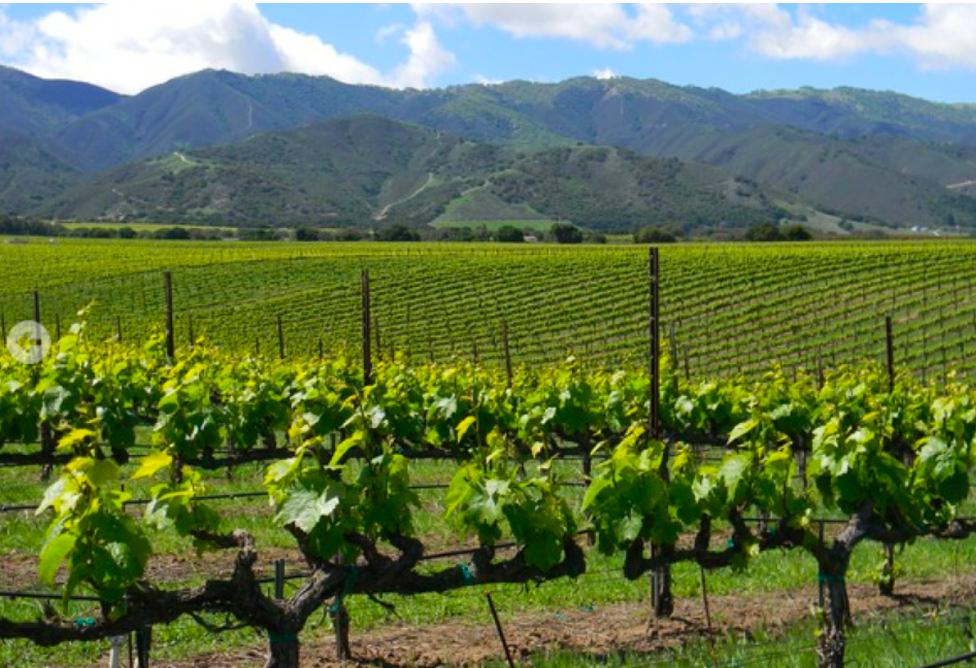
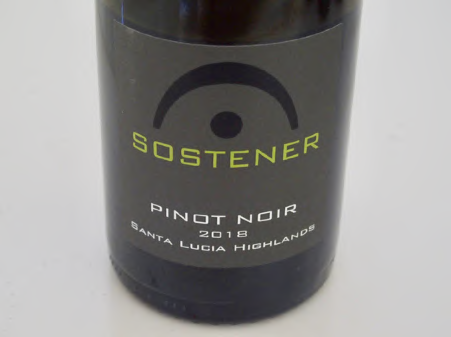 2018 Sostener Santa Lucia Highlands Pinot Noir 13.9% alc., $11.98-$18.95. The name Sostener means “sustain” in Spanish symbolizing a dedication to sustainable viticulture and winemaking. Produced from the “very old vines” at the McIntyre Estate Vineyard. A collaboration between two Monterey growers and vintners, Steve McIntyre and Michael Thomas. The winemaker is Eric Laumann, a UC Davis graduate with over 30 years of winemaking experience in California. · Moderately light garnet color in the glass. The nose slowly opens to reveal pleasing aromas of black cherry and allspice. Very polished, elegant and easygoing on the palate, featuring black cherry and strawberry fruit flavors accompanied with a riff of spice. Good acid verve and sparse tannins make for juicy early enjoyment. A bit shallow on the mid palate and short finish. An excellent everyday Pinot Noir as well as a solid value in old vine Pinot Noir. Score: 90
Paraiso Vineyard
Location: Santa Lucia Highlands.
Rich and Claudia Smith planted Pinot Noir, Chardonnay and Riesling in their home estate in 1973. Rich Smith was one of the visionary leaders in Monterey County viticulture and assisted in establishing the Santa Lucia Highlands AVA in 1991. Smith Family Wines CEO Jason Smith took over for his father Rich Smith. In 2019, the labels Paraiso, Irie and Alexander-Smith were removed from the winemaking business so the owners could concentrate on grape growing. They currently farm grapes across more than 3,500 acres in Monterey County and are now the largest grower of Pinot Noir in the Santa Lucia Highlands at 584 acres. Years were spent replanting older vines on the estate property that surrounds the Paraiso winery, finishing in 2013. But apparently some old vines remain in production. 2016 Seabold Paraiso Vineyard Santa Lucia Highlands Pinot Noir ($40) is said by the producer to be made from “the oldest Pinot Noir planting in the Santa Lucia Highlands, dating to the 1970s, located on a rocky outpost on the southwestern portion of the property with soils containing shale and schist.” Visit www.seaboldcellars.com
California Old Vine Pinot Noir Vineyards: San Benito County
Eva Dehlinger, Dehlinger Winery
Enz Vineyard
Location: The inland slope of Gabilan Mountain Range in the Lime Kiln Valley AVA.
Enz Vineyard is home to some of the oldest vines in California, dating back to 1887 when they were planted by the original homesteaders and were discovered by the Enz family in 1967. Today, Enz Vineyards & Winery owns about 1,400 acres in Cienega Valley with 40 acres planted to Mourvedre, Zinfandel, Pinot St. George (Cabernet Pfeiffer), Pinot Noir and Orange Muscat. The head-pruned Mourvedre vines date to 1922. The Pinot Noir was probably not planted before 1980 although John Locke of Birichino, who worked at Bonny Doon for 17 years, believes the Pinot Noir was planted around 1980. The vines are dry-farmed and own-rooted in abundant limestone and granitic deposits. Currently available is the 2017 Birichino Enz Vineyard Monterey County Pinot Noir (50 cases, $40) and a 2016 Bonny Doon Vineyard Enz Vineyard Cienega Valley Pinot Noir ($38). Visit the Birichino website at www.birichino.com. and the Bonny Doon website at www.bonnydoonvineyard.com. Also, 2011 and 2012 Kenneth Volk Enz Vineyard Lime Kiln Valley Pinot Noir ($48) at www.volkwines.com
Jensen, Reed and Selleck Vineyards
Location: Mt. Harlan
Josh Jensen (“Mr Pinot”) planted his first vineyard blocks in 1975 in a remote property in the Gabilan Mountains 25 miles east of Monterey Bay and 16 miles north of Chalone, choosing the site because of limestone-derived soils and climate. At an average elevation of 2,200 feet, the Calera vineyards are among the highest and coolest vineyard sites in California. Jensen cleared enough land to plant the initial three Pinot Noir vineyards: Jensen (named after his father Stephen Jensen), Reed (named after his initial business partner) and Selleck (named after Dr George Selleck who first introduced Josh to wine). Mills Vineyard, named after John Everett Mills who built the infrastructure on the property on Cienaga Road for a mining operation including retaining walls that were to become part of Calera’s gravity-flow winery, followed in 1984 (14.4 acres of Pinot Noir and Chardonnay and Viognier plantings). Ryan Vineyard (13.1 acres of Pinot Noir) named after Jim Ryan, the initial vineyard manager at Calera beginning in 1979, was planted in 1998 and 2001. The 15.6-acre de Villers Vineyard, named for Marq de Villiers, author of The Heartbreak Grape, the creation story of Calera, was planted in 1996, 1997 and 2001 (15.6 acres of Pinot Noir). All Mt. Harlan Vineyards were certified organic (CCOF) in 2008.
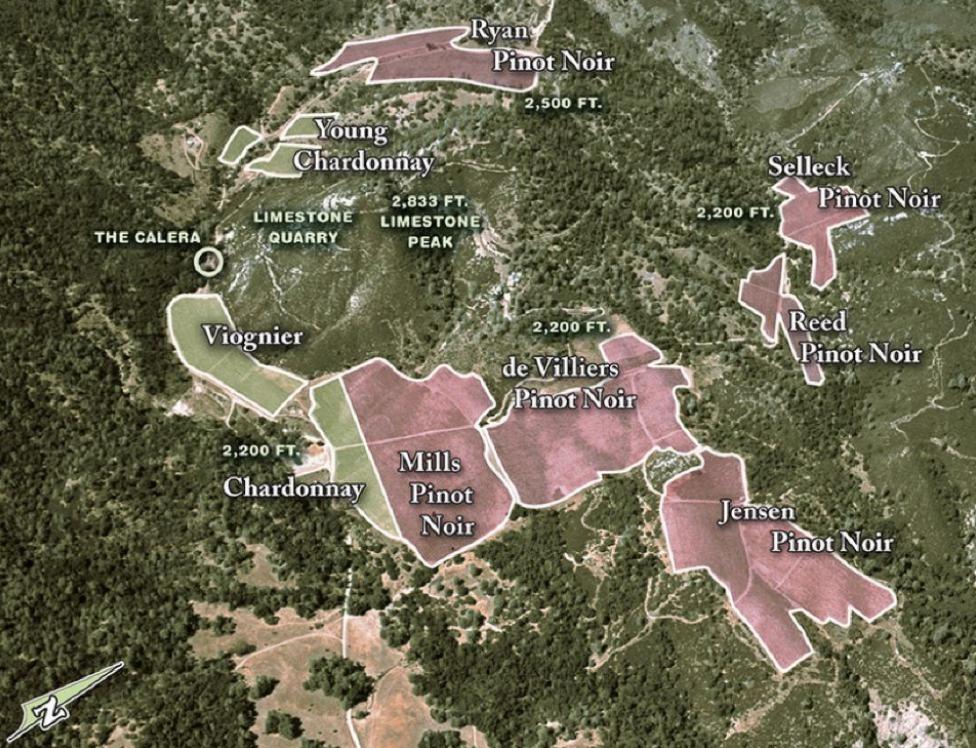
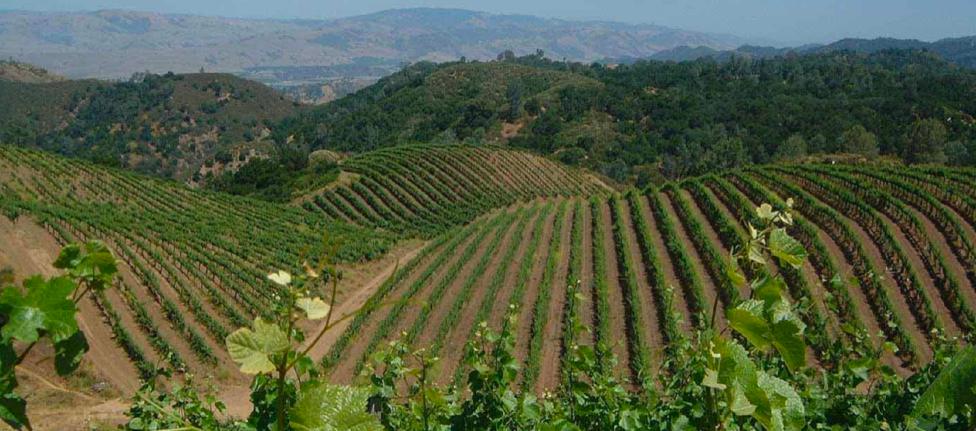
Calera wines are sold on the website at www.calerawine.com. I reviewed the 2015 and 2016 Jensen and Reed vineyards Pinot Noir and the 2015 Selleck Pinot Noir in 2019 and these wines are still available on the winery’s website.
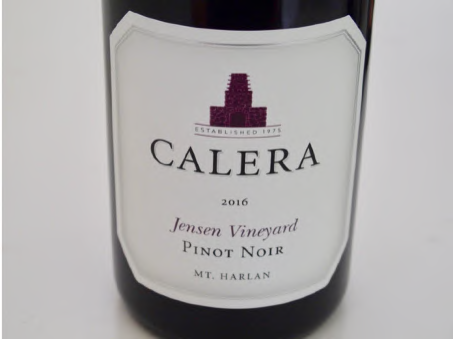 2016 Calera Jensen Vineyard Mt. Harlan Pinot Noir 14.8% alc., pH 3.69, TA 0.53, 1,000 cases, $95. Yield 0.9 tons per acre. Harvest Brix 24.5º. Aged 17 months in French oak barrels, 30% new. · Moderately light garnet color in the glass. Engaging aromas of plum, blackest cherry and sous bois. Gracious in the mouth, with a midweight core of black cherry and black raspberry fruits with deft oak dressing. Firm, but not intrusive tannins and a noticeable cut on the finish that goes on and on. There are several features of this wine that make it special including the seductive texture, the energy imparted by good natural acidity, the purity of fruit flavor, the subtle savory thread, and the extremely long, grand cru finish. An exceptional wine and always the Prima Donna among the Calera wine stable. Score: 95
2016 Calera Reed Vineyard Mt. Harlan Pinot Noir 14.2% alc., pH 3.71, TA 0.63, 375 cases, $75. Yield 1.0 tons per acre. Harvest Brix 25.4º. Aged 17 months in French oak barrels, 30% new. · Moderately light garnet color in the glass. Aromatically pleasing, with scents of fresh dark cherry and boysenberry, spice and a modicum of toasty oak. Dark red cherry and purple berry fruits are featured in this mid-weight styled wine that is sleek in the mouth and finishes long with waves of strawberry and boysenberry fruit. The wine displays exquisite balance. Much more engaging when tasted the following day from a previously opened and re-corked bottle. A superb wine. Score: 94
2015 Calera Selleck Vineyard Mt. Harlan Pinot Noir 14.6% alc., pH 3.53, TA 0.72, 125 cases, $95. Yield a meager 0.35 tons per acre. Average harvest Brix 14.0º. Aged 17 months in French oak barrels, 30% new. · Moderate garnet color in the glass. This wine displays a ripe fruit profile, featuring aromas and flavors of black raspberry, black cherry and blackberry. The fruit flavors are very delightful although a little too ripe for me to fully embrace. The wine has impeccable harmony, with fine-grain tannins, an appealing earthiness, a compliment of underlying oak. and a big fruit-laden finish. Score: 93
California Old Vine Pinot Noir Vineyards: San Luis Obispo County
Eva Dehlinger, Dehlinger Winery
Hoffman Mountain Ranch - HMR Vineyard
Location: Adelaida District AVA in western hills of Paso Robles
The Hoffman Mountain Ranch (HMR) and Winery were developed by Stanley Hoffman MD, a cardiologist who practiced in Beverly Hills and later in north San Luis Obispo County. He had a special affection for Pinot Noir and initially intended to grow and sell wine grapes as a business adjunct to his medical practice. He sought the advice of Jack Foote, the Agricultural Advisor for San Luis Obispo County, who advised Stanley to plant Pinot Noir. He also traveled to the Napa Valley to consult with André Tchelistcheff. 23 of the 34 acres are original Pinot Noir vines planted in 1964 with the remaining 11 acres established in 1999 and 2011 with cuttings from the original vines.The scion material, according to John Haeger is probably from Mount Eden Vineyards then owned by Martin Ray. That said, current winemaker, Jeremy Weintraub told me the rootstock and clone are unknown but the leaves and cluster morphology suggest Martini clone on St. George rootstock.
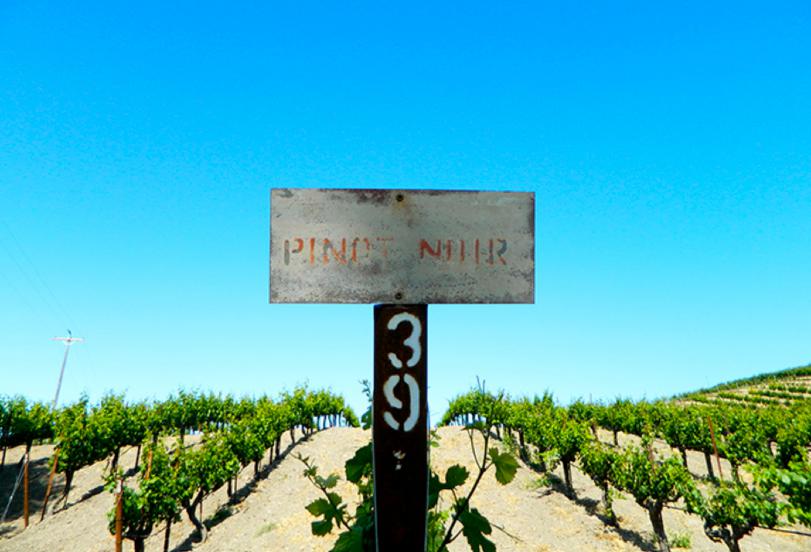
The Hoffman Mountain Ranch originally consisted of 1,200 acres when the Hoffman’s acquired the property in 1961. Located at an elevation of 1,600-1,725 feet, the site is 14 miles inland from the Pacific Ocean and cooler than most vineyards in the Paso Robles area. The chalky, limestone-rich subsoils present here are ideal for Pinot Noir. The original Pinot Noir vines are south facing on the lower part of a steep slope, own-rooted and low yielding (less than one ton-per-acre). In 1973, Dr and Mrs Hoffman left Southern California and moved to Paso Robles to establish a winery on their property and produce premium estate wines. The original HMR winery is considered the first modern commercial winery in Paso Robles. That same year, Tchelistcheff joined HMR as a winemaking consultant and HMR began producing HMR wines, including Pinot Noir. Through Tchelistcheff’s guidance in the vineyard and winery and the help of Hoffman’s sons, David and Michael, HMR produced wines that garnered high honors. The winery was at the forefront of modern winemaking, using stainless steel fermenters and French oak barrels. The cover of 1979 Wines & Vines magazine featured Andre Tchelistcheff and Stanley Hoffman:
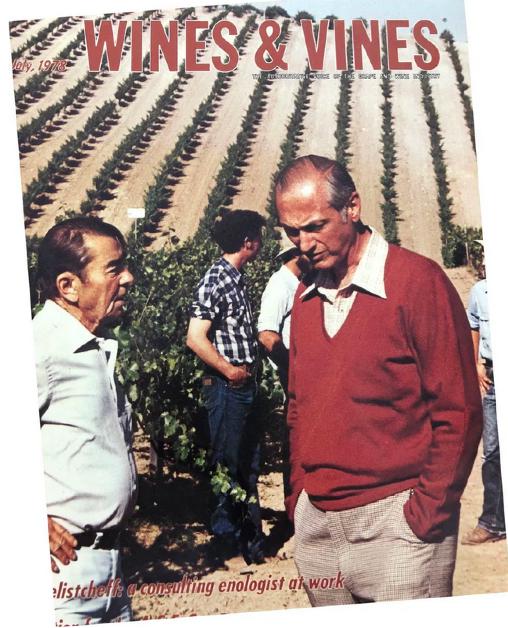
The current HMR winemaker is Jeremy Weintraub who has been at the ranch since 2013 and has provided stability and devotion to the HMR vineyard. One example is that he insisted on farming organically upon arrival. His reverence for the HMR vineyard is clear, “ I have worked with Pinot in Central Otago, Martinborough and Santa Ynez and the HMR Vineyard stands apart. It has its own character. I want the Pinot to be making great wine into the next century.” The HMR Vineyard is the oldest producing Pinot Noir vineyard in the Central Coast. Jeremy told me that >98% of the original HMR vines are still producing as are the replants taken from the original cuttings in 1999 and 2011. An HMR Estate Pinot Noir from the original old vine plantings has been produced since 1996. Brothers Georges and Daniel Daou of DAOU Vineyards & Winery, owners of nearby mountain property with mostly Bordeaux varieties planted, purchased the remaining 112 acres of Hoffman Mountain Ranch in 2012, renamed it Daou Mountain and began a restoration of the old HMR redwood winery. Adelaida retained the HMR Vineyard. Stanley Hoffman passed away in 2017. More information about the history of HMR can be gained by consulting the Wine History Project of San Luis Obispo County at www.winehistoryproject.org. I recently had the opportunity to review a mini vertical of Adelaida HMR Vineyard Pinot Noir, 2014-2018, all crafted by winemaker Jeremy Weintraub. This was an eye-opening experience and my deepest respect goes to Jeremy and his crew including long-time vineyard manager Mike Whitener for preserving this historical vineyard and crafting wines that so beautifully express the uniqueness of this cherished terroir. With over 98% of the original vines in production, the HMR Estate Vineyard Pinot Noirs are a very pure expression of old vines and are some of the greatest California Pinot Noirs being produced in California. To acquire Adelaida Vineyards & Winery HMR Estate Pinot Noir, visit www.adelaida.com. For me, the wines seem more like Martini clone than Mount Eden clone.
2014 Adelaida HMR Estate Vineyard Adelaida District Paso Robles PInot Noir 14.3% alc.. · Moderately light garnet color in the glass. Bold aromas of black cherry, raspberry and baking spice. Flavorsome core of broad-flavored Bing cherry and black raspberry fruit with added hints of cola and licorice. Glossy in the mouth with polite tannins and some finishing pizazz. Nicely balanced, with a shadow of toasty oak in the backgound, becoming livelier over time in the glass. Superb at age six, and easily capable of offering another ten years of pleasure. Score: 94
2015 Adelaida HMR Estate Vineyard Adelaida District Paso Robles Pinot Noir 13.9% alc.. · Moderate garnet color in the glass. The nose is bit reticent, displaying aromas of earth-toned blackberry, cassis and spice. The velvety mouthfeel seduces immediately as does the noticeable richness and ripeness the purple and black berry fruits. There is a herbaceous note in the background. The finish is remarkably long and lavish. Score: 93
2016 Adelaida HMR Estate Vineyard Adelaida District Paso Robles Pinot Noir 13.5% alc.. · Moderately light garnet color in the glass. embraceable aromas of black cherry, spice cabinet and brioche. Somewhat earthy and rustic in a good way, accentuating the mid-weight essence of dark fruits. Very polished, with a juicy vibe and a finish that lingers. This is a wine that shows presence and interest without pronounced body. Even more delectable the following day when tasted from previously opened bottle when the fruit came charging to the forefront. Liquid nobility. Score: 95
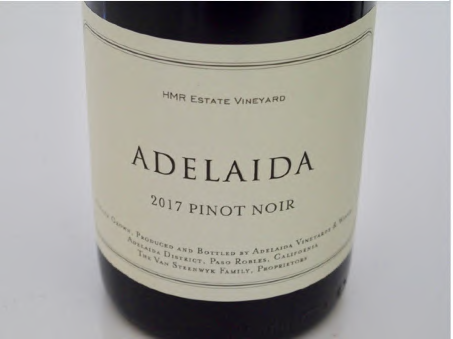 2017 Adelaida HMR Estate Vineyard Adelaida District Paso Robles Pinot Noir 14.1% alc.. · Moderately light garnet color in the glass. A nose you could drink, with hitone scents of fresh black cherry, cardamom spice and sous bois. The layers of discreetly concentrated and delicious black cherry and blackberry fruits are expansive on the mid palate and finish. A riff of spice adds interest. A bit of tannin tenacity adds to the buffed and welcoming texture. This wine really infuses the palate with charm. A winegasm. Score: 97
2018 Adelaida HMR Estate Vineyard Adelaida District Paso Robles Pinot Noir 14.2% alc., $60. · Moderate garnet color in the glass. Fetching aromas of black cherry and earthy flora lead off. The mid-weight flavors of black cherry and boysenberry are striking and exhibit exceptional length in the mouth and on the finish. Hints of pastry crust, vanilla and baking spice add interest. A sophisticated wine that is driven by well-integrated, crunchy acidity. The finish seemingly lasts forever and leaves behind a memorable echo of dark fruited aromatic goodness. When tasted from an open bottle several hours later, my notes say simply, “Wonderful!" Score: 96
California Old Vine Pinot Noir Vineyards: Santa Barbara County
Jamie Goode, wine journalist
Bien Nacido Vineyards
Location: Santa Maria Valley
Bien Nacido Vineyards is located in the Santa Maria Valley AVA a few miles east of the town of Santa Maria in a valley that is open to an east-to-west corridor leading to the Pacific Ocean to the west. Most of the vineyard blocks are allocated to small producers and farmed according to their standards. The terroir combines rock soils (sandy loam, chalk, gravelly loam, and marine loam) and an ocean-influenced cool climate. Today, the vineyards span 800 acres with 250 acres of Pinot Noir. The Bien Nacido Vineyard remains a major source for certified, variety budwood for other vineyards in California.
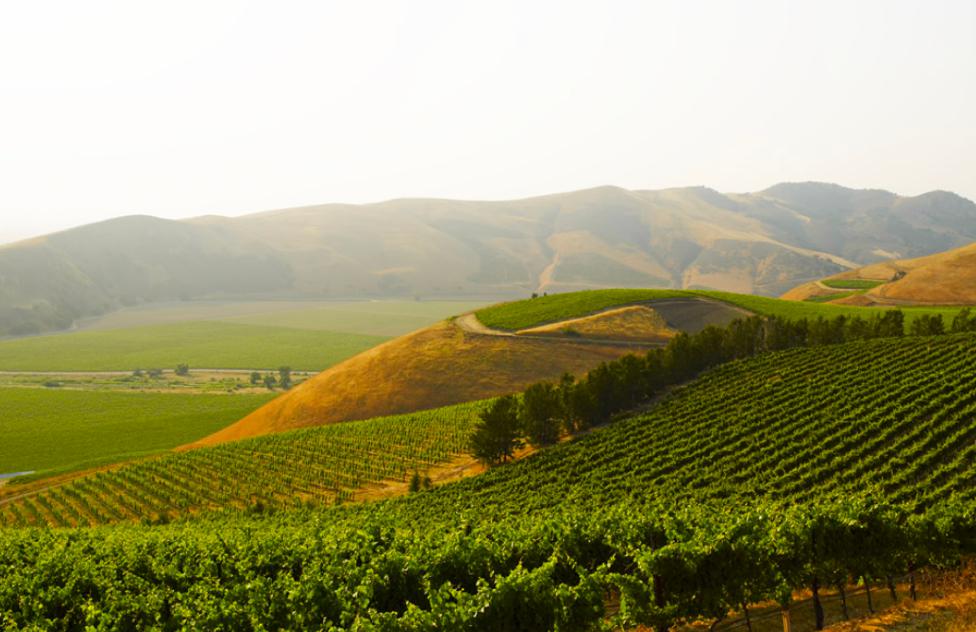
The oldest Pinot Noir vines are in Block G, Block N, and Block Q. The own-rooted vines in these blocks were planted in 1973 and are still productive. The oldest sections are said to contain Pommard, Martini, Swan and Calera clones. I made multiple inquiries to Bien Nacido sources to determine all of the scion material and acreage and percentage of currently producing original vines in all of the initial Blocks of Pinot Noir at Bien Nacido Vineyard but my inquiries were never answered. My website lists 39 producers who have accessed Bien Nacido Pinot Noir grapes through the years and I am sure there are several more. For more than 20 years, Gary Farrell Vineyards & Winery has sourced Pinot Noir from the legendary Q Block that is 23 acres of Pommard 4 planted in 1973 and considered the most prestigious Pinot Noir block on this famous site. Bien Nacido Estate has bottled a limited amount (rarely more than 120 cases) of Old Vines Santa Maria Valley Pinot Noir from Blocks G, N, and Q, including a 2014 “Old Vines LXXIII Bien Nacido Vineyard” Santa Maria Valley Pinot Noir from Blocks M and Q ($100). The Bien Nacido Estate Pinot Noir includes vines planted in 1973, 1996, and 2006. Tantara (G and N Blocks), Tyler Winery (N Block), The Ojai Vineyard (Q Block, no strictly old vines bottling), Richard Longoria Wines (Blocks G & N) Timbre (G Block) and Byron (Q Block) have sourced Pinot Noir from the old blocks. Wines currently available: 2016 Longoria Bien Nacido Vineyard Block N Santa Maria Valley Pinot Noir ($50), 2016 Scar of the Sea Bien Nacido Vineyard Block Q Santa Maria Valley Pinot Noir ($70), 2016 Timbre Winery “Lead Vocals” (Block G) Santa Maria Valley Pinot Noir ($55), and 2017 Byron Bien Nacido Vineyard Q Block Santa Maria Valley Pinot Noir, as well as the following wines reviewed in June 2020:
 2014 Bien Nacido Estate Old Vines Santa Maria Valley Pinot Noir 13.5% alc., $100. Sourced from the oldest own rooted vines at Bien Nacido. · Moderate garnet color in the glass. The nose reveals itself over time in the glass to to offer a marriage of cherry and toasty oak aromas. Light to mid-weight in style, with flavors of cherry, strawberry, spice and toasty oak. Elegantly fruited, even close to shallow with an appealing juiciness. The wine has a rustic, savory bearing with a modicum of toasty oak in the background. Better over time in the glass, showing off a resolute but not especially long finish. Score: 91
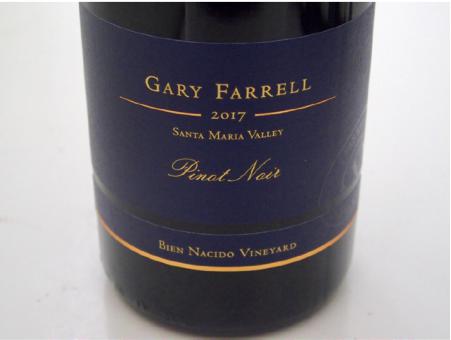 2017 Gary Farrell Bien Nacido Vineyard Santa Maria Valley Pinot Noir 13.3% alc., $70. One of the few wineries to source Pommard clone from the legendary Q Block. · Light garnet color in the glass. The scent of dark red cherry and berry, oak spice and floral perfume leads to a mid-weight infusion of oak-kissed Bing cherry and dark strawberry fruit flavors. Fresh and satisfying without noticeable tannins, silky in texture, and offering an arrow of acidity that drives a lip-smacking, extended finish. Note: I have tasted this wine on three occasions with variable results and scores ranging from 90-93. This review was from the best of the three bottles. Score: 93
 2016 Scar of the Sea Bien Nacido Vineyard Q Block Old Vine Santa Maria Valley Pinot Noir 13.0% alc., $70. · Moderately light garnet color in the glass. Aromas of cherry, raspberry, underbrush, slate and toasty oak. Very gracious on the palate with impeccable balance, offering the middleweight flavor of darker, well-spiced cherry. Slightly creamy in texture, with gentle tannins and a dusting of toasty oak that shows up on the finish. Score: 92
2016 Tyler Bien Nacido Vineyard Old Vine Santa Maria Valley Pinot Noir 13.0% alc., $70. · Moderately light garnet color in the glass. The nose is replete with oak-driven aromas of cigar, pipe bowl, ash and wood. Light to mid-weight in style, featuring juicy flavors of cherry, strawberry and savory herbs that are obscured by overbearing oak treatment. The redeeming features are a silky mouthfeel, gossamer tannins and a decent length of finish. Score: 86
 2017 Tyler Bien Nacido Vineyard - N Block Santa Maria Valley Pinot Noir 13.2% alc., $90. · Moderate garnet color in the glass. The nose is dominated by toasted oak aroma with a hint of cherry in the rear. Light to mid-weight in style, offering flavors of black cherry, blackberry, and savory herbs. The fruit load is shallow on both the mid palate and finish. Suave in the mouth and easy to drink, but the aggressive barrel presence spoils the experience. Score: 86
Clark & Telephone Vineyard
Location: Santa Maria Valley
This vineyard, located near the corner of Clark Avenue and Telephone Road, was established in 1972 with own-rooted Martini clone. It is situated at 580-700 feet elevation, 13 miles from the Pacific Ocean on a west-facing slope, exposed to coastal breezes and cool fog. Soils are sandy loam. Belle Glos is the sole producer of wine from this vineyard. The wines are widely distributed in the retail marketplace. Visit www.belleglos.com
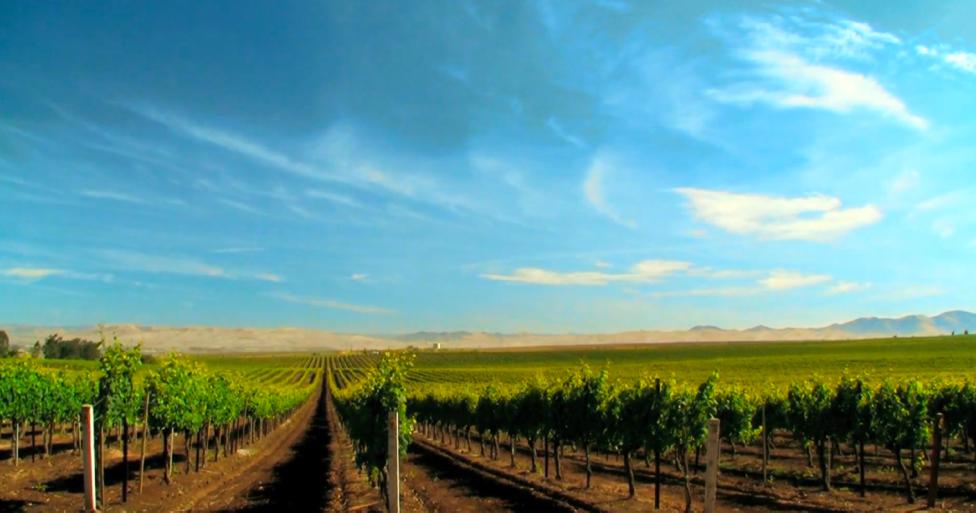
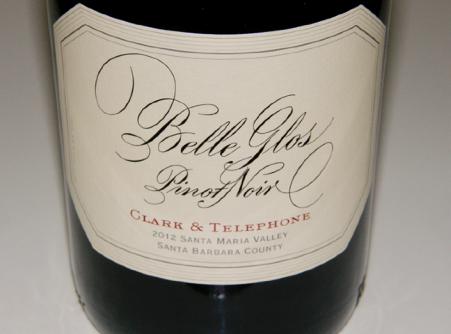 2018 Belle Glos Clark & Telephone Vineyard Santa Maria Valley Pinot Noir 14.7% alc., $55 (often discounted). Released October 2019. 100% de-stemmed, up to 2-week cold soak, closed and open-top stainless steel fermenters, punchdowns and punch-overs. Aged up to 9 months in French oak barrels (60% new). Racked twice after malolactic fermentation before making the final blend. · This wine reflects fruit that is left on the vine for an extended time so that the skins are dark, show orange peel dimpling and the seeds are brown. The resulting wine is relatively high in alcohol and resembles the Meomi brand crafted by the same winemaker, Joe Wagner. Very dark garnet color in the glass. Not particularly aromatic, with an aloof perfume of blackberry syrup and damp earth. The full-bodied array of purple and black berry fruits are thick on the palate. Sweet flavored, with some floral and earth contributions. Very modest dry tannins. The high alcohol is well-hidden. This wine could have come from anywhere. There are fans of this style of Pinot Noir, but it is not my cup of tea since it has little redeeming Pinot Noir perfume and refinement.. Score: 88
Julia’s Vineyard
Location: Santa Maria
Julia’s Vineyard was first planted in the early 1970s (various sources report 1970, 1971, 1972) in part of the original Tepusquet Bench in Santa Maria by the Louis and George Lucas brothers. In 1986, Jess Jackson and Barbara Banke (along with the Robert Mondavi Winery) purchased a sizable section of the benchland part of the plantings at Tepusquet Vineyards and founded Cambria Estate Winery. Tepusquet Vineyards consisted of a 2,700-acre ranch with more than 1,400 acres of developed vineyard dating to the 1970s. The benchland is located between the Sierra Madre Mountains and the Sisquoc River, and was originally denoted as Tepuzil, a Chumash Indian term meaning “copper coin.” Spanish settlers later renamed it Rancho Tepusquet. The original owners of the rancho, part of an 1838 Mexican land grant, were the Olivera family who raised cattle and planted Mission grapes. Cambria Estate vineyards are located 17 miles inland and sit at 400 to 800 feet above sea level. They are planted in well-drained, ancient alluvial sandy soil that contains limestone and granite. The climate is cool with moderating maritime influences from the east-west orientation of the valley. There are five estate vineyards at Cambria, but Julia’s and Katherine’s Vineyards (named after Banke’s daughters) and Tepusquet Vineyard supply 90% of the grapes to the winery.
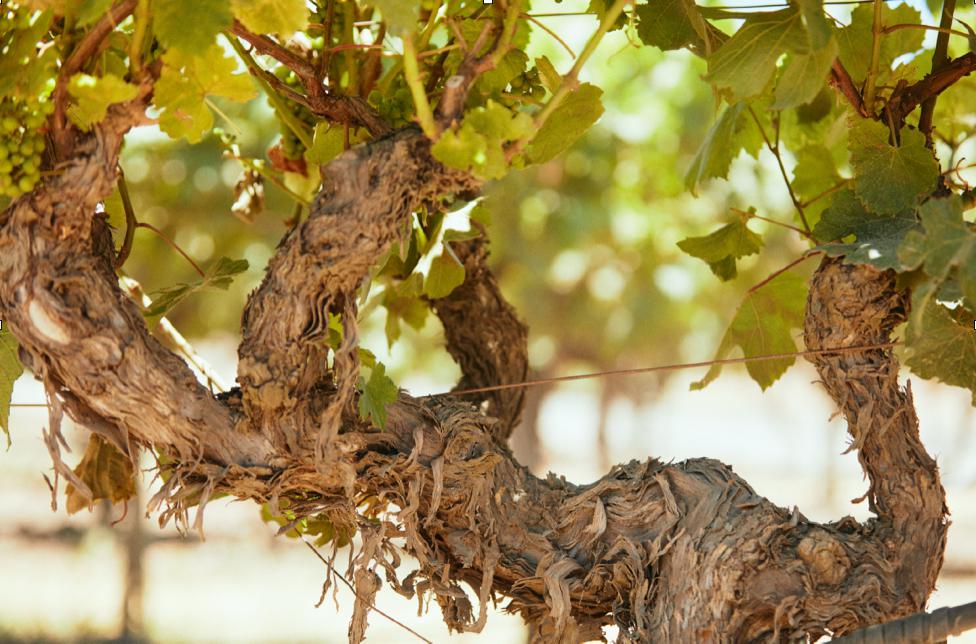
Another 400 acres of Pinot Noir are new plantings or replants of vines established between 1979 and 1989. Clones are mainly Pommard, but also Wädenswil 2A, 23, Martini 15, and Dijon 115, 667, 777 and “828.”. Cambria farms more Pinot Noir than anyone on the Tepusquet Bench. Julia’s eponymous vineyard parcel was created in 1991. There is both a regular Cambria Estate Julia’s Vineyard (35,000 cases) and Cambria Estate Signature Julia’s Vineyard Santa Maria Valley Pinot Noir produced but it is most likely these bottlings contain little of the original plantings. The blend is usually made up of 8 clones including Pommard 4, 2A, 23, 667, 115, 777, and “828.” Julia’s Pinot Noir is a standard-bearer for Central Coast Pinot Noir, at 35,000 cases annually and it is widely available and value-priced. A currently available old vine bottling is the 2017 Byron Julia’s Vineyard Santa Maria Valley Pinot Noir (50 cases, allocation) Sourced from two rows of old vine Pommard 4 presumably planted in the early 1970s - www.byronwines.com
Sanford & Benedict Vineyard
Location: Sta. Rita Hills
Geographer Richard Sanford and partner botanist Michael Benedict purchased a 473-acre piece of Rancho Santa Rosa that had once been dry farmed for beans and barley. They acquired cuttings in 1970, grew them into rootings and planted them in the Sanford & Benedict Vineyard in 1971-1972. The initial planting of 120 acres along Santa Rosa Road included Pinot Noir, Chardonnay, Riesling, Merlot and Cabernet Sauvignon. Michael Benedict had developed a model for an ideal vineyard environment and he traveled from Baja California, Mexico, to the Okanagan Valley in British Columbia, Canada, looking for land. He found the best location with friend Richard Sanford, a site nestled between the Santa Ynez Mountains and San Rafael Mountains in an east to the west valley. Richard Sanford was a pioneer in Santa Barbara County viticulture and is often referred to as the “Godfather of Central Coast Pinot Noir.” He and Benedict were the first to see the potential of the Sta. Rita Hills as a region for Pinot Noir and Chardonnay, realizing that the transverse mountain range where the valleys are west-to-east lying and open to the Pacific Ocean provides an optimal maritime influence for these two varieties to thrive. Richard Sanford was named 2020 Vintner of the Year by the Sta. Rita Hills Wine Alliance. The 1976 Sanford Sanford & Benedict Vineyard Pinot Noir was the first commercial Pinot Noir release in the Sta. Rita Hills. The wine was critically acclaimed by Dan Berger and others, as the first California Pinot Noir that was “Burgundian in style.” The partners had a falling out by 1980 and the two parted ways with Benedict retaining ownership of the vineyard. The Sanfords regained management of Sanford & Benedict Vineyard under the ownership of Robert Atkin in 1988 only to lose the vineyard once again in 2007 to Sanford's then business partners at Sanford Winery, Terlato Wine Group. The current owner, Sanford Winery, still farms 51 acres of the original planting. There are more than 20 blocks and 11 different clones. The own-rooted original vines are planted in calcium-rich clay loam soils that contain fractured shale and chert.
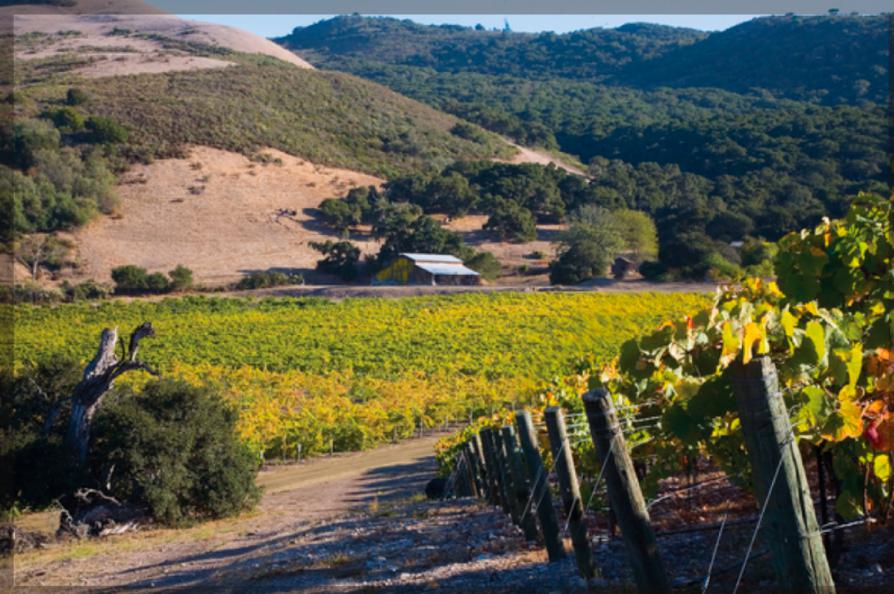
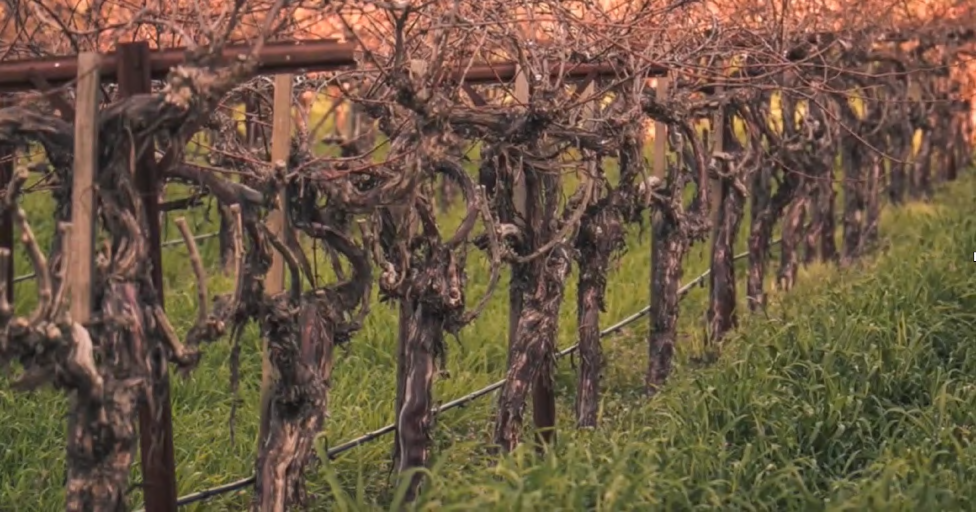
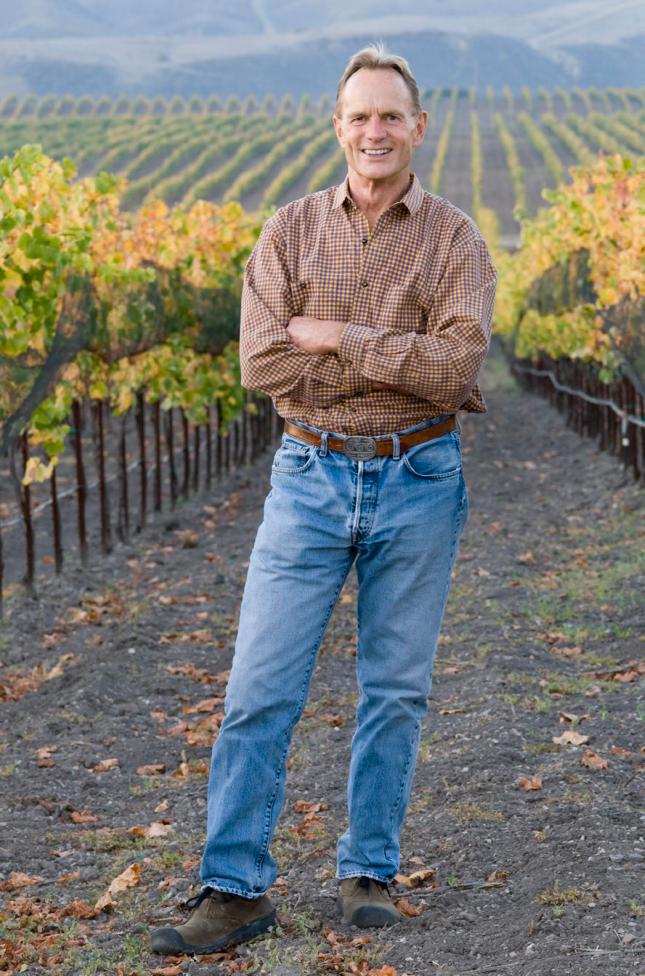
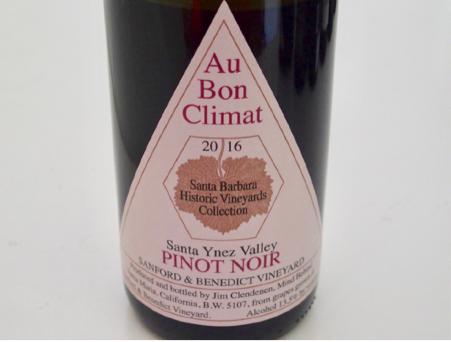 13.5% alc., $50. Extended cold soak, aged 20 months in Francois Frères French oak barrels. · Light garnet in color in the glass. Reserved initially, but pleasant aromas of oak-kissed red cherry and berry. Admirable in every way, with impressive harmony and class. Red fruits enhanced with baking spices are featured in a middleweight styled wine that offers elegance, hidden tannins and a persistent finish. This is one of the best examples of a wine from this vineyard that I have tasted in recent memory. Score: 94
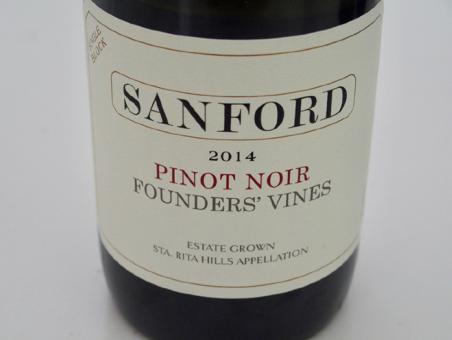 2014 Sanford Single Block Founders' Vines Sta. Rita Hills Pinot Noir 14.0% alc., $115. · Inviting nose that exudes wondrous aromas of cherry, raspberry and sous bois. Beautifully composed, with mid-weight flavors of fresh cherry, ripe strawberry and purple grape and some earthiness adding gravitas. Silky on the palate with a mere shadow of tannins at this stage stout acidity and a hint of welcome oak. The finish is grand befitting the maturity of these vines. Score: 94
Historic California Old Vine Pinot Noir Vineyards Pulled Out or Planted Shortly After 1980 or Lacking Verifiable Planting Information
Ashton Vineyard This vineyard was located in the heart of Glen Ellen in Sonoma County at the foot of Sonoma Mountain. First planted in 1970 by Stephen Ashton, this organically-farmed vineyard contained 7 clones of Pinot Noir. “Old Vine” Pinot Noir was produced by winemaker Robert Rex. The vineyard was tragically destroyed by the Nuns fire in 2017. Beckstoffer-Los Amigas Vineyard Planted by Louis P. Martini in 1963, this is the only vineyard among Martini’s Carneros plantings that survived. Beckstoffer Vineyards purchased the vineyard, now named Carneros Lake/Los Amigas Vineyard, in 1993 and expanded it to 410 acres of Pinot Noir, Merlot and Chardonnay in 2017. Acacia Winery and Signorello Winery bottled vineyard-designated Pinot Noir from this vineyard (the last from Signorello was 2011), but I was unable to confirm whether the original plantings were still in production. Boer Vineyard The original block of Cabernet Sauvignon was planted in about 1980 at 2,000 feet elevation in the Gabilan Mountain Range by Pinnacles National Park in the Chalone AVA. The vineyard is a mile south of the Antle Vineyard. Soils are decomposed granite and chalky limestone. It was originally called the A-Frame vineyard after a house on the property built by Chalone’s Phil Woodward. Today, it is named Boer Vineyard after Chalone vineyard manager Richard Boer who owns and farms the vineyard. The Cabernet Sauvignon was grafted over to Pinot Noir in 2000. Pinot Noir is sourced by Birichino and Sandler Wine Co. Bonny Doon Randall Grahm started Bonny Doon Winery in 1975 with the intention of producing Pinot Noir in the Santa Cruz Mountains. His results were so disappointing that he budded over his Pinot Noir vines to Rhone varieties in 1985. Grahm would say, “I’m Doon with Pinot Noir.” Buena Tierra Vineyard Owned and farmed by Joseph R. Miller, this 47-acre vineyard was planted in 1978. It is located 1.5 miles southeast of Rochioli Vineyard in the low hills of the Laguna Ridge where the Russian River turns to head to the Pacific Ocean (1 mile from the Russian River). Pinot Noir and Chardonnay are planted to several clones in well-drained sandy clay loam soil. containing limestone. The oldest block was termed the Helio Doro Block, 2.5 acres named by Burt Williams’ son Fred Williams when he discovered the vineyard in 1999. The name refers to one of the employees who worked in the vineyard for many years. Brogan Cellars sourced this block until the old vines were pulled out and replanting took place. This was my favorite Brogan Cellars wine crafted by Burt’s daughter, Margi. I reviewed every vintage of this wine from 2002 to 2008: www.princeofpinot.com/ winery/357/. I have also reviewed Original Vines Pinot Noir (but not designated as Helo Doro Block) produced by Woodenhead Vintners for every vintage from 2002-2009: www.princeofpinot.com/428/. Recently reviewed:
 2004 Brogan Cellars Buena Tierra Vineyard Helio Doro Block Russian River Valley Pinot Noir 14.8% alc., 220 cases, $75, Magnum. · Moderate light garnet in color with some bricking of rim. Intriguing, complex and captivating aromas of fresh cherry, barrel spice, old leather, blood orange zest, root beer and dried herbs. Delicious flavors of burnished black cherry, black raspberry and dark chocolate in a mid-weight style with faded tannins and a silky mouthfeel. Showing an aged patina but still delightful, finishing with some persistence and the slightest sense of alcohol. The wine held up nicely over time in the glass. Magnums make all the difference. Score: 93
Lucien Charles Tamm (who most often went by Charles L.) immigrated with his family from France and later homesteaded this remote outpost. He was the first to plant wine grapes here in 1919, setting out Chenin Blanc but apparently never made wine from the grapes and spent little time here. A nearby property of 80-acres was sold to John C. Dyer in 1912 and this site on the Gabilan bench land would later become the Chalone Vineyard. In 1921, the Dyer ranch was sold to five partners with William Silvear being the primary operator of the property and sole owner by 1930. Inspired by Tamm, Silvear planted Chenin Blanc, Chardonnay, Pinot Blanc, and Pinot Noir in 1946 during Prohibition. He sold wine grapes to the Wente Brothers, Almaden, to others for sacramental wine, and Pinot Noir to Georges de Latour of Beaulieu Vineyard (BV). Andre Tchelistcheff arrived at Beaulieu in the late 1930s and had met Silvear. It is believed that Latour sourced his Pinot Noir from either Paul Masson plantings that dated to the 1890s or early 1900s or Paul Masson stock through Silvear’s plantings. Silvear died in 1955 and his spouse sold his benchland property two years later to psychiatrist Dr. Edward Liska and stockbroker John Sigman. They hired Philip Togni as winemaker in 1960 and that year he produced Pinot Noir, Chardonnay, Chenin Blanc, and Pinot Blanc, the first wines ever vinified on this property. This was quite a challenge for Togni for Silvear’s vines had been mismanaged, the property lacked water and electricity, yields from the 35 acres were a measly ½ ton per acre and a converted chicken coop had to be used for vinification. Under the new ownership, the property was named Chalone Vineyard, chosen for a peak called Mount Chalone shadowing the benchland property. Togni left in 1962 to work at E. & J. Gallo and the partnership, lacking funds to pay Togni and run the winery, dissolved their partnership. Rodney Strong, who ran a retail wine store in Tiburon and worked at Windsor Vineyards, had met Sigman and agreed to become the winemaker at Chalone Vineyard in 1964, crafting the wines at the Windsor winery. Enter Dick Graff. Graff visited Windsor Vineyards winery in 1964, was impressed with early 1960s Chalone wines that Strong poured him and was fascinated by stories about Chalone. When he visited for the first time in 1964, he was enthralled with the property. Enthused about wine, the following year Graff went to UC Davis to study viticulture and enology and became an agent for Siruge barrels in the United States. After the 1966 harvest, Graff’s first at Chalone, he bought a property neighboring Chalone, and later built a house there and developed vineyards on about 8 acres in the 1980s. Graff took care of the Hall Ranch, a property adjacent to Chalone that was owned by Bob Nikkel, a wealthy businessman who loved wine and owned a controlling interest in Mount Eden. He coxed Graff to consult at Mount Eden in 1967. Graff made wine at Mount Eden that year and would be involved in some way with Mount Eden over the next eleven years. Peter Graff, Dick’s brother, followed Dick at Mount Eden, and when he left, Merry Edwards was hired as a winemaker. When she departed after three years, Phil and Dick took over the management and winemaking at Mount Eden until the current owner, Jeffrey Patterson acquired Mount Eden in 1981. In 1972, Nikkel sold the 160-acre Hall Ranch to Phil and John McQuown (Mac) and created Macwood of Monterey. Extensive plantings ensued, including 24 acres in 1972, 26 acres in 1973 and 20 acres in 1974, some of which was Pinot Noir. I assume this vineyard became part of the Chalone property in time. In 1969, Graff’s mother acquired ownership of Chalone Vineyard at auction after the property had years of financial difficulties and this was the first year Graff produced wine at Chalone Vineyard as an owner. Graff had put together a few investors and bought the property from his mother for $65,000. He used French oak barrels for his first vintage, one of the first people in California to do so. When Andre Tchelistcheff visited Chalone Vineyard in the early 1970s and tasted the 1969 Chalone Pinot Noir, he knelt in front of Dick Graff. Tchelistcheff was to say, “That happens not too often. It happened to me two or three times in Burgundy. In California, it happened only once, and that was at Chalone.” Phil Woodward, who was a consulting accountant for the wine business, went to work for Chalone in 1972, raising money and personally selling wine. This would prove to be a long-term mutually beneficial relationship that ultimately led to the success of the Chalone Wine Group. By 1996, Dick Graff was out at Chalone. Dick Graff’s legacy is the consistent use of French oak barrels for Chardonnay and Pinot Noir, fermenting Chardonnay in barrel and aging Chardonnay and Pinot Noir in barrel. He was not the first (Hanzell was), but was very influential because of the popularity of his wines. I was captivated by the Chalone Pinot Noirs around 1980 that led to my passionate interest in Pinot Noir, and became a shareholder just so I could buy the Reserve wines and attend the annual debauchery that was the annual shareholders meeting at Chalone Vineyard. The Chenin Blanc is still in production at Chalone Vineyard and is the oldest producing vineyard and oldest Chenin Blanc in Monterey County. A 2.2-acre block of Silvear’s Pinot Noir was the oldest Pinot Noir in production in California until it was pulled out in 2003. An extensive vineyard updating program began in 1998 and much of the vineyard was replanted using the latest rootstocks and clones and the entire vineyard was re-trellised. John Haeger reported that in the early 2000s there were just over 100 acres of Pinot Noir among 250 acres of vines. Chalone is the only winery in the Chalone AVA and the oldest bonded winery in Monterey County. The Chalone Vineyard has been owned by Foley Family Wines since April 2016. Some of the information on Chalone was obtained from the book, Chalone: A Journey On The Wine Frontier authored by W, Philip Woodward and Gregory S. Walter (2000).
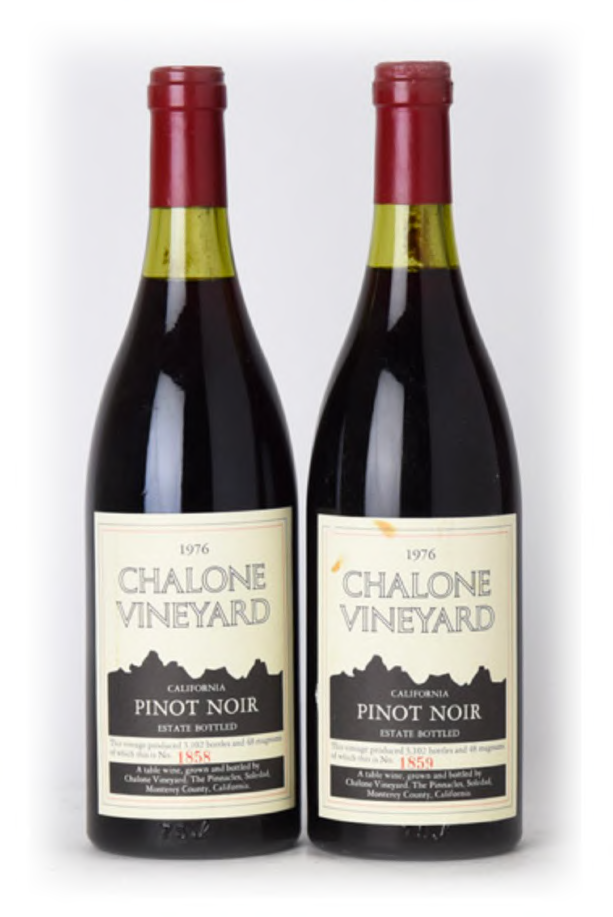 Chamisal Vineyards In 1973, Chamisal Vineyards was the winery to plant vines in the Edna Valley. Currently, there are some “Archery Summit 2” (faux 828) Pinot Noir vines and Wädenswil 2A planted but the date of planting is unknown. Most of the acreage is planted to modern clones. Cole Ranch Originally planted in the early 1970s by John Cole, this vineyard is the only one in the country’s smallest AVA at less than one-quarter square mile. It is located on Highway 253 between Anderson Valley and Ukiah and surrounded by mountains at 1,400 to 1,600 feet elevation. The site is cooler and wetter than surrounding wine-producing areas and the high elevation translates to cold nights and significantly slowed ripening, often a month later than elsewhere in Mendocino County. Esterlina Vineyards bought Cole Ranch in 1954 and replaced the existing Chardonnay and added to the existing 10 acres of Pinot Noir with additional Pinot Noir. I do not know the scion material. Today, there are less than 60 acres of Cabernet Sauvignon, Merlot, Pinot Noir and Riesling. Besides Esterlina Vineyards, Vision Cellars has sourced fruit from this vineyard. The Cole Ranch AVA went on sale in 2019 for $3.3 million. David Bruce Estate Vineyard David Bruce, MD bought about 40 acres in the Santa Cruz Mountains located at about 2,300 feet elevation among the redwoods in 1961 coinciding with the launch of his dermatology practice in Los Gatos. The following year, he cleared the land and initially planted 25 acres of vines by hand including Pinot Noir, Cabernet Sauvignon, and Chardonnay. His plantings were sourced from UC Davis, probably originating from the Wente Arroyo Seco Mother Plot in Arroyo Seco. The distinctive soils were primarily well-draining sandstone. A winery was built on the site and bonded in 1964 and later expanded in 1968 and thereafter. Bruce’s original plantings were destroyed by Pierce’s Disease by 1991 and the Estate Pinot Noir program was not resumed until 1996 when replanted vines had reached maturity. The vines came from cuttings of the original vineyard scion material that had been planted nearby at the Noble Hill Vineyard and at Dick Graff’s Chalone vineyard. These cuttings were distributed elsewhere in California and became known as the “David Bruce clone” although there is no such registered clone. Bruce bought another vineyard owned by Joe Locatelli in the Vine Hill subregion of the Santa Cruz Mountains in 1968, pulled out the Zinfandel planted there and replanted the vineyard with the Wente clone of Pinot Noir on its own roots. This vineyard was later sold and became the renowned Santa Cruz Mountain Vineyard. The winery website has not been updated since at least 2013. Terlato Wines became the exclusive marketing agent for David Bruce Winery in 2015 and releases a Russian River Valley and Sonoma County Pinot Noir under the David Bruce label. DeLoach Vineyard Cecil DeLoach planted his first Pinot Noir in 1976 on land he bought on Olivet Road in the Russian River Valley in 1969. Thirty years after the founding of DeLoach Vineyards in 1973, Boisset Family Estates bought the winery and vineyard out of bankruptcy and replanted the 17- acre vineyard that was part of the property. Devil’s Gulch Vineyard Winegrower and rancher Mark Pasternak planted 3 acres of Martini 15 Pinot Noir on AxR1 rootstock in 1980 with the intention of selling the grapes to a sparkling wine producer. Mark is the heart and soul of Marin County viticulture and has either planted or farmed every vineyard in the AVA. 11 acres of new Dijon clone plantings were added in 1998. The grapes are split 50/50 between Sean Thackrey and Dutton-Goldfield and both bottle a vineyard-designate Pinot Noir containing a mix of old and new plantings. Mark also planted 4 acres of Chardonnay I have reviewed every Dutton-Goldfield Devil’s Gulch Vineyard Pinot Noir since 2002: www.princeofpinot.com/ winery/153/. I have reviewed 8 vintages of Sean Thackrey Devil’s Gulch Vineyard Pinot Noir since the 2002 vintage: www.princeofpinot.com/winery/345/. Read the entire fascinating history of Devil’s Gulch Vineyard at www.princeofpinot.com/article/606/. The ranch is currently for sale.
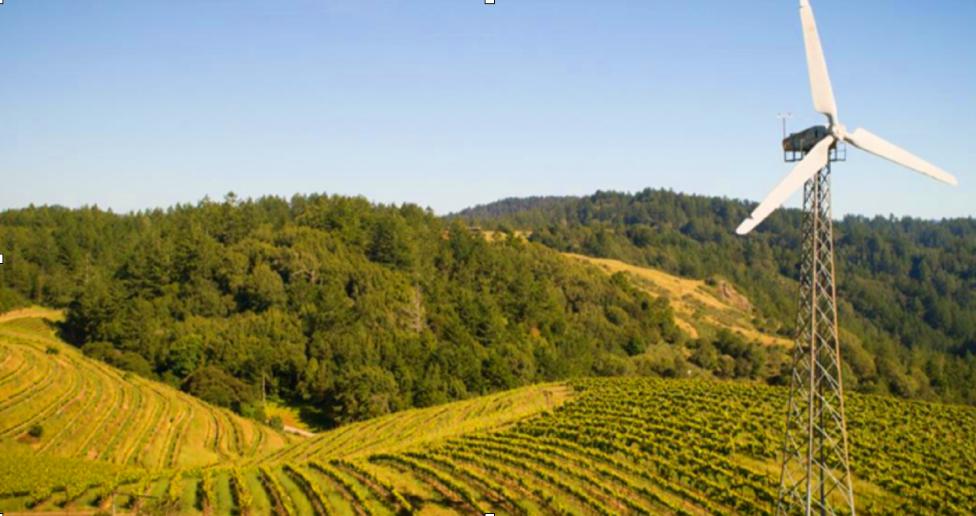
Domaine Chandon The original plantings, the first of Domaine Chandon’s Los Carneros vineyards, date to 1973 and were Martini 13 on St. George rootstock. El Molino Star Vineyard Founded in 1871, El Molino Winery was one of the first wineries in the Napa Valley. It was operated until Prohibition and then restored by Reginald and Marie Oliver who bought the winery and the surrounding land in 1978. In 1987, a partnership with close friends enabled the purchase of the Star Vineyard in Rutherford, a 66-acre planting of 30 acres of Chardonnay dating to 1978 and Cabernet Sauvignon. In 1991, some vines were pulled out and 2 acres of Pinot Noir planted. Another 4 acres of Pinot Noir was later added. The Pinot Noir vines, located in a unique microclimate ideal for growing Pinot Noir and Chardonnay are between Highway 29 and the Napa River, not far from where the historic BV1 block of Pinot Noir from which Andre Tchelistcheff crafted his acclaimed Pinot Noirs in the late 1940s. Ferguson Block at Donum Estate Thomas Ferguson planted this vineyard in 1974 to the Martini clone. The grapes were sold exclusively to the Donum Estate and the resultant wine was labeled as “Thomas.” The 30 acre-vineyard was located just around the corner from the Donum Estate on Ramal Road. This was one of the oldest vineyards in Carneros and winegrower Anne Moeller-Racke worked with this vineyard for many years until the vines were pulled in 2016. Donum Estate bought the vineyard and replanted it in 2018 and 2019. The Thomas bottling always stood out, and every year in blind tastings it was often seen as the best Donum Estate wine and a true reflection of terroir. My comment on reviewing the 2009 vintage of Thomas in June 2012: “Flat out one of the finest Pinots I have reviewed so far this year.” Here is my recent review of a 2009 bottling of this wine.
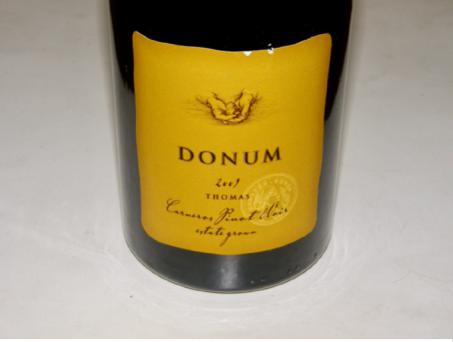 2009 Donum Estate Thomas Carneros Pinot Noir 14.4% alc., 101 cases, $100. This bottle honored Thomas Ferguson’s 100th birthday. 100% de-stemmed, native primary fermentation, aged 16 months in 1-year-old French oak barrels. · Moderately dark garnet color in the glass. A terrific wine that defies its 11-year-old age, drinking like a new release but with pliant tannins and oak faded into the background. Bold dark fruits, brown spices, anise and leather are featured on the nose and palate. A robust wine that seduces with a mouthfeel that is smooth as a baby’s bottom. An appropriate memorial to Thomas. Score: 94
Filigreen Farm This 97-acre vineyard, garden, and orchard in the town of Boonville in Anderson Valley is Demeter-certified Biodynamic property that was donated to the Yggdrasil Land Foundation in 2000 and leased to Filigreen Farm, LLC, a partnership between Lisa Bauer and vintner Alex Crangle. The original head-trained and dry-farmed planting of French Colombard on St. George rootstock was done for Italian Swiss Colony in 1946. In 1990, 8 acres were grafted over to Pommard. The 17-acre vineyard is now home to Pinot Noir, Chardonnay, and Pinot Gris. There are Dijon clones 115, 667 and 777 in addition to the Pommard. Wineries that have produced Pinot Noir from this vineyard include Crosby Roamann, Panthea Winery & Vineyard, Tessier, and Yamakiri.
2018 Crosby Roamann Old Saint George Filigreen Farm Anderson Valley Pinot Noir 14.2% alc., 134 cases, $ not released. Pommard clone grafted onto aged St. George rootstock. Produced and bottled by Sean W. McBride. 50% whole cluster, indigenous yeast fermentation, pressed at 17 days entirely by hand in an old hand-crank press. The wine was aged 12 months in French oak Barrels, 50% new. Bottled unfined and unfiltered. · Moderately light garnet color in the glass. Delicate but seductive aromas of fresh red cherry and berry with just a hint of oak. Light to mid-weight in style featuring a fresh core of red fruits framed by a modicum of integrated oak. The tannins are restrained, showing up only slightly on the long and juicy finish. There is a good acid vibe that adds to the refreshment. Score: 90
Hirsch Vineyard David Hirsch acquired a 1,100-acre property near Fort Ross in Cazadero in 1978. A winegrower friend, Jim Beauregard, suggested that the site’s 1,500-foot-high ridges might be ideal for Pinot Noir and that intrigued David who was a fan of Burgundy wines. He planted two acres of Pinot Noir and Riesling in 1980, adding more plantings of Pinot Noir from 1990 through 2002 to bring the total to 64 acres of Pinot Noir and nearly 4 acres of Chardonnay. Iron Horse The original Iron Horse Vineyard was planted to Pinot Noir and Chardonnay between 1971 and 1973 by winemaker Rodney Strong who established 55 acres each of Pinot Noir and Chardonnay. The property, located in the Green Valley of Russian River Valley, was purchased by Berry and Audrey Sterling in 1976. They had moved to France in 1967 and their travels to various wine regions sparked the idea of living on a vineyard, growing grapes, and making wine. The vision was always a chateau model dedicated to producing estate-bottled wines. Their first Pinot Noir was released in 1979, a date that marked Barry’s 50th birthday and coincided with the opening of the winery. Sparkling wines arrived the following year. Iron Horse was named after a railroad stop that crossed the property in the 1890s. The winery is most renowned for its sparkling wines and that is largely related to the accomplishments of the first winemaker and vineyard manager, Forrest Tanzer. Iron Horse vintage Blanc de Blancs sparkling wine was served at the Reagan-Gorbachev Summit Meetings that ended the cold war, a White House tradition that has continued for 35 years. Currently, there are about 160 acres planted to Pinot Noir and Chardonnay divided into 39 blocks that are farmed individually, harvested separately, and then vinified as a single vineyard. From 2005 to 2012, 82 acres originally planted in the early 1970s were replanted. Barry Sterling passed away on July 26 2020, but his family continues to manage the vineyards and winery. Lafond Winery & Vineyards Pierre Lafond opened the first winery in Santa Barbara County since prohibition in 1962. In 1971, Lafond planted his first 65 acres in the Sta. Rita Hills. In 1982, Lafond acquired cuttings from the Sanford & Benedict Vineyard and planted the “Martin Ray clone’” on its own roots in the Lafond Vineyard. The 2016 Lafond Vineyard Martin Ray Clone Sta. Rita Hills Pinot Noir ($50) is the final vintage, as production had declined due to nematode infestation and extended drought. Replanting is underway with UCD 37. Visit www.lafondwinery.com Lee Vineyard Ira and Shirley Lee planted this vineyard in 1967 and formed a relationship with Saintsbury. This relationship was instrumental in the replanting of the vineyard in the 1990s and early 2000s with Dijon and Pommard clones and Swan selection. Mahoney Ranch Francis Mahoney purchased land in Los Carneros in 1972 with partner Belfour Gibson and spouse Kathleen, and began building the Carneros Creek Winery in 1973, the first new winemaking facility in Carneros since the repeal of Prohibition. He planted about 7 acres of several clones of Pinot Noir as well as an experimental plot of Pinot Noir which became the Carneros Creek Clonal Trial. Francis was unique among Pinot Noir pioneers of the 1970s in that he realized that beyond climate and soil, clones were an important factor in the success of California Pinot Noir. Between 1975 and 1985, experiments were conducted by Francis and UCDavis professor and viticulture specialist Curtis Alley on a 1.5-acre plot planted to various clones. The Trial was meant to compare clones from UCDavis (so-called ‘clean-stock’) with clones not sourced from UCDavis. Refer to the previous discussion of the Martini clones 13 and 15. Phase 2 and 3 of the Trial followed. During the 1980s and 1990s, Francis planted the Mahoney Ranch Vineyard surrounding his residence and the Las Brisas Vineyard. In 1998, he sold his majority share in Carneros Creek Winery and the winery passed through several hands. Mahoney then founded Mahoney Vineyards Today, Mahoney Vineyards produce Pinot Noir from the Las Brisas Vineyard (multiple clones including UCD 12, 13 23, 18, and 29 as well as Chalone, Hanzell and St. Claire), the Mahoney Ranch Vineyard UCD 12), Swan and UCD 23) and the Haire Ranch Vineyard. McHenry Vineyard Dean McHenry, the founding chancellor of UC Santa Cruz planted Pinot Noir in 1972 in the Boony Doon subregion of the Santa Cruz Mountains. The site is 5 miles from the Pacific Ocean on a sandy mountain slope at 1,800 feet elevation. Dean’s son, Henry McHenry, used the fruit to produce McHenry Vineyard wines. Unfortunately, the 2.5-acre vineyard was devastated by Pierce’s Disease and ceased production in 1992. It was replanted in 1997 to Pommard, Martini 13, Dijon 115 and a Swan selection. After the replanting, I reviewed a number of the McHenry Vineyard Pinot Noirs beginning in 2003 and found them very elegant and charming and extremely reasonable in price considering the quality. Today, Henry’s daughter Annie McHenry, her husband Brandon Blanchard and her cousin Ian McHenry are in charge. Mount Eden Vineyard Martin Ray planted Pinot Noir, Chardonnay and Cabernet Sauvignon at this historic vineyard in 1945 and founded his namesake Martin Ray Winery here in the early 1950s. The Mount Eden Pinot Noir original plantings were brought to California from Burgundy in the 1890s by Paul Masson, who reputably was given the scion material from Corton and Corton Charlemagne by Louis Latour’s father. The grape scion was probably supplied to Chalone, the HMR Vineyard, and many others. This vineyard is a viticultural island perched at 2,000 feet above sea level in the Santa Cruz Mountains. The grapes are planted in infertile Franciscan shale on a cool, exposed hilltop. Partners acquired the Martin Ray property in 1972, renamed the property Mount Eden Vineyards, and released their first Pinot Noir from 29-year-old vines. Jeffrey Patterson assumed control of Mount Eden Vineyards in 1981 and has been the winemaker ever since, a remarkable longevity for a California winemaker. Mount Eden’s lineage of estate bottled Pinot Noir and Chardonnay is the longest in California. Replanting of the 34-acre vineyard began in 1984 with about 20% of the vines propagated from the original budwood and the rest planted to Winery Lake, Swan and Calera selections, and Dijon clones 115, 667, 777, and “828.” Since 1984, the Estate Pinot Noir has been a mosaic of all of these clones. Merry Edwards, the winemaker at Mount Eden from 1974 to 1976, sent cuttings of a single Mount Eden vine (“Ray selection”) to UC Davis where it was registered as UCD 37 in 1977. Nielson Vineyard Uriel Nelson and Bill De Mattei planted Pinot Noir among more than 100 acres of vineyards on the Tepusquet Bench in the Santa Maria Valley in 1964. This was the first commercial vineyard in Santa Barbara County. It became part of Byron Vineyard & Winery and was replanted to multiple clones by Ken Brown while during his stint as the winemaker at Byron beginning in 1991. Nobles Ranch Vineyard Owner Marvin Nobles planted this 33-acre vineyard on the West Sonoma Coast in what is now the Fort Ross-Seaview AVA on land that had been lifted up from ancient sea beds to between 850 and 1,500 feet above sea level. The vineyard is on the eastern slopes of the second mountain ridge in from the Pacific Ocean. 3.5 acres were planted nearly 40 years ago to Martini clone and Dijon 777 clone were added 25 years ago. Soils are Goldridge sandy loam. Grapes have been sold to Morlet Family Vineyards (bottled as “Coteaux Nobles” and “Joli Coeur”), Davies Vineyards, and B.Wise Vineyards. Paragon Vineyard Jack Niven pioneered wine grape growing particularly Pinot Noir and Chardonnay in the Edna Valley beginning in 1973. This region, a mere 5.4 miles from the Pacific Ocean, is one of the coolest growing regions in California. One of the first and oldest continually producing vineyards in the region, early plantings spanned 547 acres and 11 varieties. Phil Woodward of Chalone Vineyard brokered a deal with Niven’s Paragon Vineyards as a partner that became Edna Valley Vineyard. Today, the Niven family farms 1,200 acres of continuously updated plantings with two-thirds of production going to Edna Valley Vineyard and the rest to Niven brands including Baileyana. I know of no old vines bottlings. Poppy Hillside Vineyard was originally established in the Santa Lucia Highlands in 1972 and now consists of 200 acres of old Estate Pinot Noir (60 acres) and Chardonnay (140 acres). Current status of original plantings not available. No old vine Pinot Noir produced. Rapley Trail Vineyard Dr. Thomas Fogarty purchased 325 acres of land on Skyline Drive in Woodside in the early 1970s and established the Thomas Fogarty Winery. The Damiana Vineyard (1978), the Langley Hill Vineyard (1979) and the Portola Springs Vineyard (1980) were planted to Wente clone Chardonnay on AxR1 rootstock. The 6-acre, less-elevated vineyard, at 1,650 feet, named Rapley Trail, was planted in 1982 with Martini clone on AxR1 rootstock. Longtime winemaker, Nathan Kandler told me that all six acres of the original Rapley Trail Vineyard is producing. Bottlings from this vineyard, including the Rapley Trail Vineyard and the two Rapley Trail Block wines, James Thomas Block (formerly the M Block) and Henry Aryton’s Block (formerly the B Block), have been produced and in the past reviewed at www.princeofpinot.com/winery/388/. For availability, visit www.fogartywinery.com River Ranch Vineyard Camille and Ed Penhoet, owners of Toyon Farm Vineyard in Napa Carneros, planted this vineyard in Carmel Valley in 1982 to “special cuttings of distinguished origin,” that reputedly came from a prestigious vineyard in Burgundy in the 1970s and subsequently brought to California. The Ancien Wines website states that the cuttings at both River Ranch Vineyard and Toyon Farm Vineyard in Carneros came from a famous vineyard in Burgundy and also were the original source of Pinot Noir for the Pisoni Vineyard (the so-called Pisoni clone or River Ranch selection). I asked Jeff Pisoni about this history and he told me that Gary Pisoni has always affirmed that he sourced his own wood, whether or not it was as colorful a story as Gary describes, via underwear, so there is no connection to River Ranch Vineyard. Ancien produced a 2018 Carmel Valley River Ranch Pinot Noir in 2018 (second vintage) and is reviewed here. Visit www.ancienwines.com
2018 Ancien Carmel Valley River Ranch Pinot Noir 14.5% alc., 97 cases, $60. Aged 11 months in French oak barrels with a single racking carried this wine gently to bottle. · Dark garnet color in the glass. Ripely fruited aromas of plum, cassis and boysenberry lead to a mid-weight plus styled wine replete with layers of purple and black fruits backed by modest toasty oak. Rich, but not too rich, and velvety in mouthfeel, with easygoing, silken tannins and some finishing length. There is a slight sense of alcohol on the palate. Score: 92
Roudon Smith Vineyard Bob and Anna Maria Roudon and Jim and Sue Smith bought this vineyard land in the Scott’s Valley region of the Santa Cruz Mountains in 1972. They planted Pinot Noir and Chardonnay shortly thereafter, and built a winery in 1978. The winery was sold in 2005 as the owners retired. The vineyard was sold separately and the owner gave it to his wife in a divorce. She let it go somewhat fallow. Currently, Phil Crew, owner and winemaker of Pelican Ranch Vineyard is leasing the vineyard that is in a “semi-active” state. Sangiacomo Southern Sonoma, Home Ranch and Palmer Wedekind Vineyards These three vineyards are located in the Carneros and Sonoma Coast AVAs and are all planted to Pinot Noir, Merlot and Chardonnay. All of these sites were fruit tree farms originally managed by the Sangiacomo family. Southern Sonoma Vineyard was planted beginning in 1974, while Home Ranch Vineyard and Palmer Wedekind Vineyard were first planted in 1980. Steve Sangiacomo told me that they do not have any Pinot Noir in the ground planted prior to the 1980s as “viruses were too prevalent so we had to replant the Pinot Noir.” The oldest producing Pinot Noir vines were planted in 1997. Sangiacomo Family Vineyards do still have Chardonnay planted in 1969 (the first block they ever planted). Steve noted, “Chardonnay can handle viruses better than Pinot Noir.” The Sangiacomo's launched their own Sangiacomo Family Vineyards brand of Chardonnay and Pinot Noir with the 2016 vintage. Santa Cruz Mountain Vineyard This property in the Vine Hill District of the Santa Cruz Mountains was originally established in 1863 as the Jarvis Brothers Vineyard. David Bruce acquired the vineyard in 1968, pulled out the Zinfandel planted by the previous owners, the Pesenti-Locatelli family, and planted it to the Wente selection of Pinot Noir on its own roots. Ken Burnap acquired the 26-acre vineyard in 1974, renaming it Santa Cruz Mountain Vineyard and founded the winery by the same name shortly thereafter. For years, this vineyard was one of the oldest continuously operating vineyards in California. In 1979 Ken hired Jeff Emery as his apprentice and by the time Ken retired in 2002, Jeff had taken over the day-to-day business operations and winemaking. In the summer of 2004, Ken sold the vineyard property to an investment group that renamed it Vine Hill Vineyard. produced wines under the Vines of Vine Hill umbrella, and replanted the original Santa Cruz Mountain Vineyard. The winemaking operations and inventory of Santa Cruz Mountain Vineyard moved with Jeff to a location on the west side of the City of Santa Cruz where Jeff still produces wines under the Santa Cruz Mountains label. The last vintage from the original plantings was 2004. Although Wines of Vine Hill made a serious attempt to carry on the storied legacy established by this historic property, the winery was forced to close in 2012. Santa Cruz Mountains Vineyard is now named the Union Vineyard and associated with the brand US Grant. Sarah’s Vineyard This vineyard is planted at a unique site on Hecker Pass Highway in Gilroy. The first Pinot Noir was planted here in 1979. In 1989, a “proprietary clone” of Pinot Noir was imported and the original vines grafted over. The original Pinot Noir block was removed in 2012 for replanting but current owner Tim Slater took cuttings and has maintained a small, unmarked, super-secret patch of that proprietary clone among some of the newer plantings. Tim says, “It is a matter of vineyard pride.” Those grapes are part of the Estate blend. Tim has added blocks of Pinot Noir from 2001 to 2016 and currently has the following clones planted: 115, 667, 777, “828,” 943, Swan, Calera and Pommard. Schug Carneros Estate Vineyard Schug Carneros Estate Winery has been family-owned and operated since 1980. The first estate-grown Pinot Noir was released in 1983. Walter Schug planted and studied clonal selections of Pinot Noir that had a proven track record in European vineyards as well as some selections from California. He used his vineyards as a laboratory and teamed with UC Davis to do a 12-year intensive clonal research project. Sierra Madre Vineyard First planted in 1971, this 151-acre vineyard is located near the western edge of the Santa Maria Valley. Varieties include Pinot Noir, Chardonnay, Pinot Blanc, and Pinot Gris established in low vigor sandy loam soil. Farming veterans Jan and Doug Circle and their family were proprietors from 2013 to 2018, then sold the vineyard to an affiliate of E. & J. Gallo Winery who bought all 542 acres of the property. Grapes have been supplied to more than 35 wineries. The vineyard was replanted and is still undergoing replanting. Sleepy Hollow Vineyard First planted in 1972, this vineyard is one of the first if not the first vineyard planted in the Santa Lucia Highlands. The initial planting of Pinot Noir was Martini 13. This vineyard, one of the most northernmost and coldest in the Santa Lucia Highlands, was acquired by Robb Talbott of Talbott Vineyards in 1994 from Jerry McFarland who had originally planted the vineyard. Today, the vineyard, home to Pinot Noir and Chardonnay, and marketed as a “Grand Cru Vineyard,” spans 565 acres divided into three vineyard parcels. About one-third of the vineyard is planted to Pinot Noir clones that include Dijon 113, 114,115, 667, 777, “828,” 943, Mount Eden 37, Pommard 4 and FPS 66 (a Martini clone and the same source as Martini 13) and FSP 96 (same source material as Calera clone, originally from Chambertin, France). E. & J. Gallo purchased the Talbott wine brand in 2015. There is no old vines bottling. St. Clair Vineyard Originally planted in 1973 to a field selection from Los Amigas Vineyard, fruit from this vineyard was a consistent source for Acacia Winery, started by Michael Richmond and winemaker Larry Brooks in 1979. Owned and farmed by Jim St. Clair, this vineyard became heavily virused but was in production until the mid-2000s according to John Haeger (Pacific Pinot Noir - 2008). Stanly Ranch Vineyard Judge John Stanly’s Riverdale Ranch, located south of Napa in Carneros, produced wines from more than 300 acres in the late 1800s. Phylloxera had devastated all the vineyards in Carneros by the 1920s but Stanly Ranch was planted on Vitis riparia rootstock that was resistant to phylloxera and some vines survived. Andre Tschelistcheff and Louis M, Martini both bought grapes including Pinot Noir from the Stanly Ranch in the 1930s. Martini eventually owned 200 acres of the Stanly Ranch and along with Harold Olmo, a UC Davis professor, did extensive Pinot Noir and Chardonnay clonal trials leading to the development of Chardonnay clone 108 and UCD clones 13 and 15 of Pinot Noir. These clones were widely planted in California from the 1970s to the early 1990s. More recently, the Stanly Ranch Estate Vineyard was planted in 2001 on a portion of this historic property and is owned and farmed by Starmont Winery & Vineyards (part of the Merryvale Family of Wines). The vineyard is now planted to Dijon clones 114 and 667. Three Amigos Vineyard Robert Sinskey Vineyards owns this 15-acre vineyard planted with heirloom selection cuttings from neighboring vineyards, Iund and St. Claire, in 1982. French clones were added later but as time went on they ripened too early and owners had to propagate more of the original heirloom selections (Swan, Pommard, and more). Torrey Hill Vineyard In 2012, Brian and Kerith Overstreet, founders of Bruliam Wines with the 2008 vintage, acquired the small Two Sisters Vineyard in the Russian River Valley that had old plantings of Martini clone of undetermined age. There are rumors that date the original vines to 1953-1955, but this is highly unlikely and Kerith thinks it is most likely the vines were planted in the late 1960s. The vineyard has been named Torrey Hill paying homage to the Torrey Pine, an endangered tree species found in La Jolla where the couple attended high school. In 2015, major replanting and rehabilitation of the vineyard began, including interplanting 2000 new vines and re-training with guyot canes and tight 3’ x 4’ spacing. Kerith has told me about 25% of the supposed original vines have been preserved and are still producing grapes. The Adrian Fog Winery produced a Two Sisters Vineyard designated Pinot Noir in the early 2000s. The current release from this vineyard is the 2017 Bruliam Torrey Hill Russian River Valley Pinot Noir. Ventana Vineyard This vineyard was planted to a Mount Eden selection in the Arroyo Seco AVA of Monterey County in 1974 by Doug Meader who also founded Ventana Vineyards in 1978, one of the pioneering wineries of Monterey County. Today, the vineyard spans 300 acres. Ventana Vineyards owners partnered with the Folktale Wine Group in 2017 to revitalize the property. Ventana Vineyard is tended by Steve McIntyre of Monterey Pacific who has brought innovative sustainable farming practices to the vineyard. Wiley Vineyard Brad Wiley, owner of Wiley Vineyards, first planted his vineyard in 1972, making it one of the earliest plantings in the Anderson Valley. He ripped the land in 1971 and planted the next year, following the Anderson Valley plantings at Edmeades and Husch and preceding the vineyards at Lazy Creek and Navarro Vineyards. Brad’s family started the publishing company, John Wiley & Sons. He owns a total of nearly 200 acres of conifer forest and fruit trees including the vineyard. The vineyard is located on a ridge-top above the fog line at the extreme northern end of the Anderson Valley only 10 miles inland from the coast making it one of the most westerly vineyards in the Anderson Valley. Planting was initiated with the Stony Hill selection of Chardonnay, but the grapes would not ripen and the vines were soon afflicted with leafroll disease. Riesling was added in 1978. Pommard 5 from Erath in Oregon and a David Bruce selection were planted in 1982. Dijon clones and a Colmar clone brought to the US originally by Gloria Ferrer were added as more Pinot Noir was planted in 2000 bringing the total Pinot Noir to 20 acres. Grapes have been sold to numerous wineries including Bravium, Breggo, Briceland Vineyards, Copain, Drew Family Cellars, FEL, Harrington, Harmonique, Phillips Hill, Schramsberg, Skewis Wines, Terragena Vineyard, Witching Stick and Woodenhead Vintners. I have reviewed 28 Wiley Vineyard Pinot Noirs from various producers: www.princeofpinot.com/vineyard/348/
A Bucket List of Contemporary California Old Vine Pinot Noir
2014 Hanzell Ambassador’s 1953 Vineyard Sonoma Valley Pinot Noir $145 (last vintage 2014)* 2017 Hartford Court Arrendell Vineyard Russian River Valley Pinot Noir $100 2018 Kutch Bohan Vineyard Sonoma Coast Pinot Noir $54* 2017 Benovia Cohn Vineyard Sonoma County Pinot Noir $80 2000 Kalin Cellars Cuvée DD Sonoma County Pinot Noir $40 2016 Tulocay Haynes Vineyard Napa Valley Pinot Noir $40 2017 Ancien Coombsville - Haynes Old Block Napa Valley Pinot Noir $68. 2014 Ceritas Old Shop Block Hellenthal Vineyard Fort Ross-Sea View Pinot Noir $72* 2016 Olivet Lane Vineyard Russian River Valley Pinot Noir $60 2018 Williams Selyem Olivet Lane Vineyard Russian River Valley Pinot Noir $78* 2018 Merry Edwards Olivet Lane Vineyard Russian River Valley Pinot Noir $72 2017 Lynmar Estate Old Vines Quail Hill Vineyard Russian River Valley Pinot Noir $82* 2016 Porter Creek Hillside Vineyard Russian River Valley Pinot Noir $72 2018 Williams Selyem Precious Mountain Vineyard Sonoma Coast Pinot Noir $105 2016 Gundlach Bundschu Heritage Selection Russian River Valley Pinot Noir $65* 2015 School House Vineyard Napa Valley Pinot Noir $70 2016 School House Vineyard Napa Valley Pinot Noir $65 2018 Rivers-Maria Summa Old Vines Sonoma Coast Pinot Noir $85* 2017 Husch Vineyards “Knoll” Anderson Valley Pinot Noir $42. 2018 J. Rochioli Vineyards & Winery Three Corner Vineyard Russian River Valley Pinot Noir $90 2018 J. Rochioli Vineyards & Winery West Block Russian River Valley Pinot Noir $120 2017 Truchard Old Block Carneros Pinot Noir $65 2018 POE Van Der Kamp Vineyard Sonoma Mountain Pinot Noir $45 2018 Dutton-Goldfield Van Der Kamp Vineyard Sonoma Mountain Pinot Noir $68 2017 Big Basin Vineyards Ferrari Vineyard Santa Cruz Mountains Pinot Noir $60* 2018 Lightpost Winery Ferrari Vineyard Reserve Santa Cruz Mountains Pinot Noir $69 2018 Arnot-Roberts Legan Vineyard Santa Cruz Mountains Pinot Noir $60 2018 Arnot-Roberts Peter Martin Ray Vineyard Santa Cruz Mountains Pinot Noir $75 2017 Alfaro Family Vineyards & Winery Trout Gulch Vineyard Santa Cruz Mountains Pinot Noir $45 2016 Windy Oaks Estate Winery Old Vine Chalone Pinot Noir $65 2014 & 2015 Birichino Antle Vineyard Monterey County Pinot Noir $40 2018 Brosseau Wines Old Vines Brosseau Vineyard Chalone AVA Pinot Noir $53 2014 McIntyre Old Vines McIntyre Estate Vineyard Santa Lucia Highlands Pinot Noir $65 2018 Sostener Santa Lucia Highlands Pinot Noir $18.95 2016 Seabold Paraiso Vineyard Santa Lucia Highlands Pinot Noir $40 2017 Birichino Enz Vineyard Monterey County Pinot Noir $40 2016 Bonny Doon Vineyard Enz Vineyard Cienega Valley Pinot Noir $38 2016 Calera Jensen Vineyard Mt. Harlan Pinot Noir $95 2016 Calera Reed Vineyard Mt. Harlan Pinot Noir $75 2015 Calera Selleck Vineyard Mt. Harlan Pinot Noir $95 2018 Adelaida HMR Estate Vineyard Adelaida District Paso Robles Pinot Noir $60 2014 Bien Nacido Estate Old Vine Santa Maria Valley Pinot Noir $100 2017 Gary Farrell Bien Nacido Vineyard Santa Maria Valley Pinot Noir $70 2016 Scar of the Sea Bien Nacido Vineyard Q Block Santa Maria Valley Pinot Noir $70 2017 Tyler Bien Nacido Vineyard - N Block Santa Maria Valley Pinot Noir $70 2016 Au Bon Climate Historic Vineyards Collection Sanford & Benedict Vineyard Sta. Rita Hills Pinot Noir $50 2014 Sanford Founders Vines Sanford & Benedict Vineyard Sta. Rita Hills Pinot Noir $115 * Available only through the winery’s mailing list allocation or wine club.
Heritage Clones of Pinot Noir
In 1952, Dr Harold Olmo, a UC Davis faculty member in the Viticulture and Enology Department, formed the California Grape Certification Association to find, maintain and distribute correctly labeled grape stock that had been thoroughly virus-tested and chosen for vigor and fruitfulness. By 1958, the program was combined with the UC Davis disease-tested fruit and nut program to become the Foundation Plant Materials Service (FPMS). In 2003, “Materials” was dropped and the name shortened to Foundation Plant Service (FPS). This was the first source of virus tested, certified stock available to winegrowers in the United States. From the early 1950s until 1988, most of the grapes imported legally into the United States were controlled by UC Davis. The FPMS program at UC Davis was in hiatus from 1989 until 1993 when the National Grapevine Importation and Clean Stock Facility was opened at FPMS and imports into UC Davis were resumed thereafter. Some of the information below was obtained from a chapter on Pinot cultivars in a book titled Grapes of the United States by Nancy L. Sweet, FPS historian at UC Davis and posted on the FPS website August 18, 2020, at https://fps.ucdavis.edu/grapebook Note: Clonal designations can vary in the wine literature. For example, the Martini clone 13 can also be referred to as Pinot Noir 13 (as it is in the FPS catalog), PN 13, FPS 13, UCD 13, or even simply 13.
Wädenswil clones (UCD 1A, 2A) came from six cuttings of Blauer Burgunder (Swiss for Pinot Noir) acquired by Olmo for UCDavis from a research station for viticulture in Wädenswil, Switzerland in 1952. Originally known as 01A, 02A and 03A, and as the "Wädenswil clones.” 03A was from the same vine as 02A but was dropped due to leaf roll virus. 1A and 2A were registered and certified by FPMS in 1962 and thereafter became much more widely planted in Oregon than California.
During the 1970s, there was widespread interest in clonal diversity, and John Haeger (North American Pinot Noir, 2004) notes, “A wave of interest in clonal selection swept through the pinot-oriented winemaking communities in both states” (California and Oregon). While the FPMS was concerning itself primarily with screening, testing and certifying grape stock, winegrowers were interested in the diversity of clonal material being investigated and available in France. This led many early California winegrowing pioneers to surreptitiously hand-carry select Pinot Noir cuttings from Burgundy into the United States. Since the cuttings were often wrapped in wet newspaper and put inside a suitcase, they became known as “suitcase” or “Samsonite” clones. Winemaker Tony Soter (noted winemaker at Etude in Carneros and now Beacon Hill in the Willamette Valley), who had a special interest in heritage or heirloom clones would remark years ago, “Among men and women who consider themselves Grail-seekers of Pinot Noir, it is understood that smuggling is part of the tradition.” The illicitly imported Pinot Noir grapevine cuttings were field selections but eventually became the so-called “heritage clones” including Martini, Wente, Mount Eden, Swan, Calera, and Hanzell and noncertified “clones” known in the vernacular as David Bruce, Chalone and Pisoni in California and Coury and faux 828 in Oregon. The smugglers were reluctant to admit their transgressions so the lineage of these selections in most cases remains a mystery. By the mid-1990s, the French threatened legal action against any Americans that used grapevine cuttings from their famous vineyards especially if their source was expressively promoted. Many rumors have arisen of suitcase material from famous Burgundy vineyards, particularly La Tâche and Romanée-Conti (so-called DRC suitcase clones), planted in California vineyards such as Chalone, Calera and Pisoni, but no one has admitted to such for fear of violating French intellectual property law, not to mention United States importation laws. That said, many California wineries and vineyards today openly tout that their vineyard(s) contain vines originating from the budwood of DRC vineyards. There are so many such claims that I sense that at least some of these assertions may be more of a marketing ploy than truth. And, realistically, the fact that the budwood came from a DRC vineyard is no guarantee it will perform well at every site in California. There is currently no DNA testing available that can identify the clone of a grapevine so the origin of these DRC selections remains a mystery.
Sometime prior to 1966, Olmo collected two Pinot Noir selections from the clonal trial vineyard. One of the two selections became Pinot Noir FPS 13 from the Martini 58 clone at Stanly Lane Vineyard. This clone was one of the first to undergo heat treatment at FPMS and was initially registered as PN 13 or Martini 13 in 1974. It was marketed by UC Davis in the 1970s as “super clone 104.” The second clone from the collection was named FPS 15 and was also registered in 1974 after heat treatment. Martini selections appeared in the 1960s but Martini 13 and 15 as an FPS clone were not widely available until the 1970s. Martini 13 proved to be much more popular. Martini 13 was also in the Carneros Creek Clonal Trial of Francis Mahoney and Curtis Alley and found to be one of the top clones grown there. A sample was submitted to FPMS planted at the FPS Classic Foundation Vineyard and released in 1999 as PN 66. Wente clone/selection. Karl H. Wente came to California from Germany in 1880. Within seven years, he had a significant winegrowing operation (47 acres) in the Livermore Valley. Sons Ernest and Herman took over the operation by 1918 and changed the name to Wente Bros. During the 1960s, Wente Bros. also established vineyards in Monterey County and soon farmed 270 acres in the Arroyo Seco region of Monterey County along with 800 acres in the Livermore Valley. The first Arroyo Seco vineyard, Riva Ranch, was planted in 1963 and became the source of the “Old Wente Clone” and the heat-treated Clone 4, both of which were eventually planted in about 80% of Chardonnay vineyards in California. The Wente brothers’ planting of Pinot Noir at Arroyo Seco in Monterey County supplied cuttings to vineyards in California during the 1970s. The Wente “clone” is probably many selections (UCD 1A, 2A, 4, 5 and 13) planted in the so-called increase block of the Riva Ranch Vineyard. Mount Eden clone (UCD 37). The original budwood was brought to California from Burgundy by Paul Masson in 1895 and planted on St. George rootstock in the Saratoga Hills at his La Cresta Ranch in 1896. The origins of Masson’s budwood is not documented but it is rumored that Louis Latour’s father gave Masson cuttings from Corton and Corton Charlemagne. Some have also speculated that the source was vineyards at Domaine de la Romanée-Conti. These vines would become the source of Pinot Noir for many other California vineyards. Martin Ray took cuttings of Pinot Noir (and Chardonnay, Cabernet Sauvignon and Riesling) most likely from nearby La Cresta to plant at Mount Eden in 1945. Merry Edwards was the winemaker at Mount Eden from 1974-1976 and in 1977 donated cuttings planted there of the “Ray clone” to FPMS. The Mount Eden clone was registered and certified in 1992 as PN 37. Prior to that, however, Mount Eden selections were dispersed throughout many California vineyards. Calera clone. (UCD 90, 96). Where did the original Pinot Noir stock at Calera come from? This is a fascinating mystery that confounds researchers to this day. It almost certainly came from Burgundy like all other heritage selections but the exact trail remains baffling despite what is stated in the FPS catalog. FPS considers the source to be from the Carneros Creek Winery clonal trial and originally from a vineyard near Chambertin, France, presumably via the Chalone Vineyard. FPS 90 underwent microshoot tip tissue therapy in 1996 and FPS 96 a few years later. Pinot Noir FPS 90 and FPS 96 and the Calera clone of Pinot Noir all originated from the same source material. John Haeger noted (North American Pinot Noir - 2004), “Chalone may have been a way station for budwood brought in from France and then transported to other California vineyards such as Calera. Or, Josh Jensen of Calera may have brought Pinot Noir scion material directly from DRC as a suitcase import, propagated them at Chalone and possibly Chalone got its cuttings from Jensen.” Still another version of the story is that the budwood brought in by Chalone never left Chalone and Josh acted independently to source his suitcase material. In his book, Heartbreak Grape, author Marq De Villiers, who knew Josh intimately, states, “Everyone cheerfully believes the rumors that Jensen’s Pinot Noir stock came directly from DRC itself, bypassing customs….Or, if not directly via Chalone.” In 1996, Francis Mahoney donated the best five industry clones from his Carneros Creek Clonal Trial to FPMS and these were designated by letters: A- Swan, E - Hanzell, M - Martini 54, P - Chalone and V - Martini 58 non-heat treated. Two clones originally from Chalone vineyard were given to the Carneros Creek Clonal Trial according to Sweet’s Grapes of the United States: (1) “Old block” planted in the 1930s of unknown origin that was not donated later to FPMS and (2) “New block” planted in 1972 with the source being Domaine Romanée-Conti in Burgundy according to Dick Graff’s brother and winegrower at Chalone, Peter Watson-Graff. Josh Jensen confirmed to FPMS Grape Program Manager Susan Nelson-Kluk in 2008 that the vines that were the source of the P clone sourced from Chalone and later submitted to FPMS by Mahoney were also the source for the industry clone known as the Calera clone of Pinot Noir. There is additional information I can offer to further cloud the mystery. In 2011, Dan Karlson, the then General Manager and Winemaker at Talbott Vineyards, who held the same position at Chalone Vineyard from 1997 to 2005 spoke with me personally. He informed me that Peter Watson-Graff told him that the Pinot Noir from Chalone was Martini, probably obtained from Wente in the mid-1940s (the problem with that is that Wente did not plant Martini 13 in California until the 1960s) or possibly Beaulieu. Dan believes that there was no suitcase “clones” at Chalone. Karlson was at Chalone when the original 1946 planted vines were pulled out, and he supervised all of the Pinot Noir replanting at Chalone which was 100% Dijon clones. Dan also commented that if it is true Chalone “harbored” some plant material for various wineries through the years, it was in very small patches that were never sold, never expanded into production blocks and are long gone. He has observed that the Martini/Chalone clones are very similar in plant material character to that he had seen in Carneros, the Russian River Valley, Santa Lucia Highlands and at Chalone. Jensen’s suitcase selections have become a legend in California wine lore and it is still not certain where the original Pinot Noir stock at Calera came from. There is no certified Chalone clone. Swan clone (UCD 97). The original plantings of Pinot Noir at Joseph Swan Vineyards came from Mount Eden. In 1967, Joseph Swan, an airline pilot for Western Airlines, acquired a run-down Zinfandel vineyard on Laguna Road in the Russian River Valley that had once been a part of the tiny town of Trenton. Swan was encouraged to plant Pinot Noir on his site in the Russian River Valley by his friend Andre Tchelistcheff. After harvesting the planted Zinfandel vines in 1968, he began a replanting of the 10-acre vineyard in 1969 to Pinot Noir, Chardonnay and Cabernet Sauvignon that would become Trenton Estate Vineyard. The original Pinot Noir field selection was from Mount Eden. but since Swan was such a fan of Burgundy and traveled there often, it is thought that he had a few vines as well that originated directly from cuttings in Burgundy that were gifted to him. A second block of Pinot Noir was added in 1974. The scion material that entered the Carneros Creek Clonal Trial as Clone A came from Pinot Noir vines at the UC Davis experimental plot at the Oakville Viticulture Field Station in 1959, and these Pinot Noir vines, in turn, came from Joseph Swan Vineyards. These were a Mount Eden selection although it is not certain that they were the same as the Mount Eden clone UCD 37. The resulting vine mix was eventually named the Swan clone by Francis Mahoney, who submitted cuttings from the Carneros Creek Clonal Trial to FPMS in 1996. The plant material then underwent microshoot tissue culture therapy in 1997 and was registered as FPS 97. A second version of the Swan clone was derived from Dehlinger Winery in Sebastopol. Winemaker Eva Dehlinger submitted cuttings to FPS that became FPS 141.1.
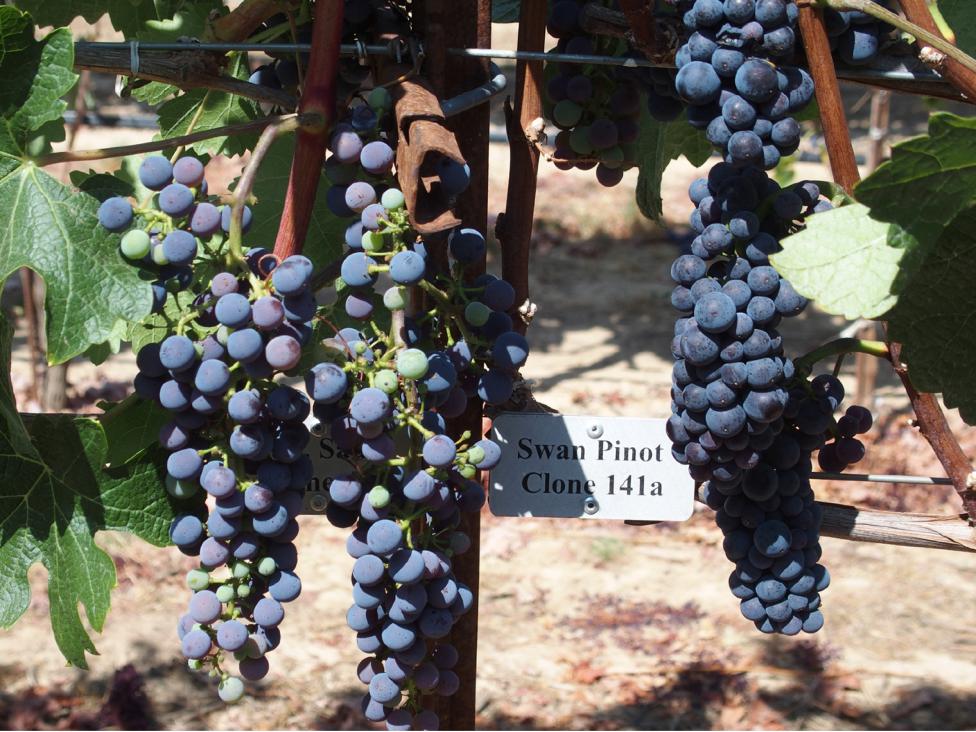
Hanzell clone (UCD 108) According to the FPS website, this Pinot Noir was clone E from the Carneros Creek Winery Clonal Trial and originally came from the Gustav Niebaum/John Daniel/ Inglenook Estate in the Napa Valley. From there it went to the Oakville Viticulture Field Station and then to the Stelling vineyard across the street from the field station. Zellerbach got budwood from the Stelling vineyard and budded to vines at Hanzell Vineyard in Sonoma in 1953. Clone E in the Carneros Creek Clonal Trial was donated by Hanzell Vineyard and subsequently sent to FPMS in 1996. The clone was registered and certified after microshoot tip tissue culture therapy at FPS in 1997 and released in 2004 as FPS 108. A second version of the source of the Hanzell clone was described in Sweet’s Grapes of the United States. She reported that in 1949, Martin Stelling and Ivan Schoch, owners of the Stelling vineyard that was located near the UC Davis Oakville Viticulture Field Station, collected cuttings of 30- to 45- year-old vines from an old section of Masson’s La Cresta Vineyard. Schoch then budded over 20 acres at the Stelling vineyard in 1949. The original Hanzell vineyard budwood then came from these plantings. It has become clear over the past fifty years is that the proper clones must be matched to the appropriate site, in other words, site trumps clones. The heritage clones are consistent performers as evidence by the Martini-based old vine Pinot Noir wines tasted for this article, but they do not necessarily meet or exceed expectations at some sites.
Drinking California Chardonnay History from Old Vine Vineyards
Most Chardonnay vineyards were uprooted during Prohibition when growers replaced them with thick-skinned red varieties that could be shipped cross country. Small plantings of Wente Chardonnay survived Prohibition, and after Prohibition, Ernest and Herman Wente took over the family business and developed the Wente Chardonnay clones that completely transformed California’s Chardonnay future. Today, over 80 percent of Chardonnay produced in California comes from some version of the Wente clone. Here are just a few of the exceptional California Chardonnays I have discovered recently that were produced from vineyards planted prior to 1980.
 2017 Brosseau Old Vines Brosseau Vineyard Chalone Chardonnay 13.9% alc., $46. · Light golden yellow in the glass. Inviting aromas of grilled lemon, brioche and flint. Discreetly concentrated flavors of lemon, white stone fruits, warm brioche and smoky flint. Beautifully composed, with the slightest viscosity and bright acidity that keeps the fruit in balance. Very reserved oak treatment. Score: 93
2017 DuMOL Chloe Ritchie Vineyard Russian River Valley Chardonnay 14.3% alc., 724 cases, $65. Winemaker Andy Smith has been crafting Old Wente Chardonnay from this vineyard for 17 years. Aged 12 months in French oak barrels, 33% new followed by 6 months of settling in tank. · Moderately light golden yellow color in the glass. An opulent wine offering waves of succulent stone fruits and citrus leading to an unctuous drinking experience. That said, the wine is not overblown and has good focus and finishing citric drive. I have enjoyed many bottles of this wine over the years. Score: 95
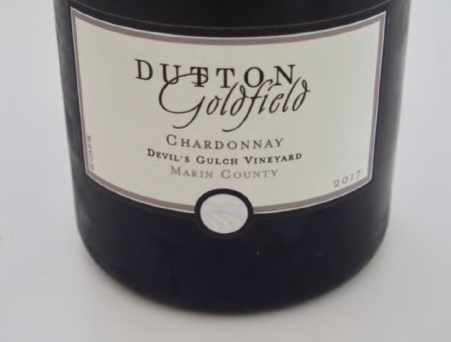 2017 Dutton-Goldfield Devil’s Gulch Vineyard Marin County Chardonnay 13.5% alc., $130 (1.5L). Sourced from a small block of Chardonnay vines planted in 1980 by winegrower Mark Pasternak. Fermented and aged on the lees in stainless steel barrels. · Pale golden yellow color in the glass. The nose will wow you with soaring aromas of golden apple, poached pear and lemon pith. Ridiculous fruit purity and energy, featuring citrus, apple and pear flavors unadorned with oak. The purest expression of Chardonnay in a very clean and crisp style with a slightly creamy mouthfeel induced by lees. A very special wine of uncommon breeding that will stun Grand Cru Burgundy (Chablis) geeks. Still wonderful when tasted the following day from a previously opened and re-corked bottle. Merci! Score: 98
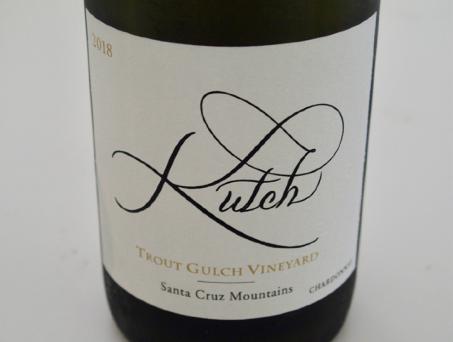 2018 Kutch Trout Gulch Vineyard Santa Cruz Mountains Chardonnay 13.4% alc., 425 cases, $49. Old Wente clone planted in 1977 in sandy loam soils at 600 feet elevation 3.5 miles inland. Whole cluster pressed, indigenous yeast fermentation, natural malolactic fermentation, minimally effective S02, and aged in French oak barrels, 20% new. · Light golden color in the glass. Seductive aromas of preserved lemon, white peach and slate. Flavors of lemon and pineapple with a hint of salinity that fan out on the palate and exit with some length. Shot through with electric acidity creating a crisp, dry and refreshing drinking experience. Still wondrous when tasted the following day from a previously opened bottle. Terrific!! Score: 96
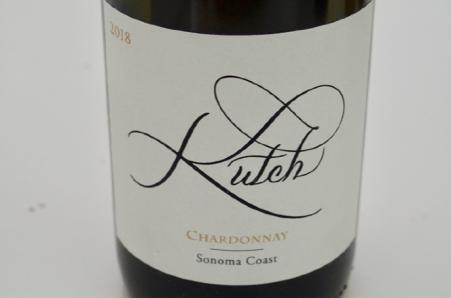 2018 Kutch Bohan Vineyard Sonoma Coast Chardonnay 13.4% alc., 350 cases, $49. Own rooted vines planted in 1972. Whole cluster pressed, indigenous primary fermentation, natural malolactic fermentation, minimally effective S02, and aged in French oak barrels, 20% new. · Light golden yellow in the glass. Reserved, but pleasing aromas of citrus, peach pit, wildflower honey and wet stone. Noticeable boldness yet discrete, with flavors of white nectarine and lemon meringue. A little more viscosity and finishing length than the Trout Gulch bottling with enough energizing acidity to satisfy. Highly enjoyable. Score: 94
Acknowledgments
Debra Paterson (Hanzell Vineyards), Jamie Kutch (Kutch Wines), Mike Sullivan (Benovia Winery), David Demostene (Demostene Ranch), Tom and Eva Dehlinger (Dehlinger Winery), Brie Cadman (Tulocay), Alexia Pelligrini (Olivet Lane Estate Vineyard), Alex Davis (Porter Creek ), Pete Soergel (Lynmar Estate), Katie Bundschu (Gundlach Bundschu), Kent Ritchie (Ritchie Vineyard), Katie Bacigalupi (Goddard Ranch), Kerith Overstreet (Torrey Hill Vineyard, Bruliam Wines), Theresa Heredia (Gary Farrell Vineyards & Winery), John M., Gantner (School House Vineyard), Zack Robinson (Husch Vineyards), Tom Rochioli (J. Rochioli Vineyards & Winery), JoAnn Truchard (Truchard Estate Vineyard), Anne Moeller-Racke (Donum Estate), Steve Sangiacomo (Sangiacomo Vineyards)Martin Van Der Camp, Claude Koeberle, Samantha Poe and Dan Goldfield (Van Der Kamp Vineyard), Mark Pasternak (Devil’s Gulch Ranch), Nathan Kandler (Thomas Fogarty Winery), Jim Schultze (Windy Oaks Estate Winery), Bradley Brown (Big Basin Winery), Jeff Emery (Santa Cruz Mountains Vineyard), Tim Slater (Sarah’s Vineyard), Bill Brosseau (Brousseau Vineyard), Jeremy Weintraub and Jude Radeski (Adelaida Vineyards & Winery - Hoffman Mountain Ranch), Gary Pisoni (Pisoni Vineyards), and Laura Ness (freelance journalist). Special thanks go out to my son, Dane Gaffney, COO of Ashes & Diamonds Winery in Napa Valley and a Sonoma County resident who tracked down many Pinot Noir wines for this issue and continues to faithfully post every issue of the PinotFile on my website. Posting took him 10 hours for this issue. He has stuck to the task for over 18 years and I am blessed to have such a good son.
References: Pacific Pinot Noir, John Winthrop Haeger, 2008 North American Pinot Noir, John Winthrop Haeger, 2004 Salud! The Rise of Santa Barbara’s Wine Industry, Victor W. Geraci, 2004 Chalone: A Journey On The Wine Frontier, W. Philip Woodward and Gregory S. Walter, 2000 Vineyards in the Sky: The Life of Legendary Vintner Martin Ray, Eleanor Ray and Barbara Marinacci, 1993 Grapes of the United States, The Pinots, Nancy L. Sweet, FPS Historian, UC Davis, 2020: fps.ucdavis.edu/grapebook UC Davis Foundation Plant Services Grapes, Grape Variety: Pinot Noir: fps.ucdavis.edu NVV Oral History Project - Napa Valley Vintners: www.napavintners.com Napa Wine Library: www.napawinelibrary.com Napa Wine Project: www.napawineproject.com/school-house-vineyard/ Historic Vineyard Society (HVS): www.historicvineyardsociety.org The PinotFile 2002-2020: www.princeofpinot.com
Identification of the Pinot Noir Cultivar and Its Clones
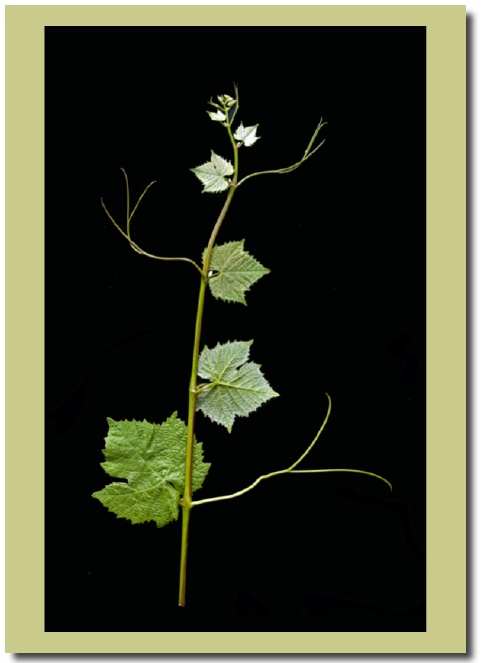 Grapevine cultivars can be identified by two methods but current techniques cannot identify a cultivar at the clone level. There are two vine identification methods: Ampelography and DNA testing. Ampelography is a visual inspection of the growing shoot tip and young leaf in the spring (see photo above of Pinot Noir from The Vitis International Variety Catalogue - VIVC), the mature leaf from flowering onwards and the cluster morphology and berry from veraison onwards. I have discussed the identification of Pinot Noir clones by cluster appearance previously at www.princeofpinot.com/article/ 1871/. DNA testing has shown its potential to identify grapevine cultivars since early 1990. For example, the Pinot Noir grape genome was sequenced several years ago using fingerprinting technology by an Italian-based multinational consortium. Identifying a vine by DNA profiling has the advantage over ampelography because ampelography is subjective and subject to morphological variability depending on site, climate, vintage and other variables. |